
- About
- Library
-
Essays
Eric Dinerstein William C. Young
- Plants
- Birds
FIELD NOTES FOR COSTA RICA
March 18-28, 2017
William Young
In March, 2017, I travelled to Costa Rica and stayed at Rancho Naturalista. I flew to San Jose and landed at noon on March 18. After clearing customs and getting my luggage, I found the driver who was taking me to Rancho Naturalista. Traffic slowed us down, but I eventually arrived at the lodge a bit before 5. The people at Rancho Naturalista gave me a quick tour. Dinner is served every night at six, and after I ate, I settled into my room (called Barbet) to rest before my first full day of birding.
When my alarm went off at 5:20 on March 19, the sun was already rising. Costa Rica is on Central Time and does not observe Daylight Savings Time, so it is two hours behind Eastern Time. I started on the veranda, and one of the first birds I saw was a Golden-winged Warbler. At 6:20, I went to an area that has a sheet with a light behind it to attract moths, and birds come to eat the moths. Breakfast at Rancho Naturalista is served at seven. The dining area is next to feeders and a small pond so that people can watch birds come in to eat, drink, and bathe. After breakfast, I went with a guide named Luis to explore the lower trails on the Rancho Naturalista property.
Lunch is served at noon, and after I ate, I hiked down the steep hill on which Rancho Naturalista is located to look at where I would be staying for the last half of my visit. A tour group from Field Guides had reserved rooms at Rancho Naturalista. The house down the hill is called Rancho Bajo, and Kathy and John Erb live there. They own Rancho Naturalista, and their daughter Lisa is Rancho Naturalista's manager. Rancho Bajo has verbena and lantana bushes near the house which attracted at least one Snowcap and a lot of other bird species. When I saw Kathy, I introduced myself. After we chatted for awhile, I hiked back to the lodge and went to a viewing platform overlooking a stream in an area called the hummingbird pools. Hummingbirds and other birds come to bathe during the late afternoon.
On March 20, I went to the moth light before breakfast and saw a lot of the same species I had seen the day before. After breakfast, I went with Luis and another couple to the base of Cerro Silencio, and we saw a lot of tanagers and warblers. While we were compiling a checklist before lunch, someone said that a Crested Owl had been found on a morning walk. Lisa took me and another couple to where the bird was perched. After lunch, I went to look at the owl again, after which I birded around the lodge. During the late afternoon, I returned to the hummingbird pools.
On Tuesday the 21st, I went to the moth light and discovered that it was not on. Still, a lot of the same birds showed up. After breakfast, I went with a guide named Harry to La Mina, which has forest, a river, and some open areas. Before getting there, we stopped at a bridge at Platanillo where a Sunbittern was on a nest. I also saw a Fasciated Tiger-Heron. After lunch, I birded around the lodge. March 22 was rainy and drizzly, and I went with Luis to an agricultural research center in Turrialba called CATIE, which stands for Centro Agronómico Tropical de Investigación y Enseñanza. CATIE has a lake with a lot of breeding herons and waterbirds. The weather was okay while we were there but deteriorated again during the afternoon, so I caught up on my field notes before dinner.
Because I was staying for ten days, Lisa offered me free transportation for one of my trips. I chose to go to the highlands to look for Resplendent Quetzals. Lisa used to be a bird guide; she does not do it any longer because she is too busy managing the lodge, but she offered to drive me up to see the quetzals. The day before we went, she asked Mercedes Alpizar Hernandez, one of the Rancho Naturalista guides, if she wanted to come with us. Mercedes is an excellent guide and was doing a big year in Costa Rica. She already had seen more than 530 species in the first few months of 2017. She has a sunny disposition which makes her a pleasure to be with. So I had two guides for the trip. We left at 5:30 in the rain to begin our three-hour drive to a lodge called Quetzal's Paradise, which is in a tropical cloud forest at 9,000 feet in the San Gerardo de Dota region. We drove most of the way in rainy and misty weather, and it was still drizzling when we arrived. In cloud forests, one frequently encounters intervals of mist and rain. The quetzals were about a ten-minute drive from the lodge, and fortunately, the weather cleared briefly while we were looking at them. The lodge also has hummingbird feeders which attracted highland species. After lunch at the lodge, we took a brief walk around some of the trails at Quetzal's Paradise, where we saw other highland bird species not found at the lower elevations around Rancho Naturalista.
We drove back toward Rancho Naturalista, and Lisa dropped me off at Rancho Bajo, where I would be staying that night. I was the only guest there. The next morning, I decided to sleep in until 6:30 before going outside to see the hummingbirds in the verbena. After breakfast, I walked up to a house where Wayne Easley lives. It is the house where Kathy and John used to live before they built Rancho Bajo. Wayne has a lot of feeders which attract birds, and I stayed there for about an hour and a half. While I was there, part of the group from Field Guides came to look at the feeders. The Field Guides leader was a pleasant man named Cory Gregory, and I told him about the birds I had seen at the feeders during the previous hour. I also joked with him about how I had been at Rancho Naturalista for five nights until his group took my room. I walked back to Rancho Bajo for lunch, and the weather front that had moved in a couple of days earlier was dumping more rain on the area. I spent the afternoon birding from the veranda at Rancho Bajo.
Throughout my stay, the food was fresh and delicious, but one thing I thought odd was that during my first five days at Rancho Naturalista, not a single banana was served with any of the meals. I try to eat a banana every day for the potassium. One afternoon after lunch, I mentioned the lack of bananas to some of the other guests and that I didn't understand why bananas are put on the feeding tables for the birds, but not on the dining tables. Mercedes was there, and she laughed. She said that Costa Ricans consider bananas cheap food, and Rancho Naturalista wants to serve better food to its guests. Rancho Bajo had bananas, so I was able to eat as many as I wanted. (One per day was enough.) I saw many different fruit trees, including trees with guavas, soursops, and red bananas. At CATIE, we saw Cannonball Trees, whose fruit look like cannonballs.
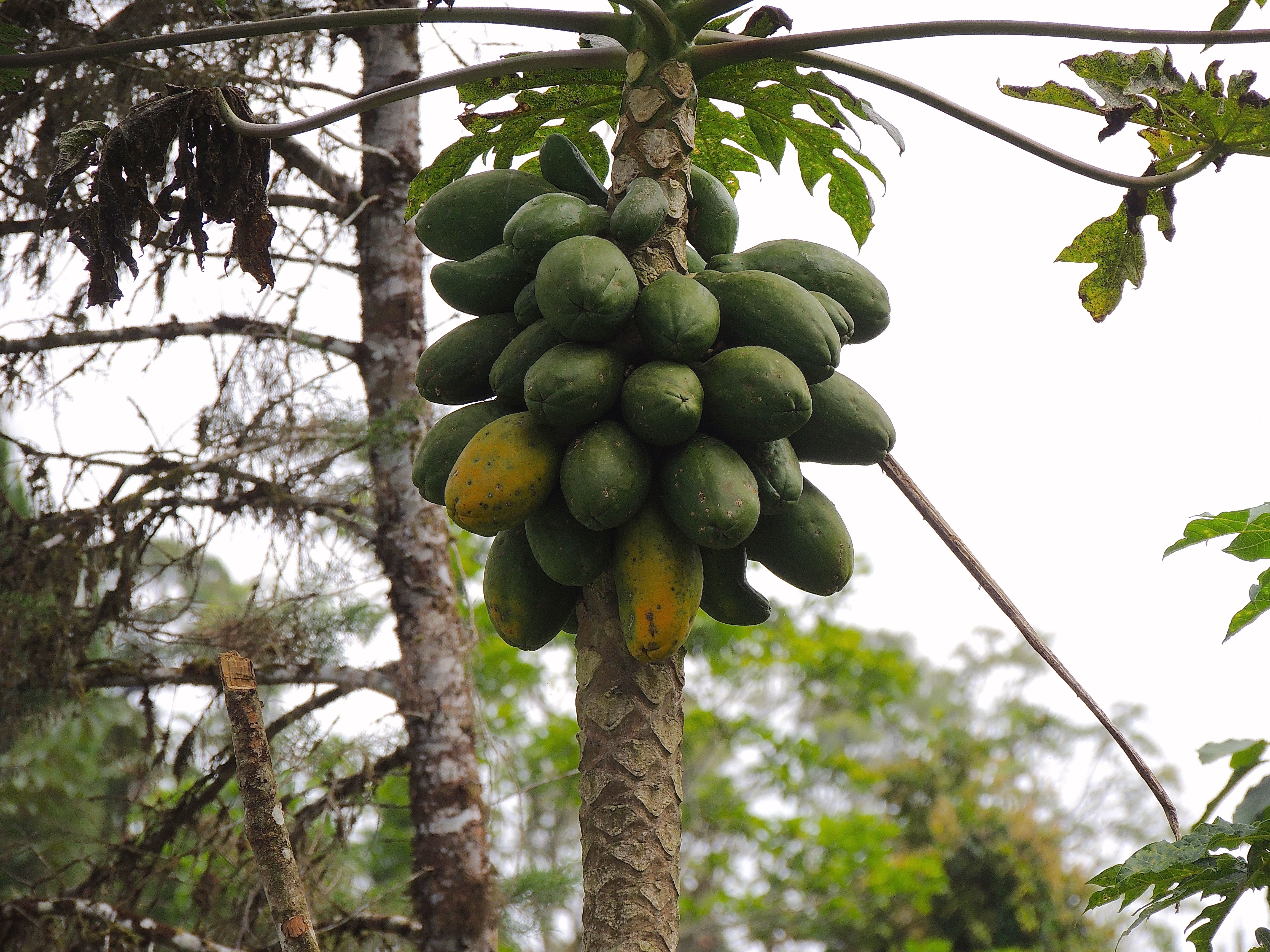 Guava Tree - Photo by William Young
Guava Tree - Photo by William Young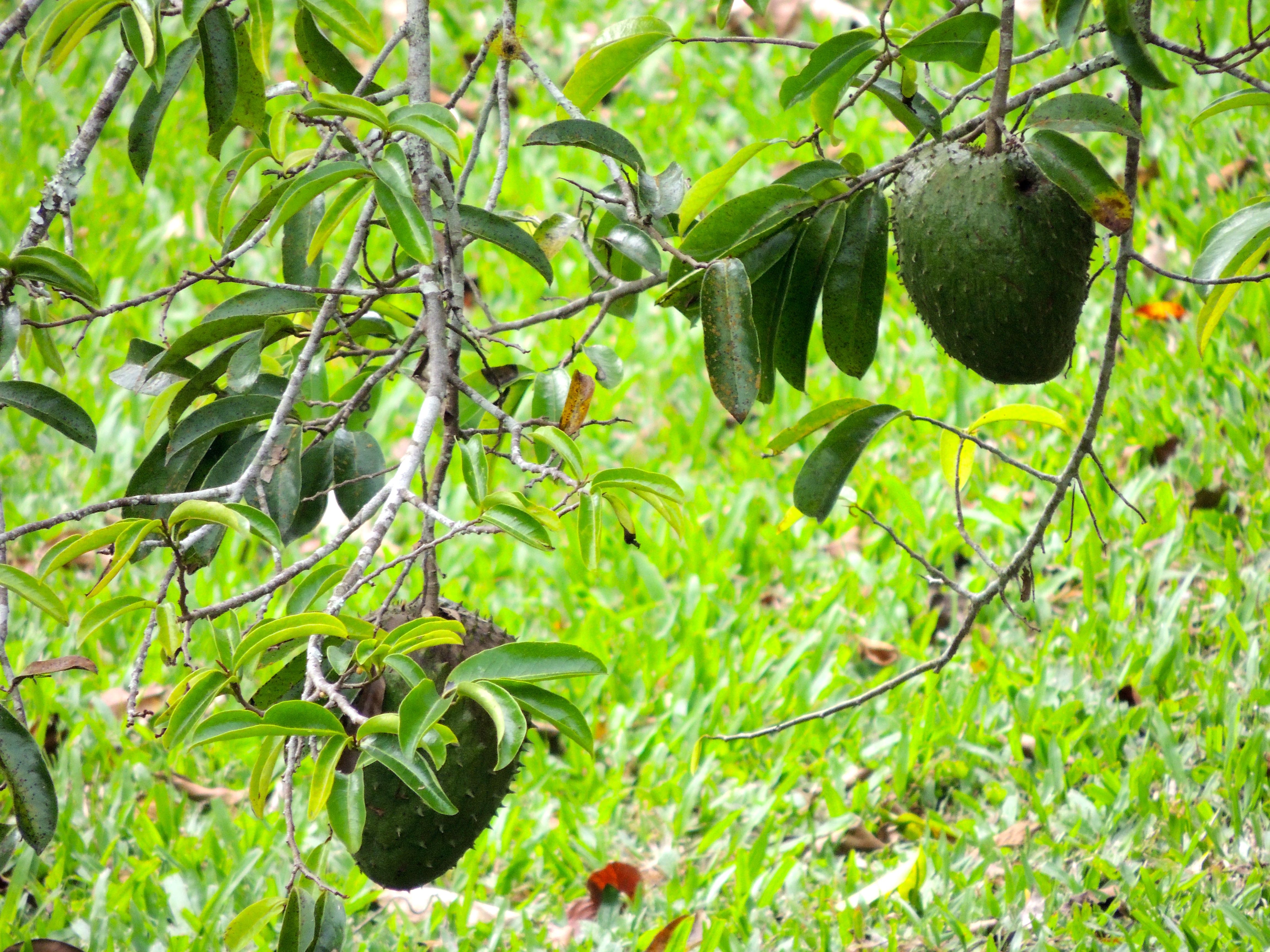 Soursop Tree - Photo by William Young
Soursop Tree - Photo by William Young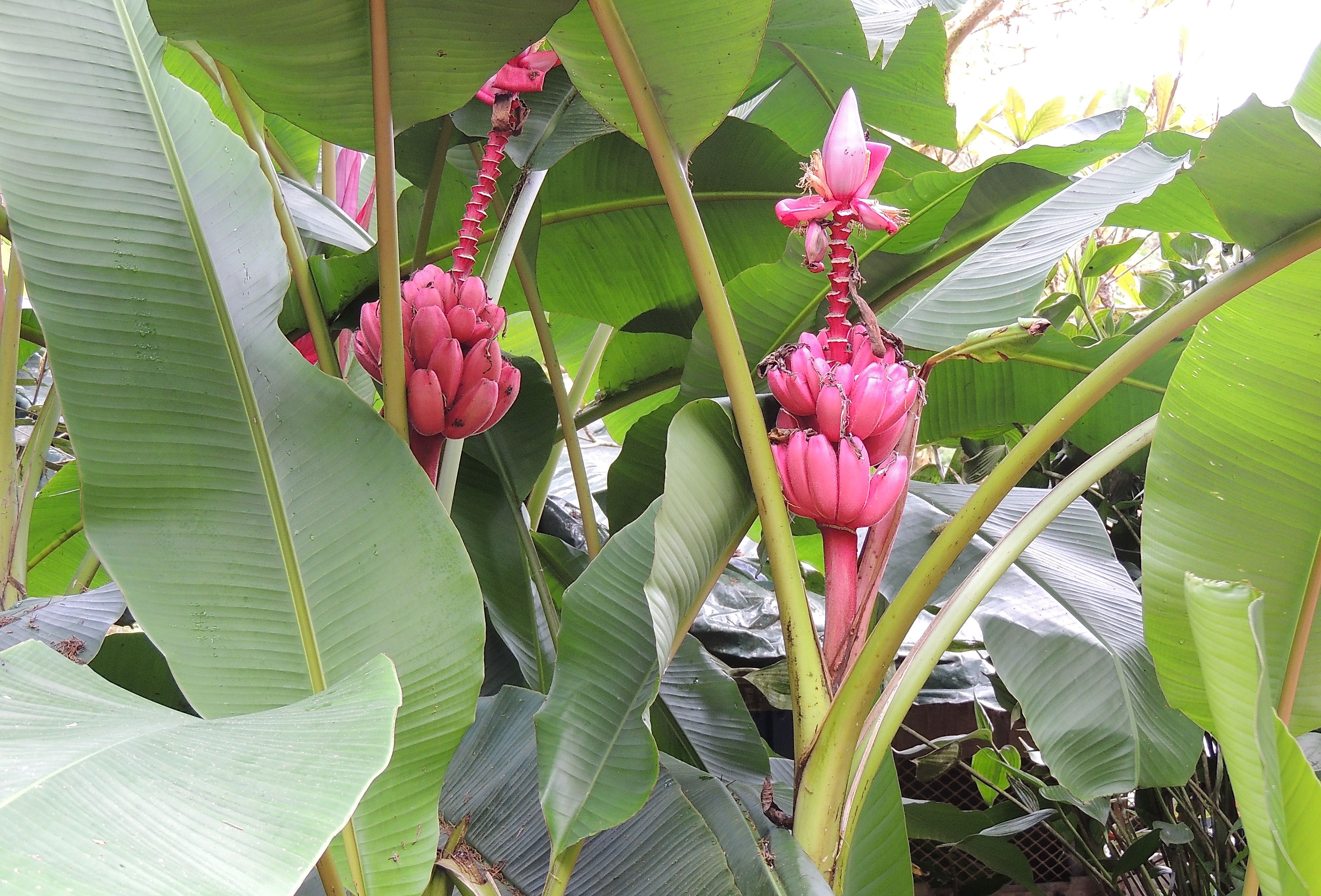 Red Banana Tree - Photo by William Young
Red Banana Tree - Photo by William Young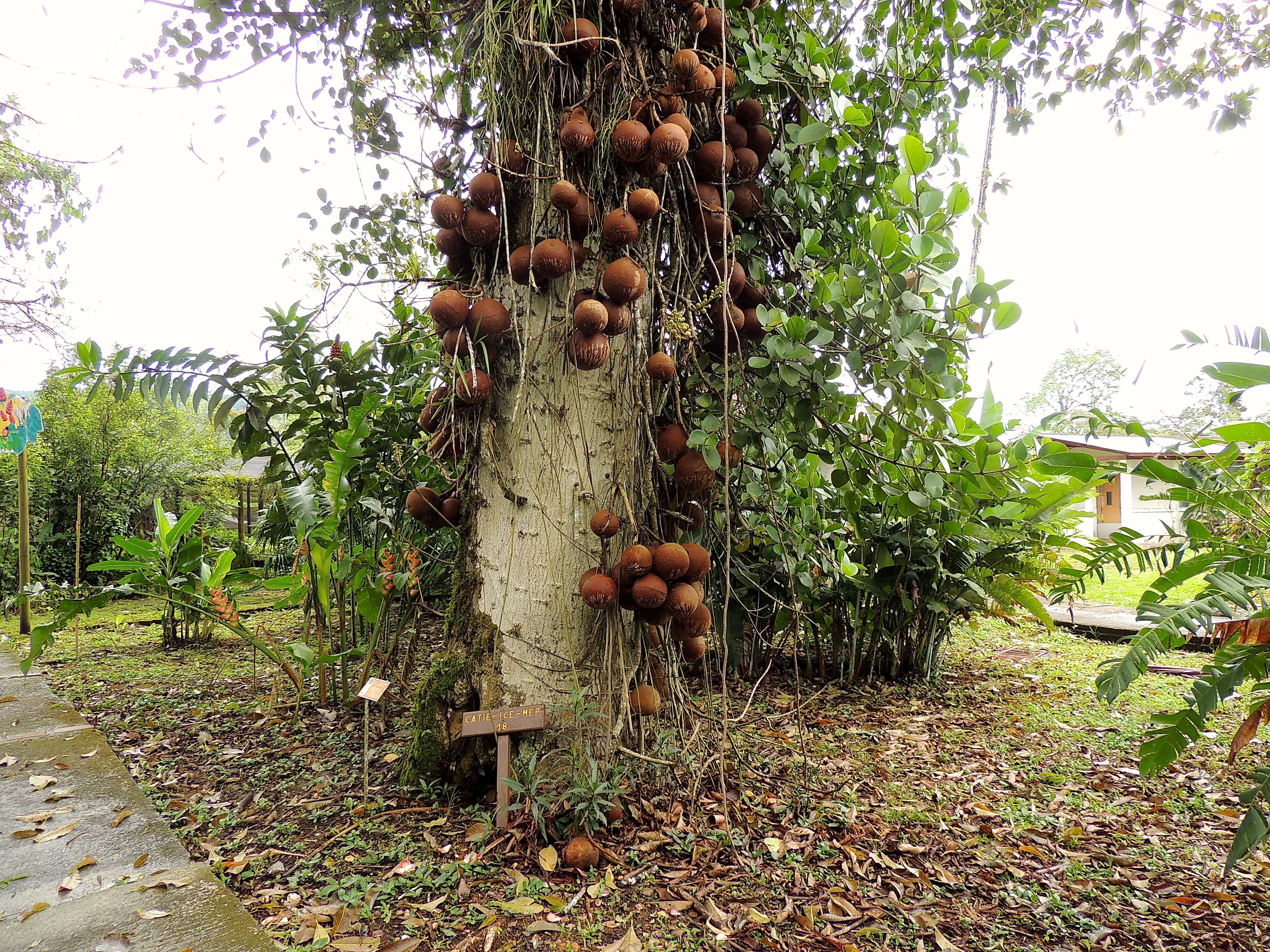 Cannonball Tree - Photo by William Young
Cannonball Tree - Photo by William YoungOn Saturday, I hired Mercedes to take me to the Rio Tuis valley. The weather had cleared overnight, so we started our trip in bright sunshine. After lunch at Rancho Bajo, we spent much of the afternoon at a large artificial lake near a hotel called Casa Turire. On Sunday, Mercedes took me to some of the upland trails around Ranch Naturalista. We had lunch at Rancho Bajo, and I worked on my field notes before joining Mercedes at the hummingbird pools in the late afternoon. On Monday, the 27th, Mercedes came to Ranch Bajo at 6, and we birded around the property until breakfast. We spent the morning at La Mina, stopping to see the Sunbittern nest along the way. After lunch, I walked to Wayne Easley's house and watched his feeders before heading to Rancho Naturalista, where I watched birds come in to bathe in the pond near the dining area.
For my final full day in Costa Rica on the 28th, Mercedes met me at 5:15 so that we could go to Wayne Easley's house to look for a Lesson's Motmot. Wayne also has a moth sheet, and he showed me some wonderful moths and other insects. I was more excited about seeing the moths than seeing the motmot. After breakfast, Mercedes and I watched the feeders at Rancho Naturalista for awhile before heading back to the upper trails on the property. We then headed to Rancho Bajo and birded until lunch. After lunch, we walked back to Rancho Naturalista, where Mercedes had some work to do, and I wanted to observe the ponds one more time. When I finished watching, I went to the Rancho Naturalista office and thanked some of the staff. I also said good-bye to Mercedes, who did so much to make my stay so enjoyable.
My ride to the airport was scheduled for 7:15, so I took a shower and finished packing before dinner. I said good-bye to Kathy and John and thanked them for everything they did to make my stay in Costa Rica so comfortable and relaxing.
Below are my field observations.
Waterbirds
I had a close look at a Green Ibis on a lawn at CATIE. It was looking for worms, and I saw it catch a long one. From certain angles, I could see the iridescent green on its plumage. Anhingas were nesting in the trees, and one male Anhinga was perched with his wings spread. He had bright blue skin around his eyes. One tree at CATIE had a large colony of nesting Cattle Egrets, who are beautiful in breeding plumage. In addition to the plumes on their breast and their erected head plumes, they have a red bill with a yellow tip and some lavender skin around the eye. The same tree had nesting Great Egrets, who have green skin around the eyes. Boat-billed Herons were perched in other trees. Because they tend to be most active at dusk, I have never seen one during the day doing anything but either perching, sleeping, or sitting on a nest. Black-crowned Night-Herons were in the same area, and a couple were foraging on the ground. I also heard their loud QUAWK call from the trees. A young Black-crowned Night-Heron was in the trees at Platanillo. Green Herons were foraging from the rocks in the river at Platanillo. I saw them in a couple of other places. On the ride to CATIE, we stopped briefly at a wetlands area, and I saw a Little Blue Heron, a Snowy Egret, and a Great Egret. I saw Snowy Egrets and Little Blue Herons at Casa Turire, as well as a Yellow-crowned Night-Heron molting from juvenile into adult plumage. We saw and heard a Limpkin fly by. Its loud screams make the bird sound as if it is being abused.
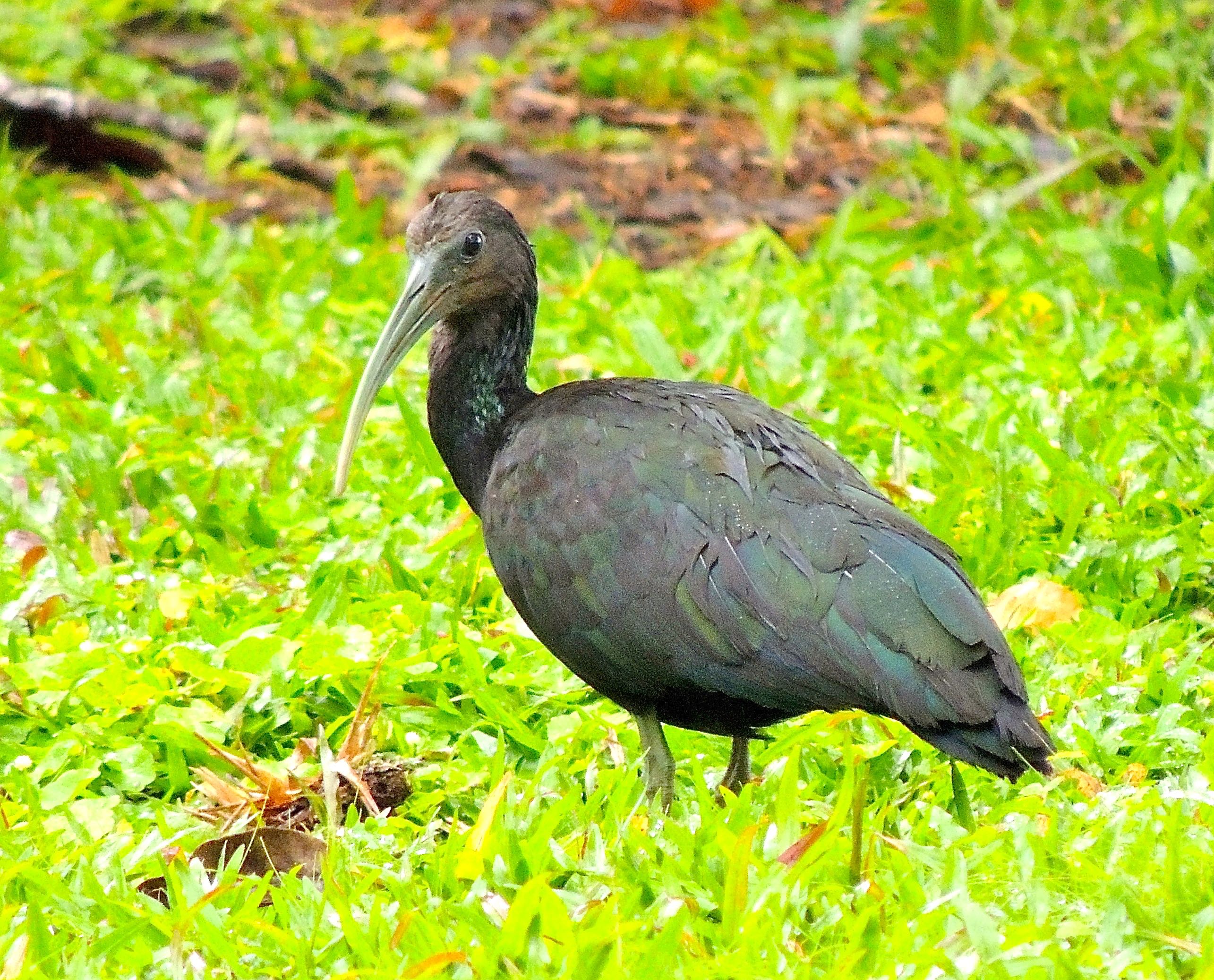 Green Ibis - Photo by William Young
Green Ibis - Photo by William Young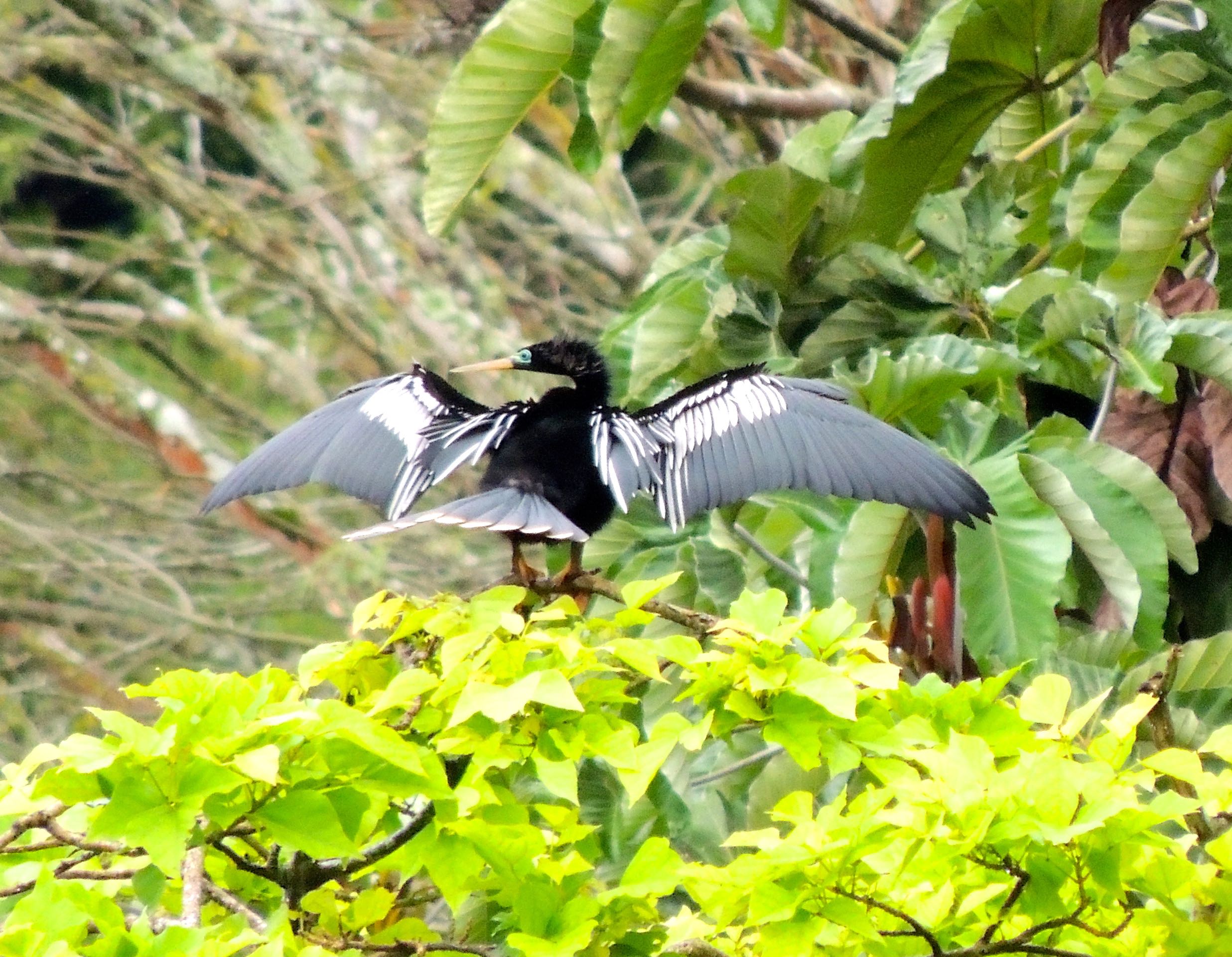 Anhinga - Photo by William Young
Anhinga - Photo by William Young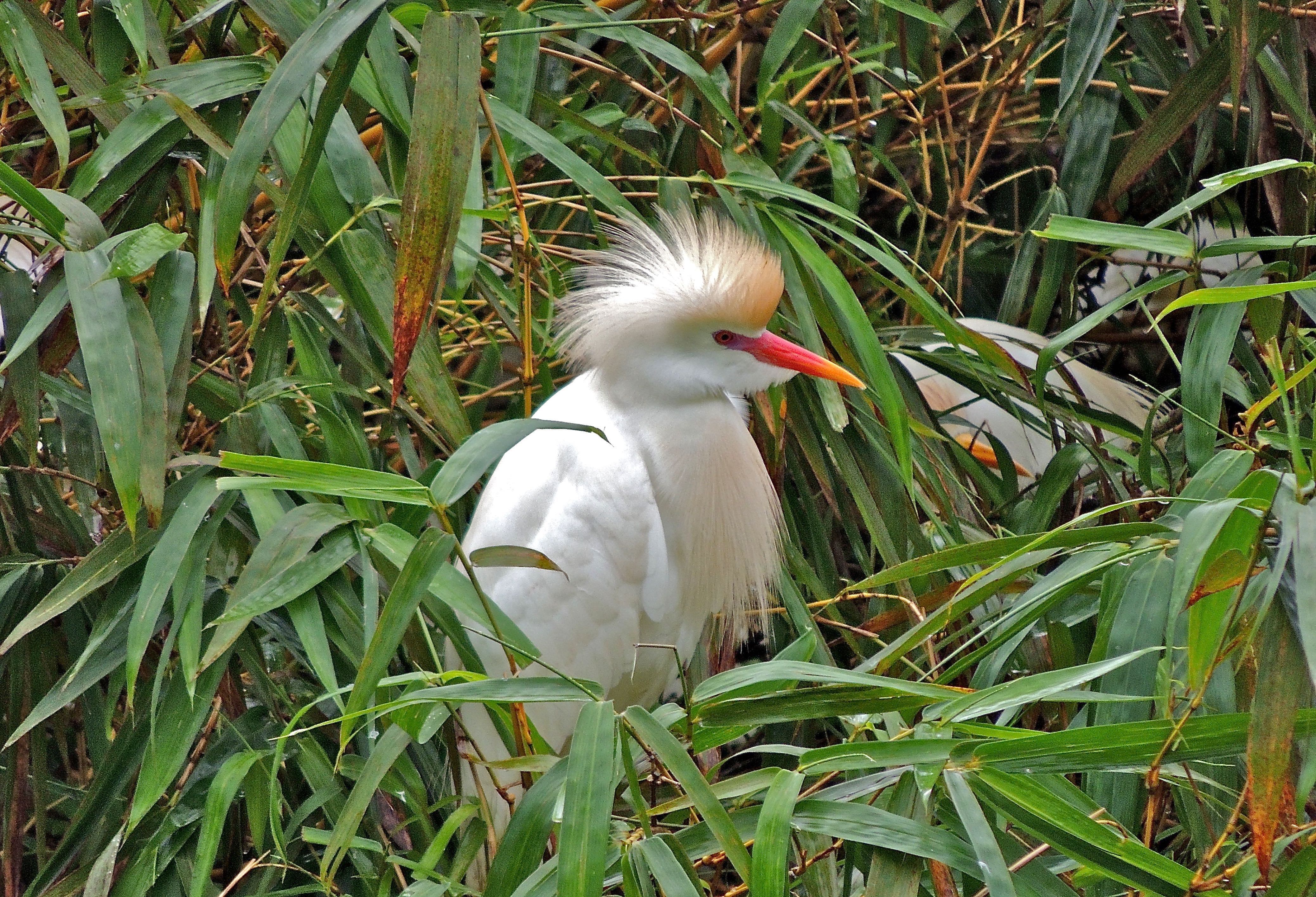 Cattle Egret - Photo by William Young
Cattle Egret - Photo by William Young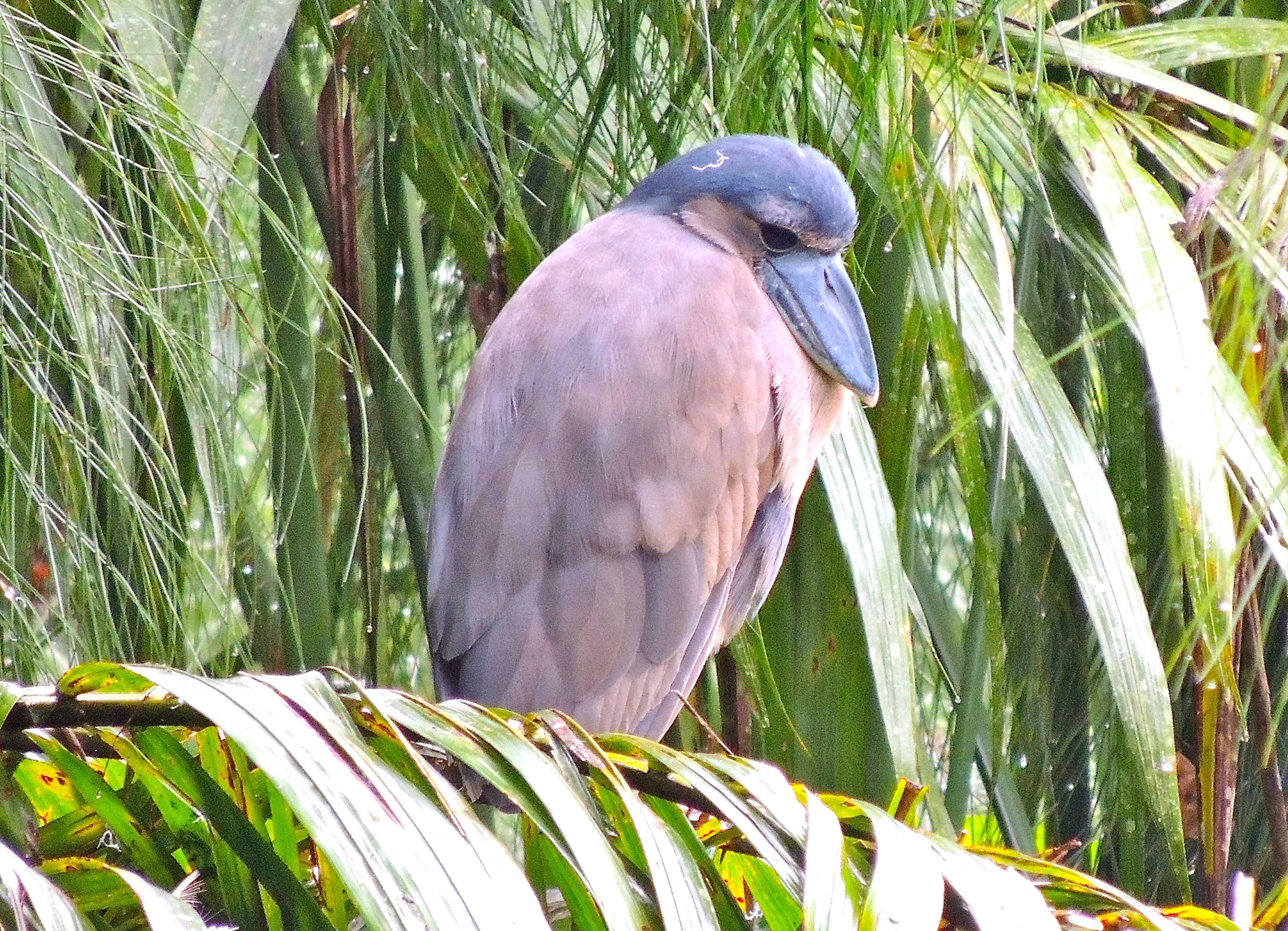 Boat-billed Heron - Photo by William Young
Boat-billed Heron - Photo by William Young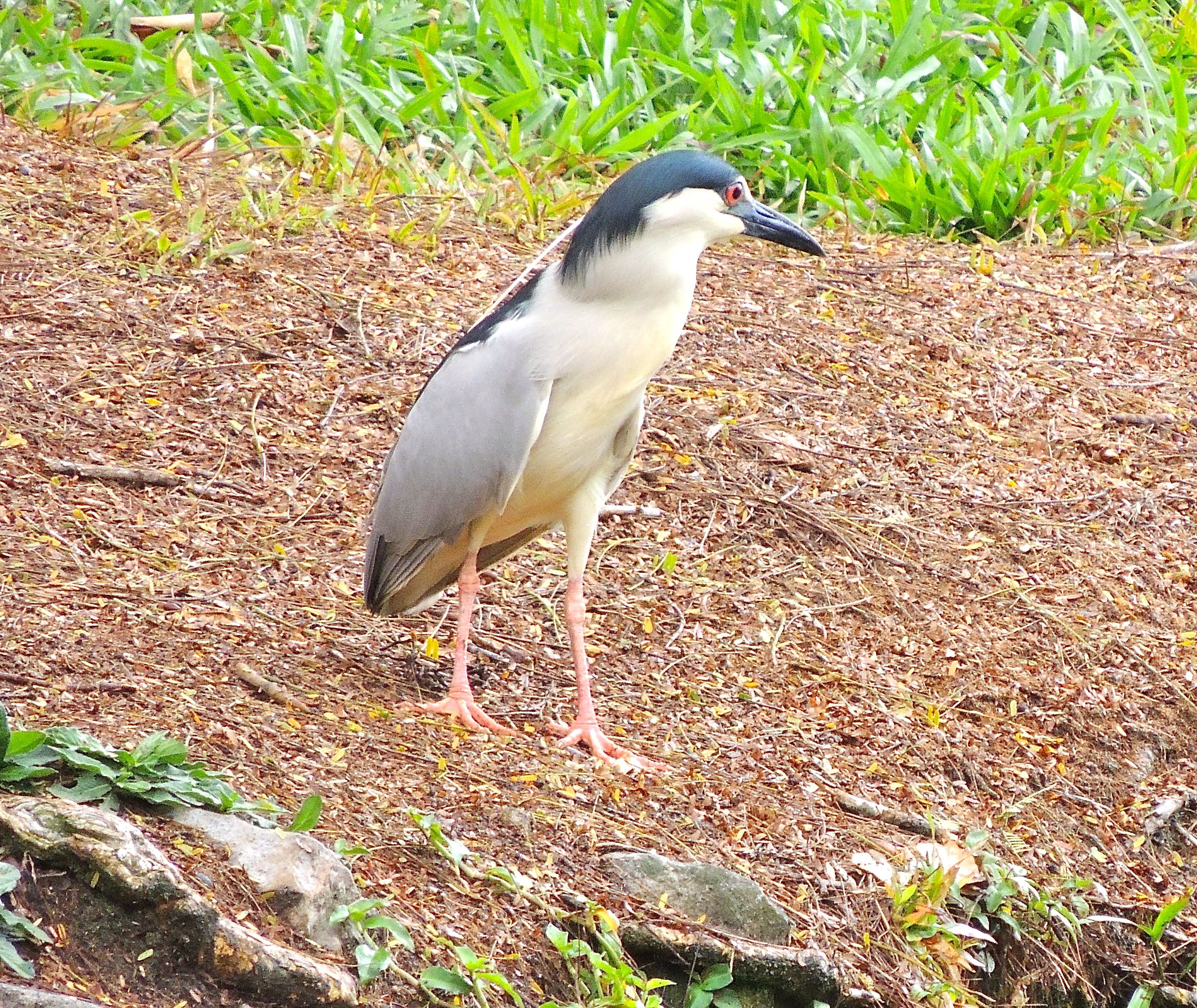 Black-crowned Night-Heron - Photo by William Young
Black-crowned Night-Heron - Photo by William Young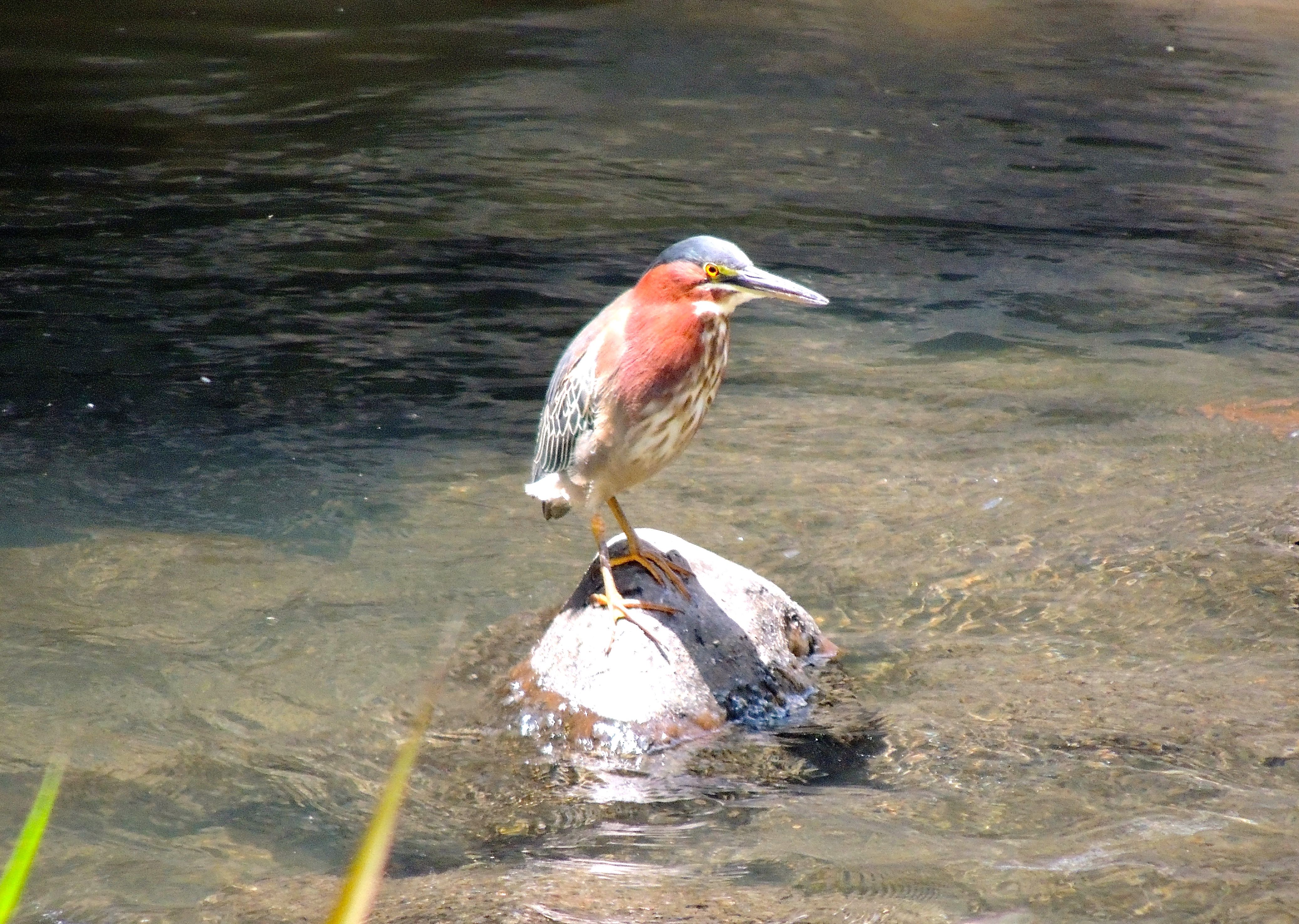 Green Heron - Photo by William Young
Green Heron - Photo by William YoungI saw two life birds on the trip. One was a Fasciated Tiger-Heron. A young one was near the bridge at Platanillo. It was mostly brown with white stripes. It had its long neck stretched out. We later saw an adult along the river on our drive to La Mina. The adult is gray, as was the weather that day. Because we were in a car, I did not have a close enough look to see the barring on its plumage. At CATIE, there was an adult Bare-throated Tiger-Heron, who is gray. I could see the bare yellow skin on the throat, at the base of the bill, and around the eye.
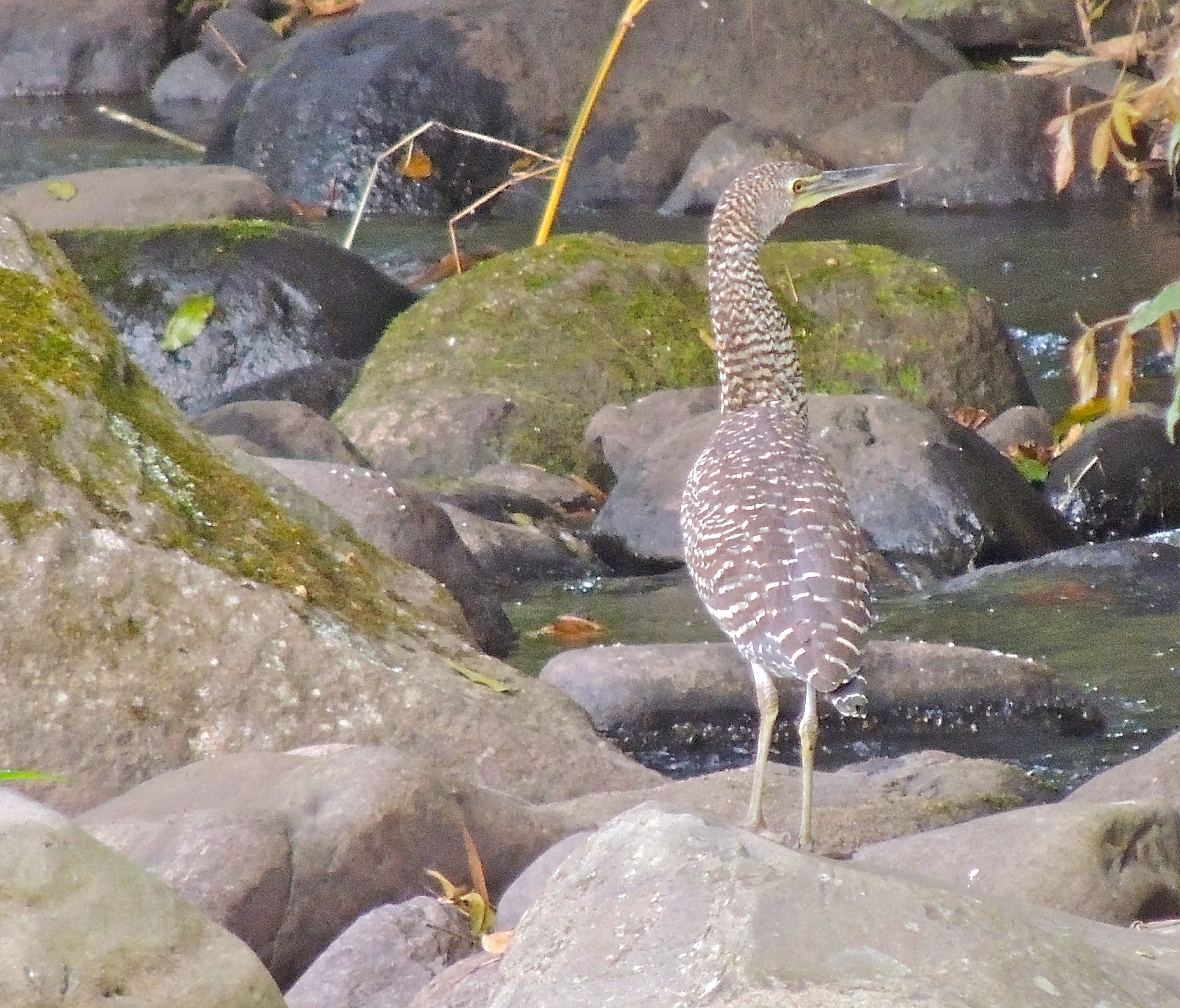 Fasciated Tiger-Heron - Photo by William Young
Fasciated Tiger-Heron - Photo by William Young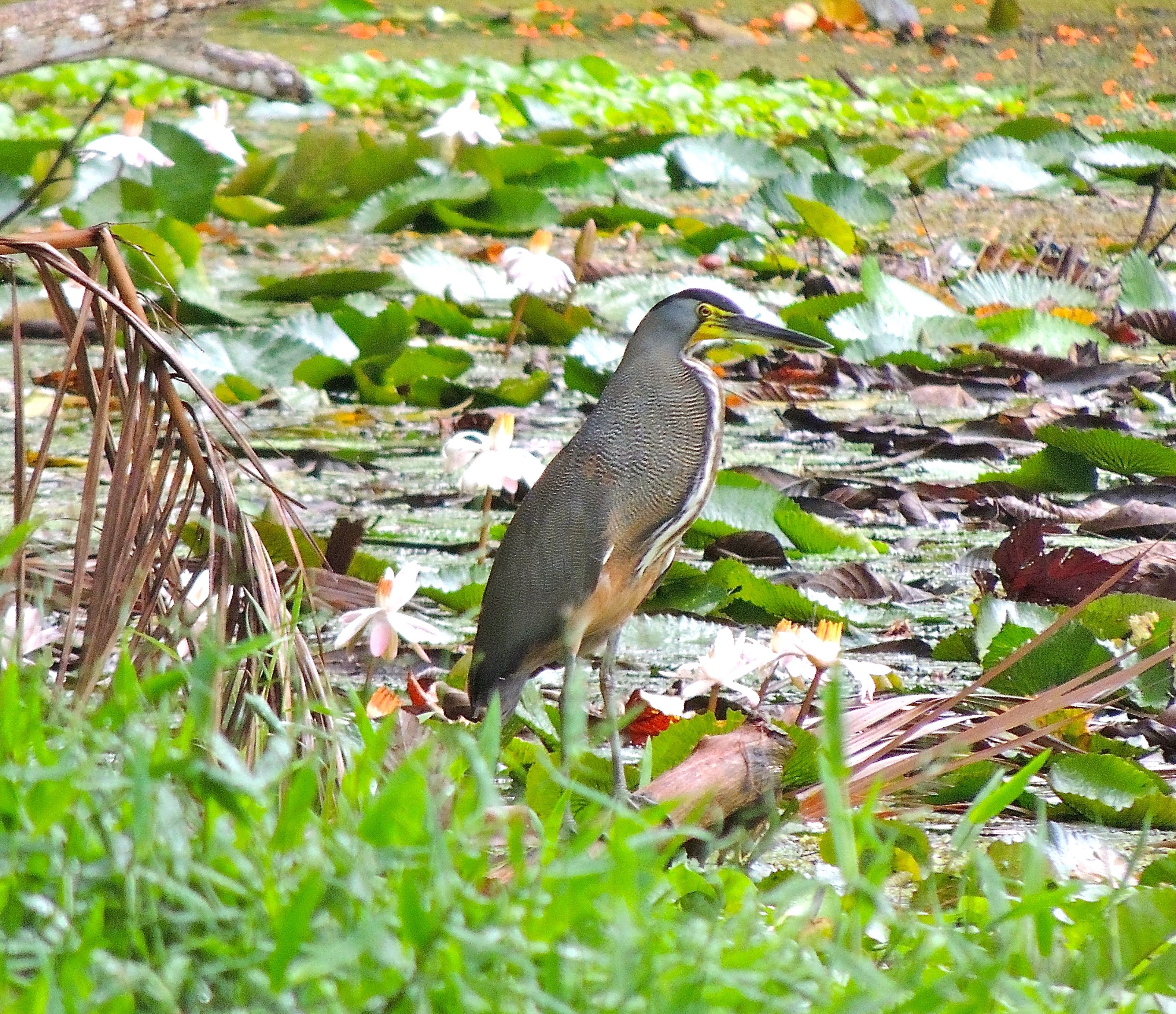 Bare-throated Tiger-Heron - Photo by William Young
Bare-throated Tiger-Heron - Photo by William YoungAt CATIE, I saw a pair of Muscovy Ducks feeding on the lawn, but they were domestic. The only wild ducks I saw were some distant Blue-winged Teal at Casa Turire. In the distance was what looked like a Neotropic Cormorant, but it was too far away to make a positive identification.
Raptors, Falcons, and Vultures
I did not see many raptors on the trip. The most common was the Roadside Hawk. Three were by the road leading up the hill to Rancho Naturalista, and I heard their loud one-note screams. They were also in other places. About a half a dozen Broad-winged Hawks were soaring with a kettle of vultures over CATIE. At Rancho Naturalista on my final day of the trip, a Bicolored Hawk flew to a branch near where Mercedes and I were standing. It appeared to have a baby chicken in its talons. The hawk's leggings are brown, and it has large orange eyes. There is yellow skin above the bill and around the eyes. Bicolored Hawks are Accipiters, a genus that kills birds, including chickens. Lisa said that she once saw a Bicolored Hawk who had killed a chachalaca and then dropped it on a road. We saw three Snail Kites at Casa Turire, two of whom perched on a log next to the water. On some days, one or two Swallow-tailed Kites would fly near the dining area at Rancho Naturalista right after lunch.
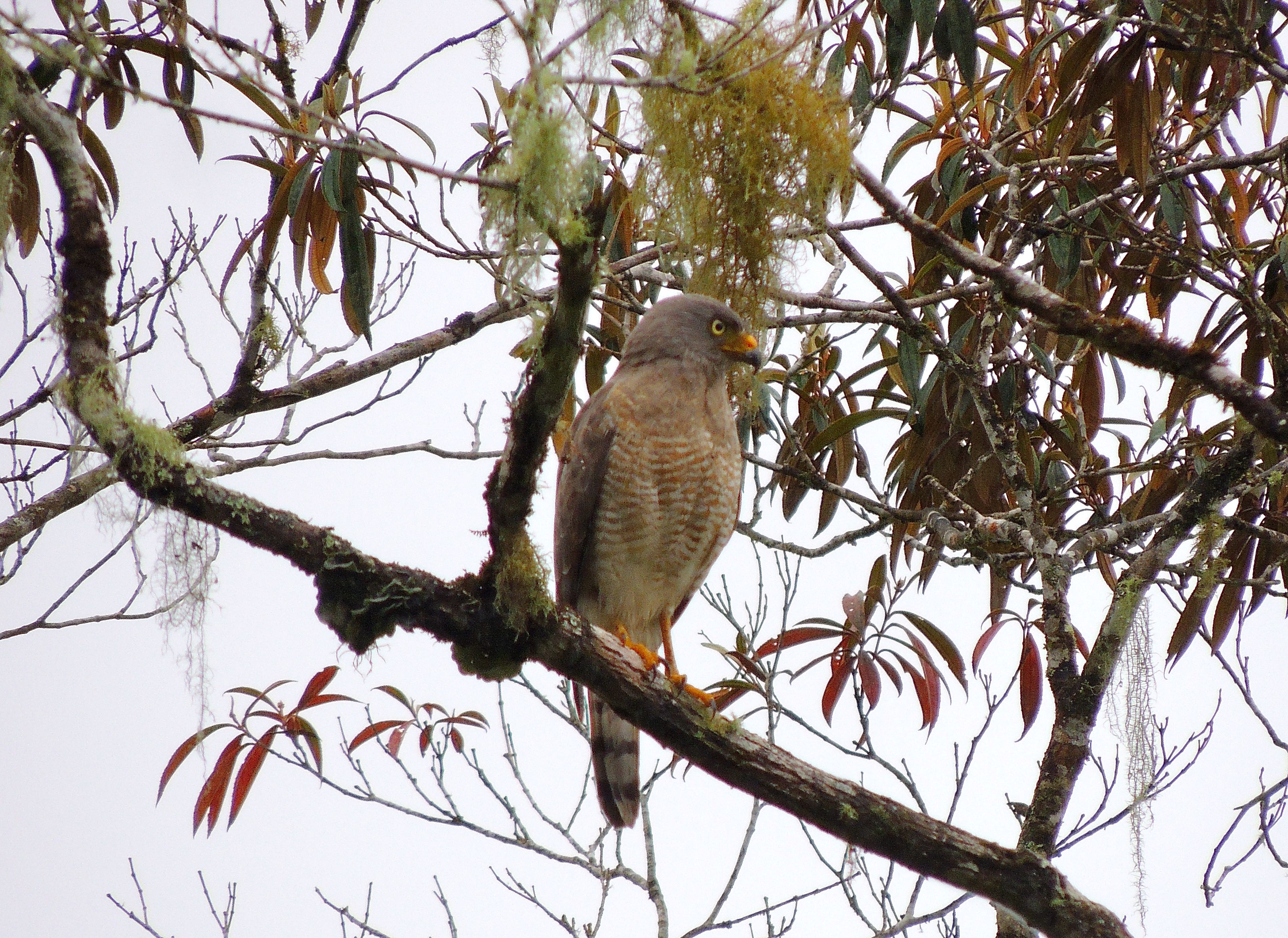 Roadside Hawk - Photo by William Young
Roadside Hawk - Photo by William YoungAfter I arrived in Costa Rica, the first species I saw when we were driving out of the San Jose Airport was an Osprey, but I did not see another one during the trip. At CATIE, we saw a perched Yellow-headed Caracara in a palm tree, and we heard it vocalizing. We also saw the much larger Crested Caracara there, and I could see its white wing patches when it flew. Turkey and Black Vultures were the only species I saw on every day of the trip. The Turkey Vultures who stay in Costa Rica have a gray patch on their nape, while the migratory Turkey Vultures do not. Some Turkey Vultures at CATIE were on the ground and appeared to be eating palm nuts. I remember vultures doing something similar when I was at the Canopy Camp in Panama.
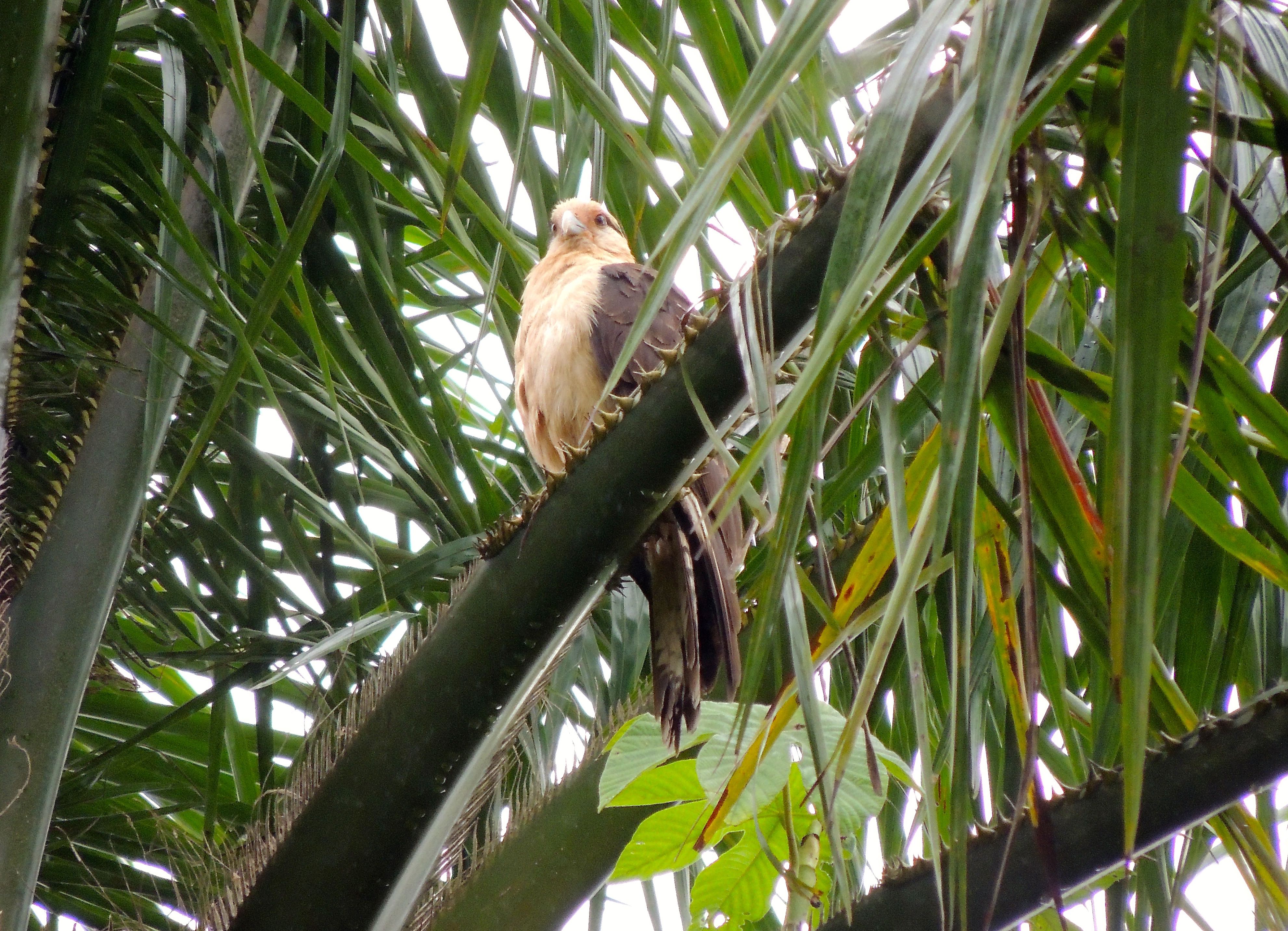 Yellow-headed Caracara - Photo by William Young
Yellow-headed Caracara - Photo by William Young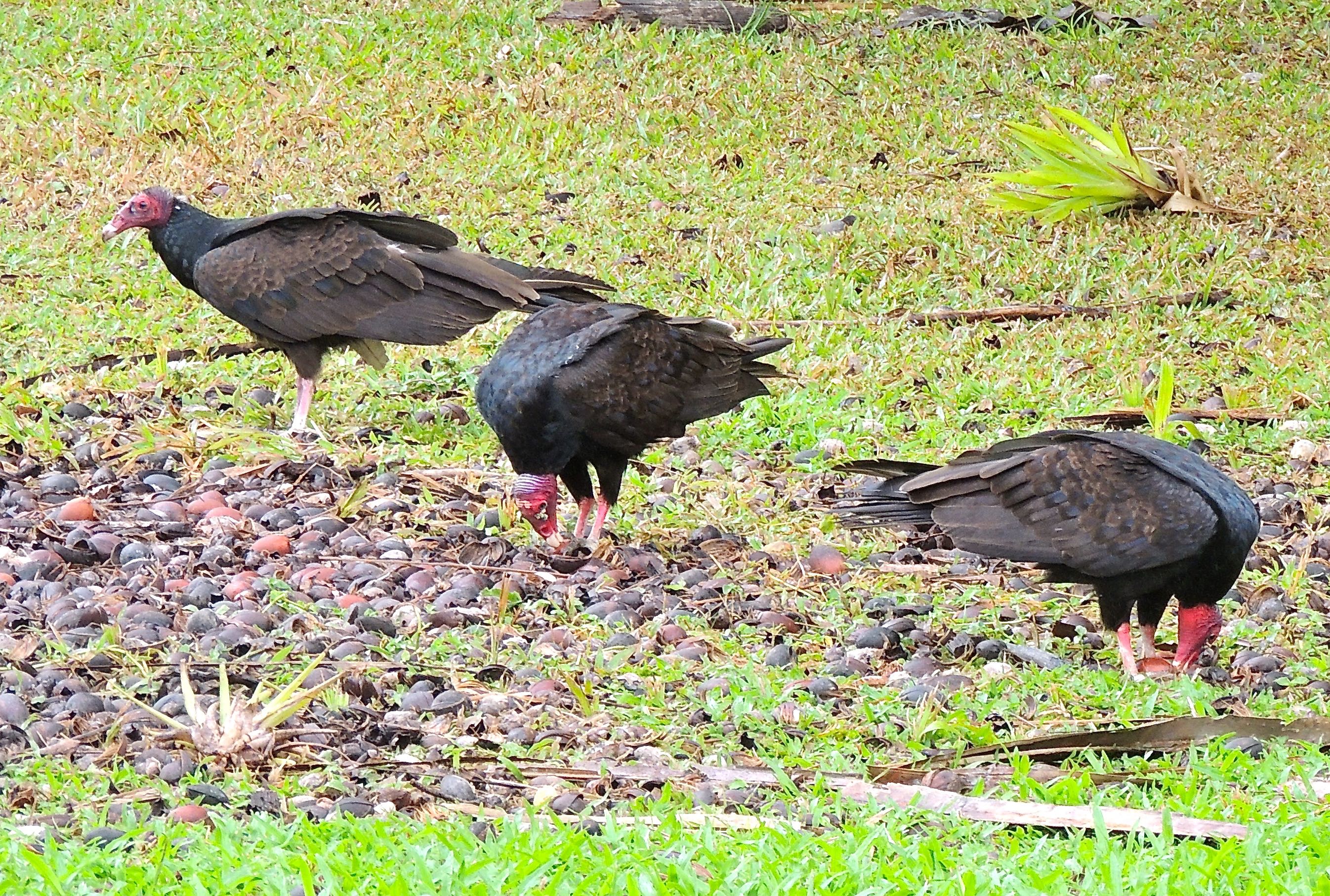 Turkey Vultures - Photo by William Young
Turkey Vultures - Photo by William YoungChachalacas and Guans
Gray-headed Chachalacas were some of my favorite birds of the trip. They were common around Rancho Naturalista. They are pheasant-sized birds who behave like songbirds, sometimes hopping onto branches that can't support their weight. They sometimes had aggressive encounters with each other on the lawn near the feeders. When they were in trees, they often walked along branches rather than hopping. Sometimes they displayed by lifting their tail. I saw one in a tree at Rancho Bajo displaying to another one on the same branch. Their call is loud. On my final day, Mercedes and I saw a pair of Crested Guans in a tree in the pastures at Rancho Naturalista. I saw one with bare blue skin on the face and around the eye, a red throat, and white markings on its dark breast. One of them flew to the other side of the path, but the other stayed put when we walked by.
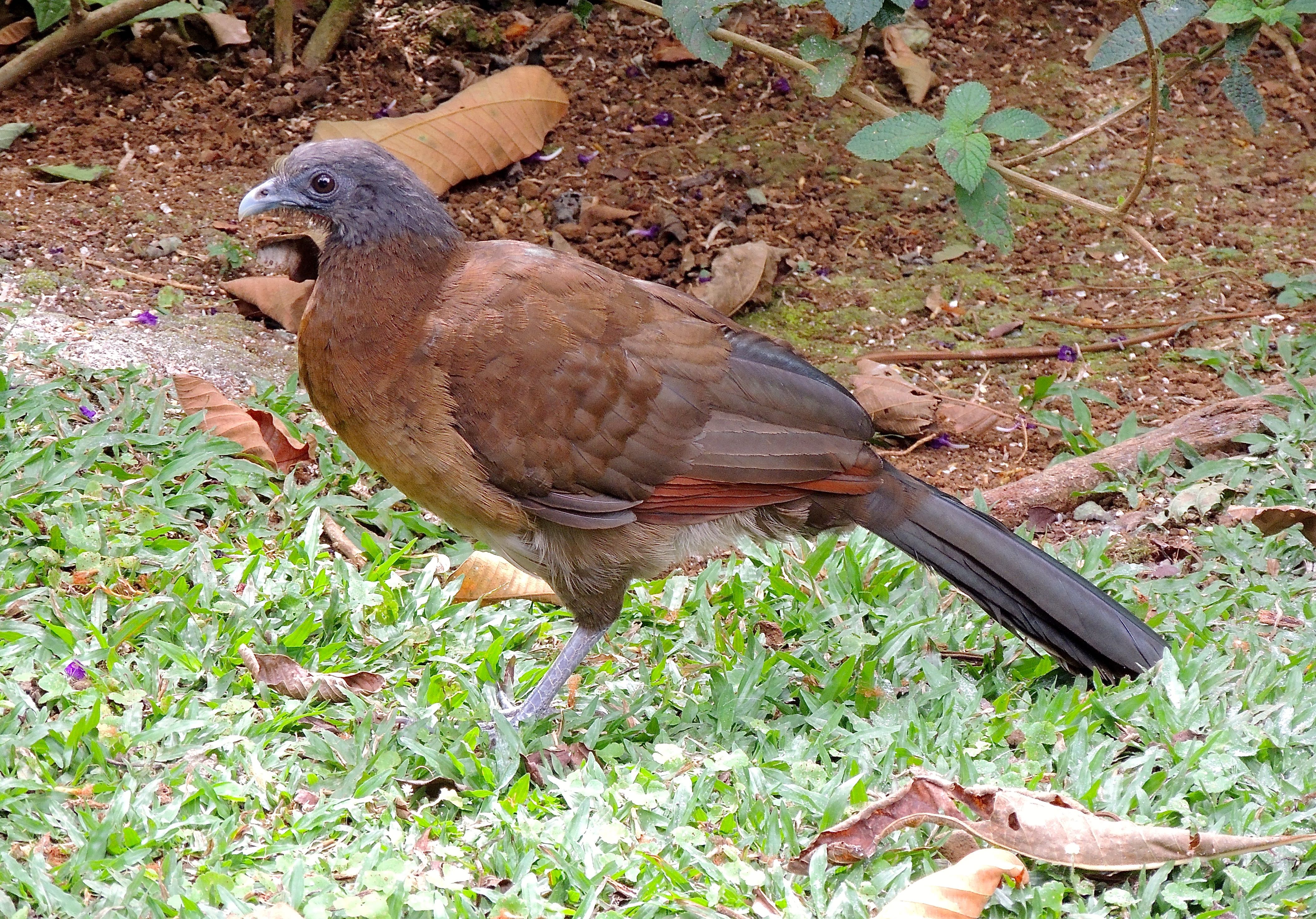 Gray-headed Chachalaca - Photo by William Young
Gray-headed Chachalaca - Photo by William Young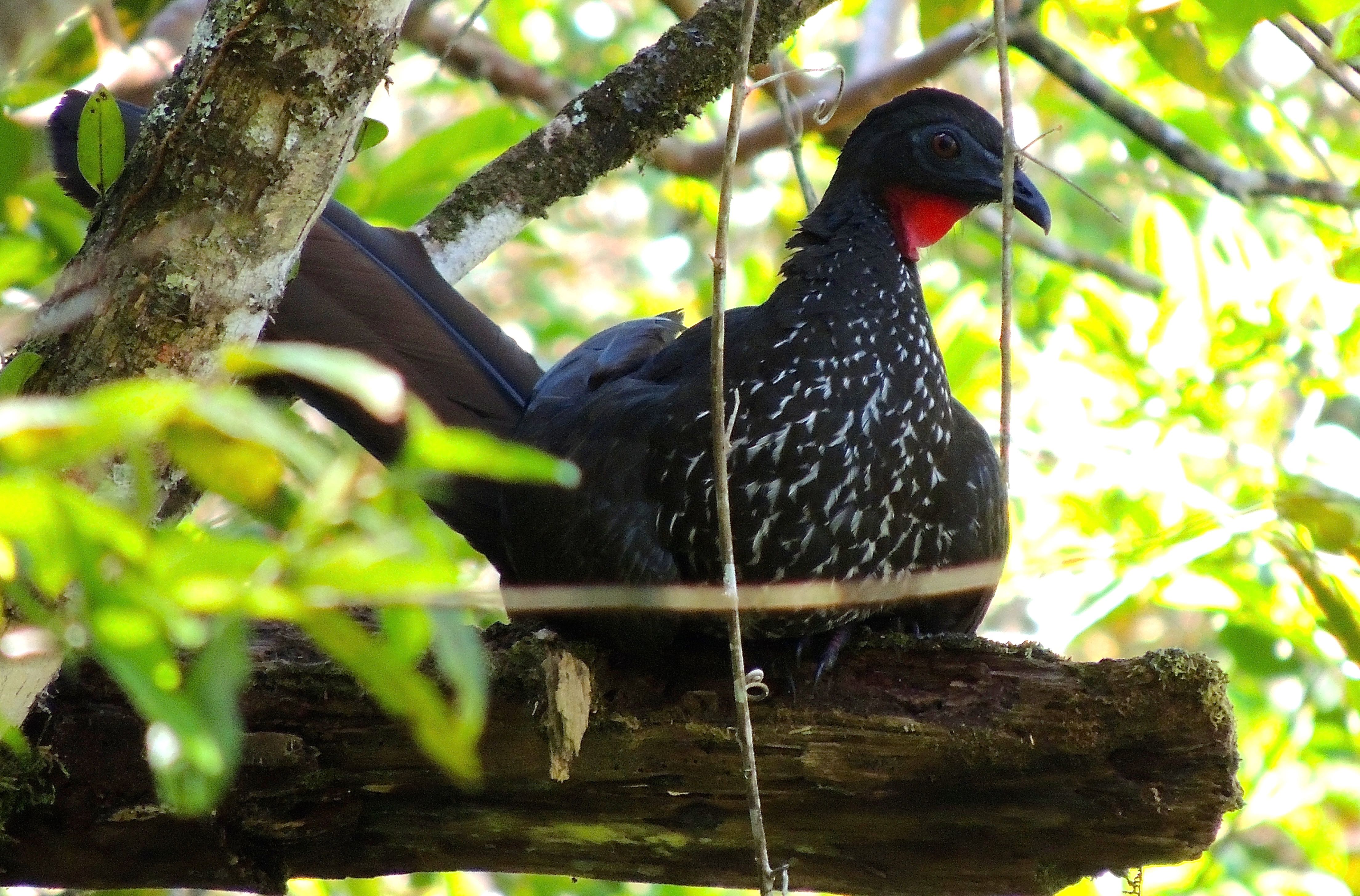 Crested Guan - Photo by William Young
Crested Guan - Photo by William YoungSunbittern, Jacanas, Rails, Thick-knees, Lapwings, and Sandpipers
Another favorite bird during the trip was the Sunbittern. I had previously seen them from a distance, and they seemed shy and secretive. On this trip, I had close looks at a lot of them. The first time I went to view a nest at Platanillo, an adult was sitting on it, and another Sunbittern was foraging in the river. The second time, I saw two stripe-headed chicks in the nest with an adult. Both the male and female share in incubation and caring for the chicks. At La Mina, Mercedes showed me a nest with an adult and one egg. They usually raise two chicks, so I don't know if the female was finished laying her clutch. The bird at the nest would occasionally stand up and roll the egg. At La Mina and Rio Tuis, we heard the plaintive whistles of Sunbitterns, and I shot video footage of one vocalizing at La Mina. It opened its bills, and I could see its orange tongue. At Rio Tuis, we saw the wet footprints of one on a rock next to a bridge. At Platanillo, one was preening, and I photographed an open wing that revealed the sunburst pattern responsible for the bird's name.
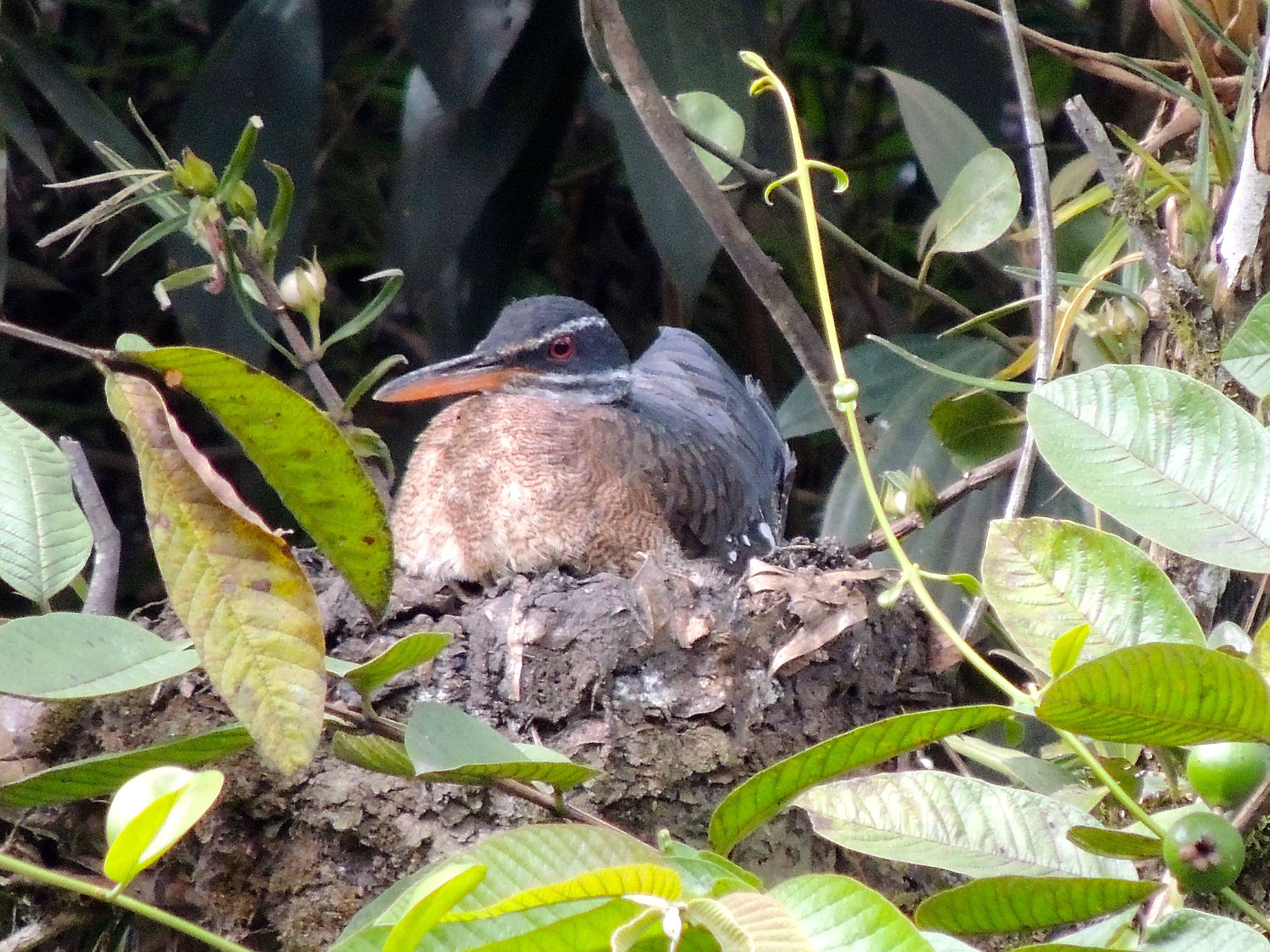 Sunbittern - Photo by William Young
Sunbittern - Photo by William Young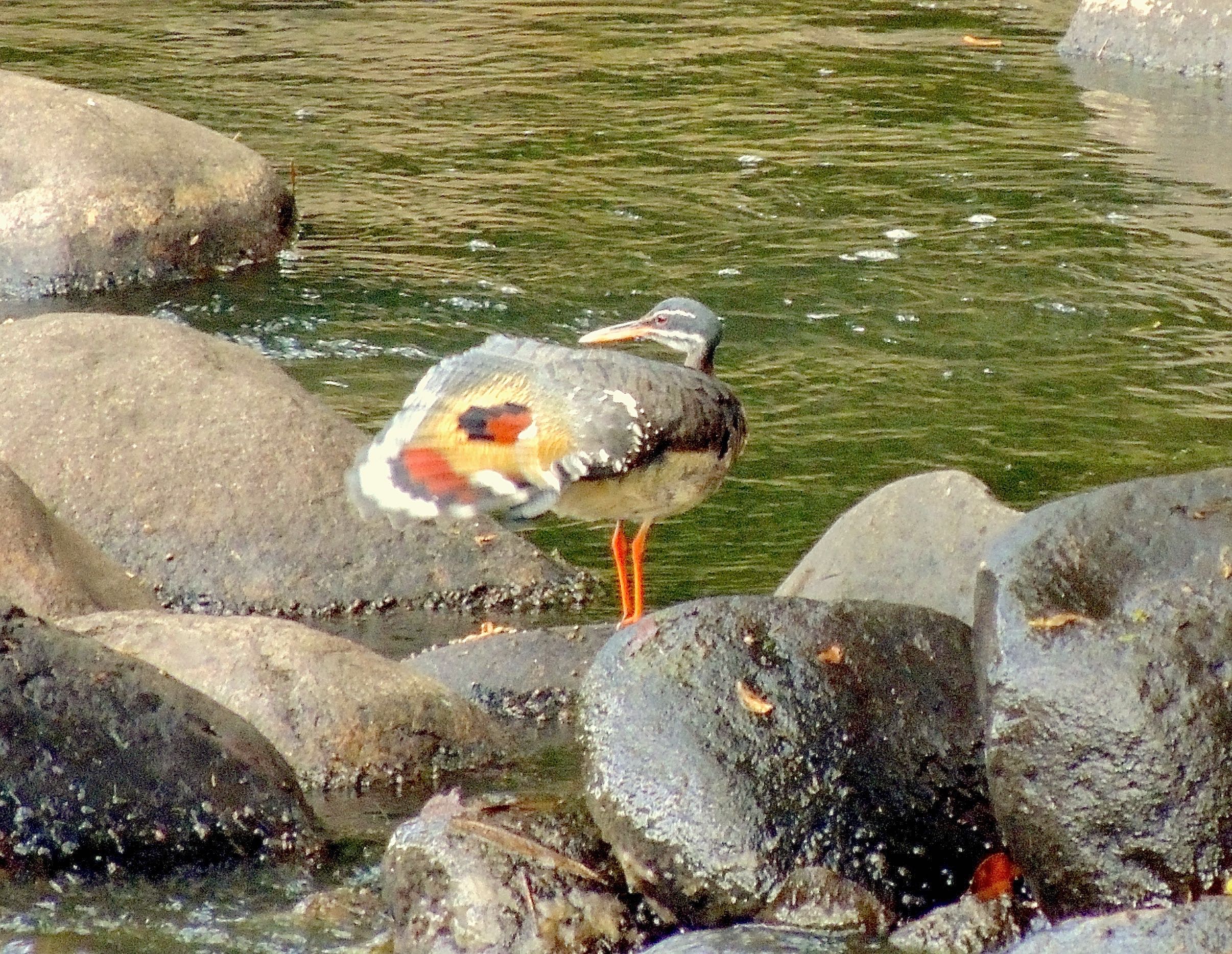 Sunbittern - Photo by William Young
Sunbittern - Photo by William Young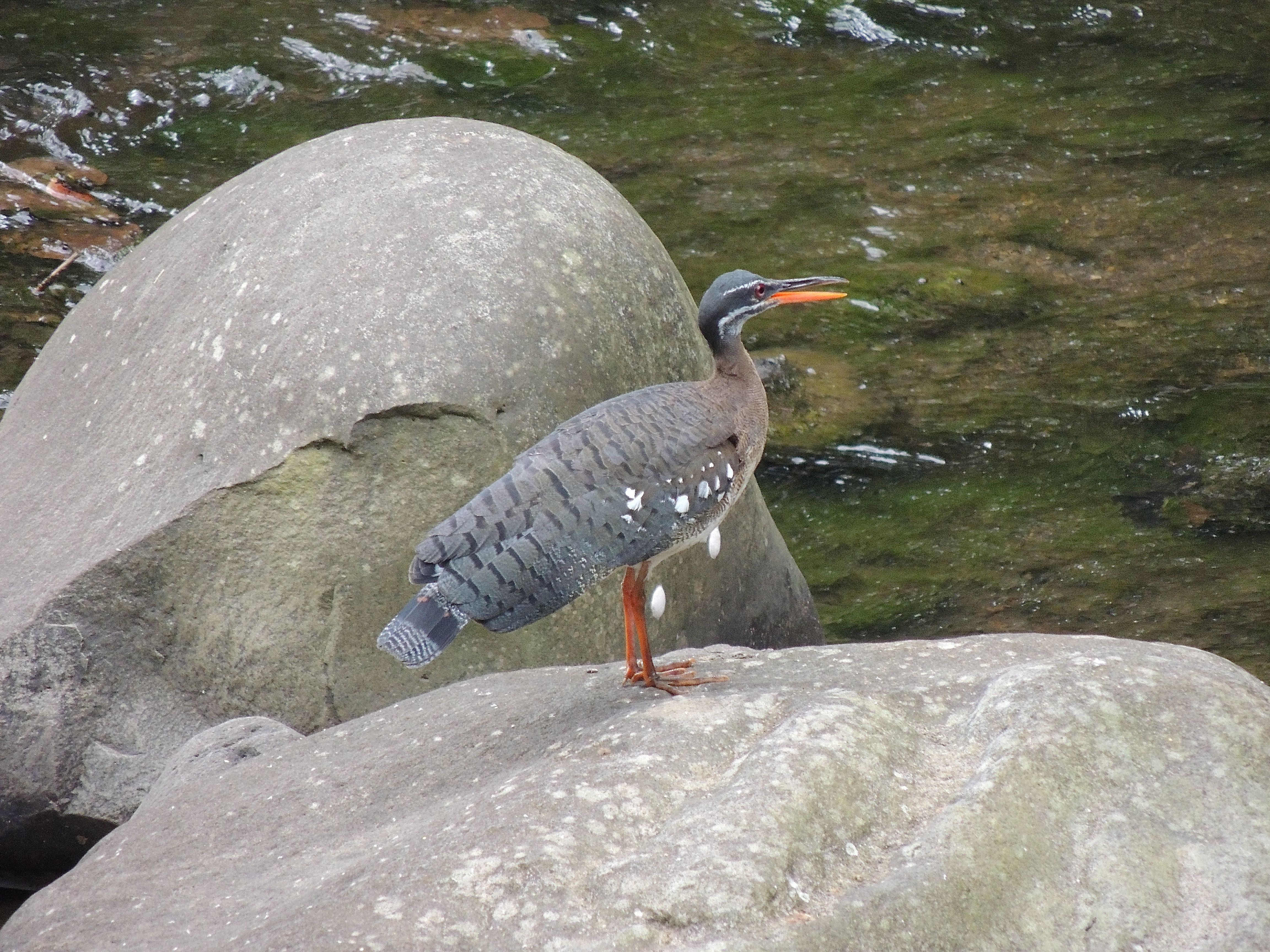 Sunbittern - Photo by William Young
Sunbittern - Photo by William Young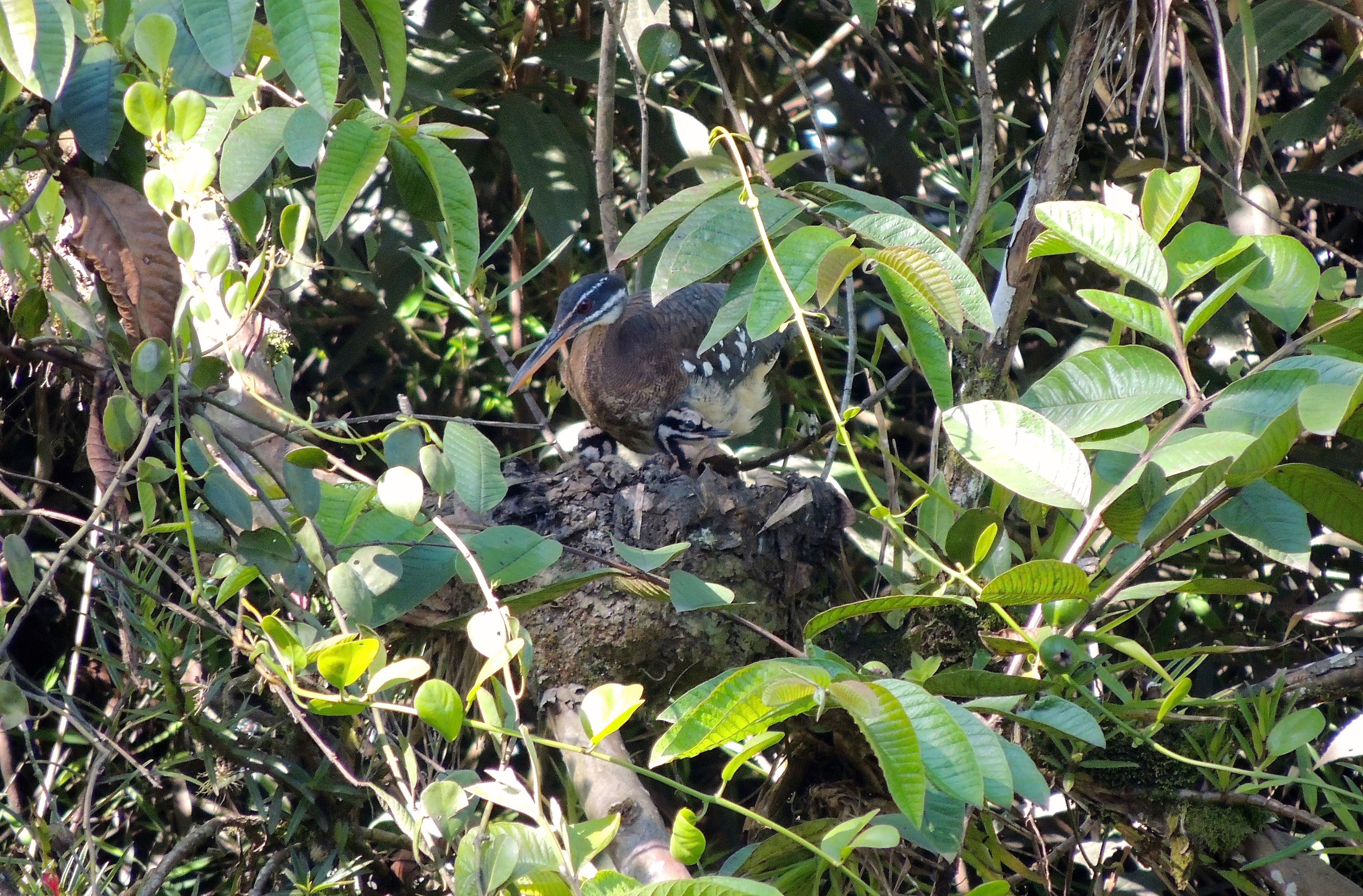 Adult Sunbittern with Two Chicks at Nest - Photo by William Young
Adult Sunbittern with Two Chicks at Nest - Photo by William Young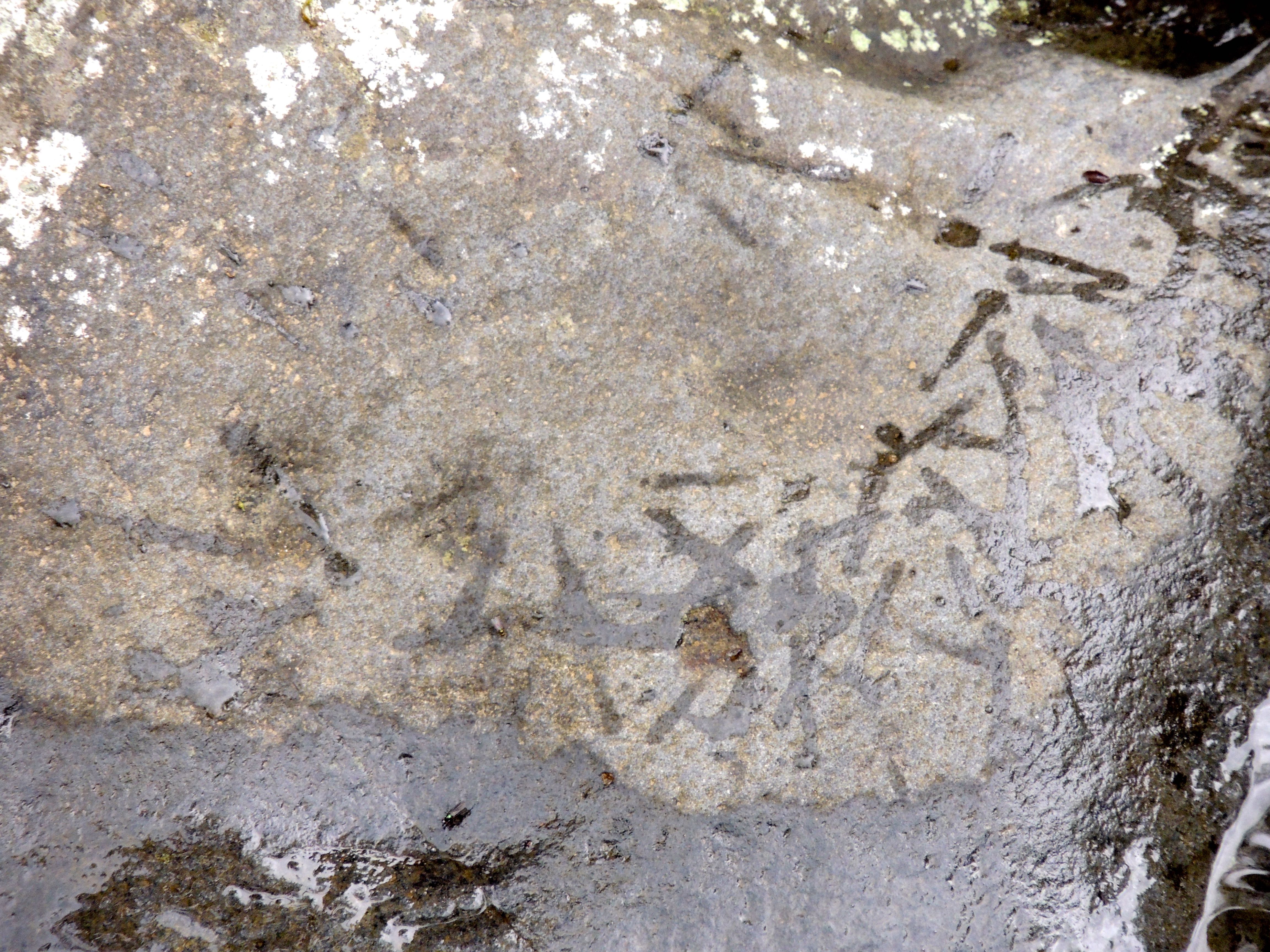 Sunbittern Footprints - Photo by William Young
Sunbittern Footprints - Photo by William YoungA lot of Northern Jacanas were around the lake at CATIE. The birds were walking on lily pads with their long spindly toes, sometimes aggressively displaying at each other. They have a bright yellow facial shield and white skin above the bill. I could see the yellow spur on each upperwing, similar to the ones on a Masked Plover in Australia. They have bright yellow flight feathers. I also saw young jacanas, who are brown with stripes on their head, and some juveniles molting into adult plumage. There were Purple Gallinules around the lake. I could see the long yellow toes on one standing on a log, and they sometimes compulsively cock their tail as if getting an electric shock. We heard the static-like call of a White-throated Crake at Casa Turire but did not see one. In the fields near there, we saw Southern Lapwings. Along a few rivers, we saw Spotted Sandpipers. I saw one who did not have spots yet.
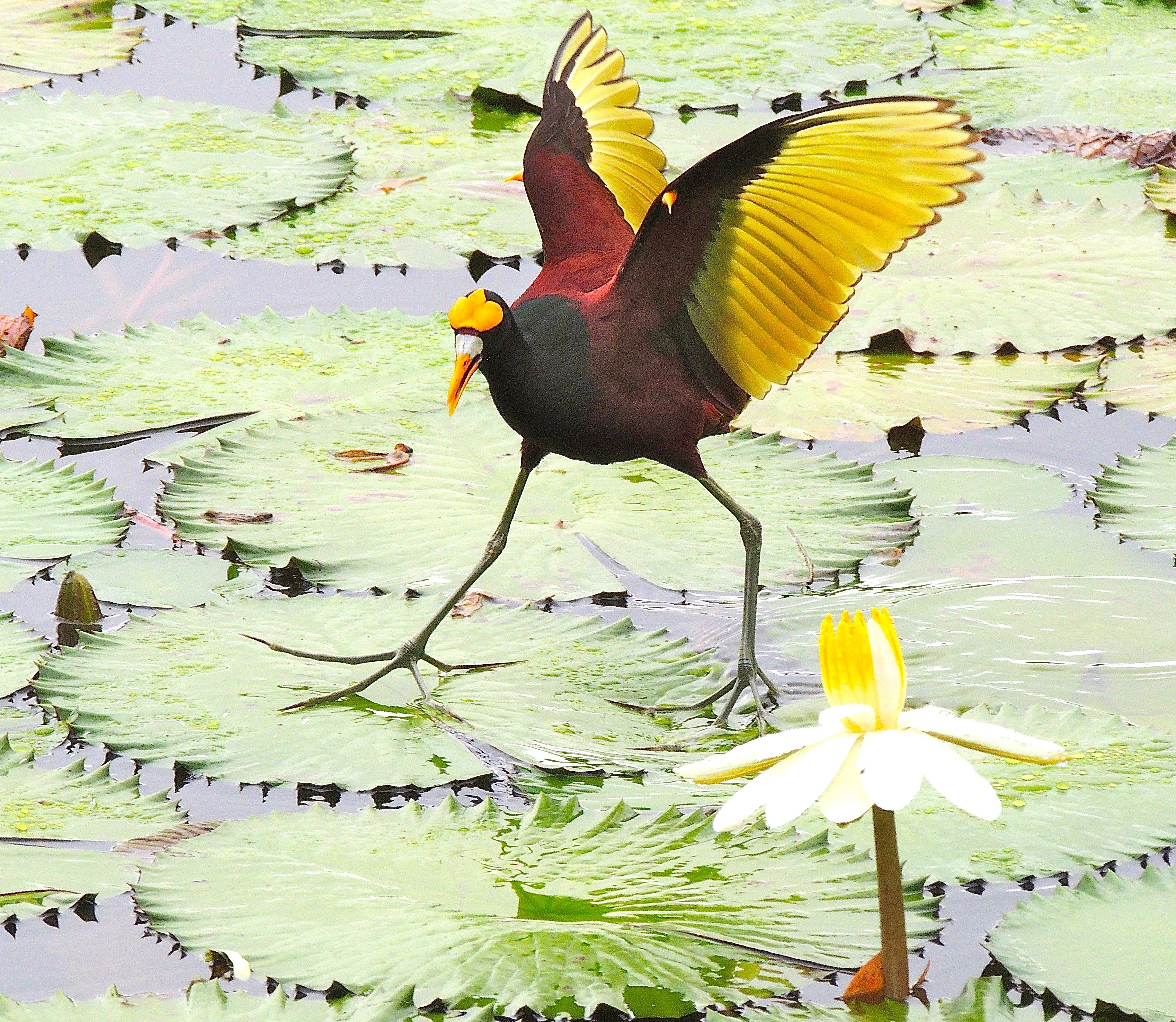 Northern Jacana - Photo by William Young
Northern Jacana - Photo by William Young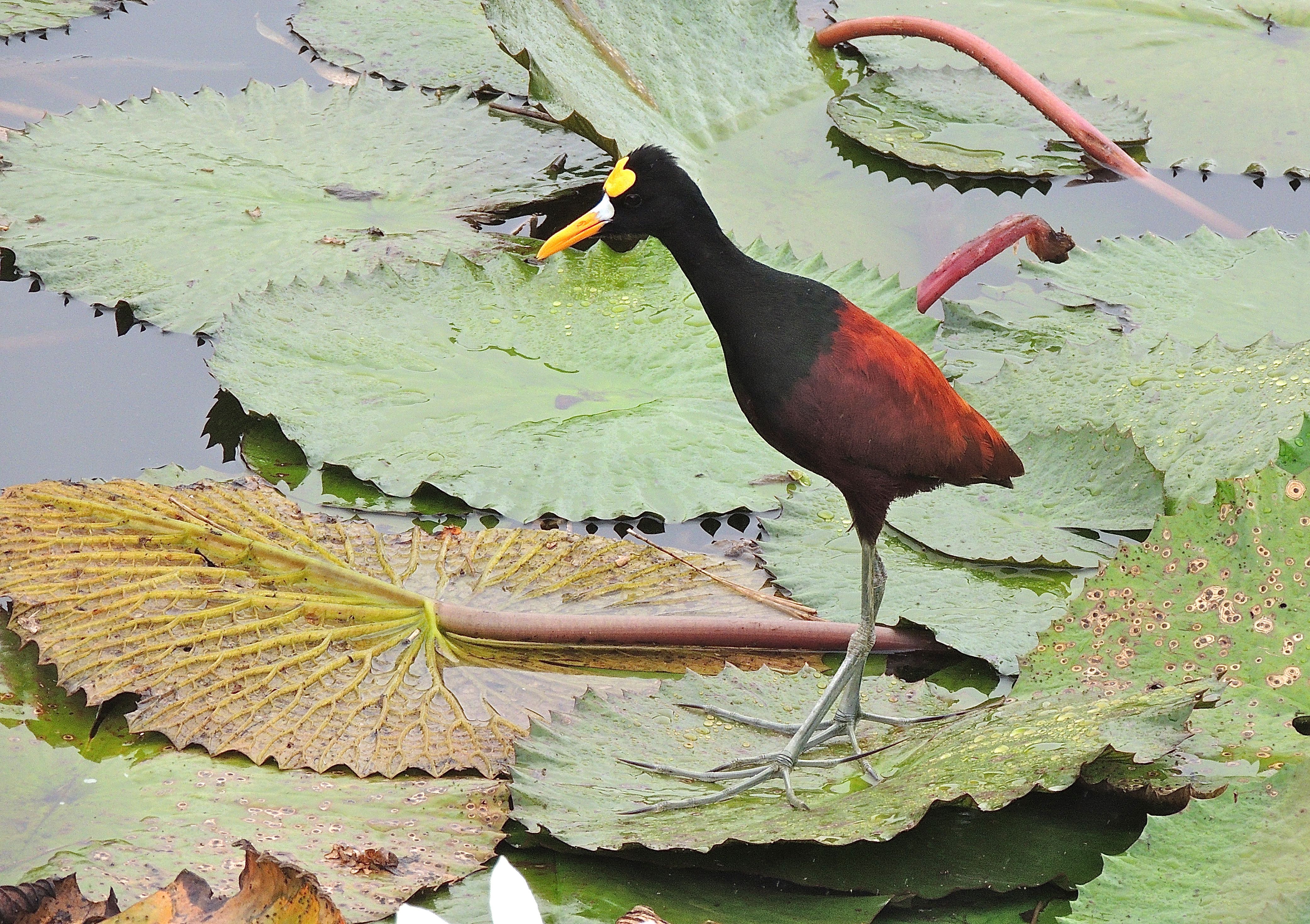 Northern Jacana - Photo by William Young
Northern Jacana - Photo by William Young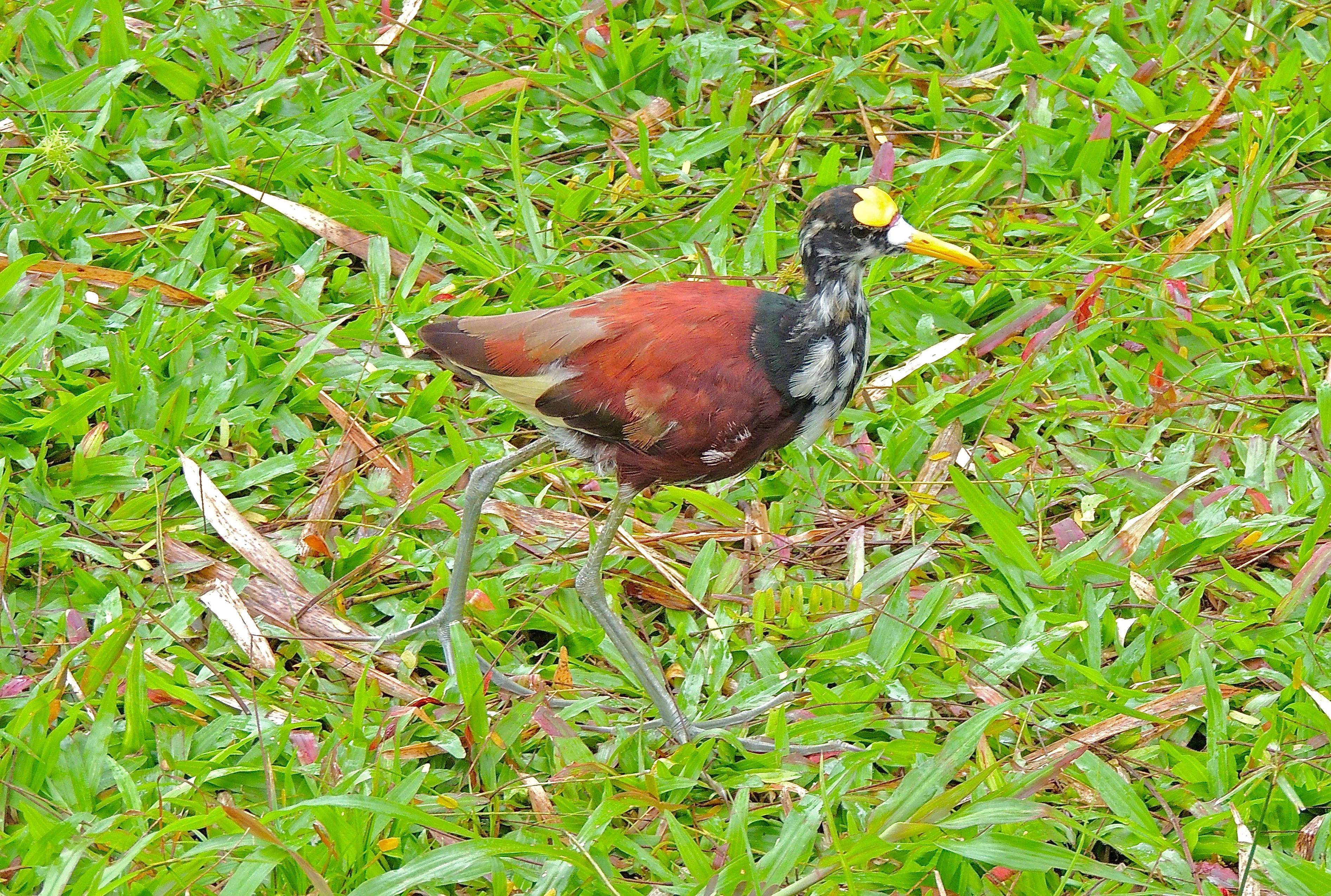 Northern Jacana Juvenile - Photo by William Young
Northern Jacana Juvenile - Photo by William Young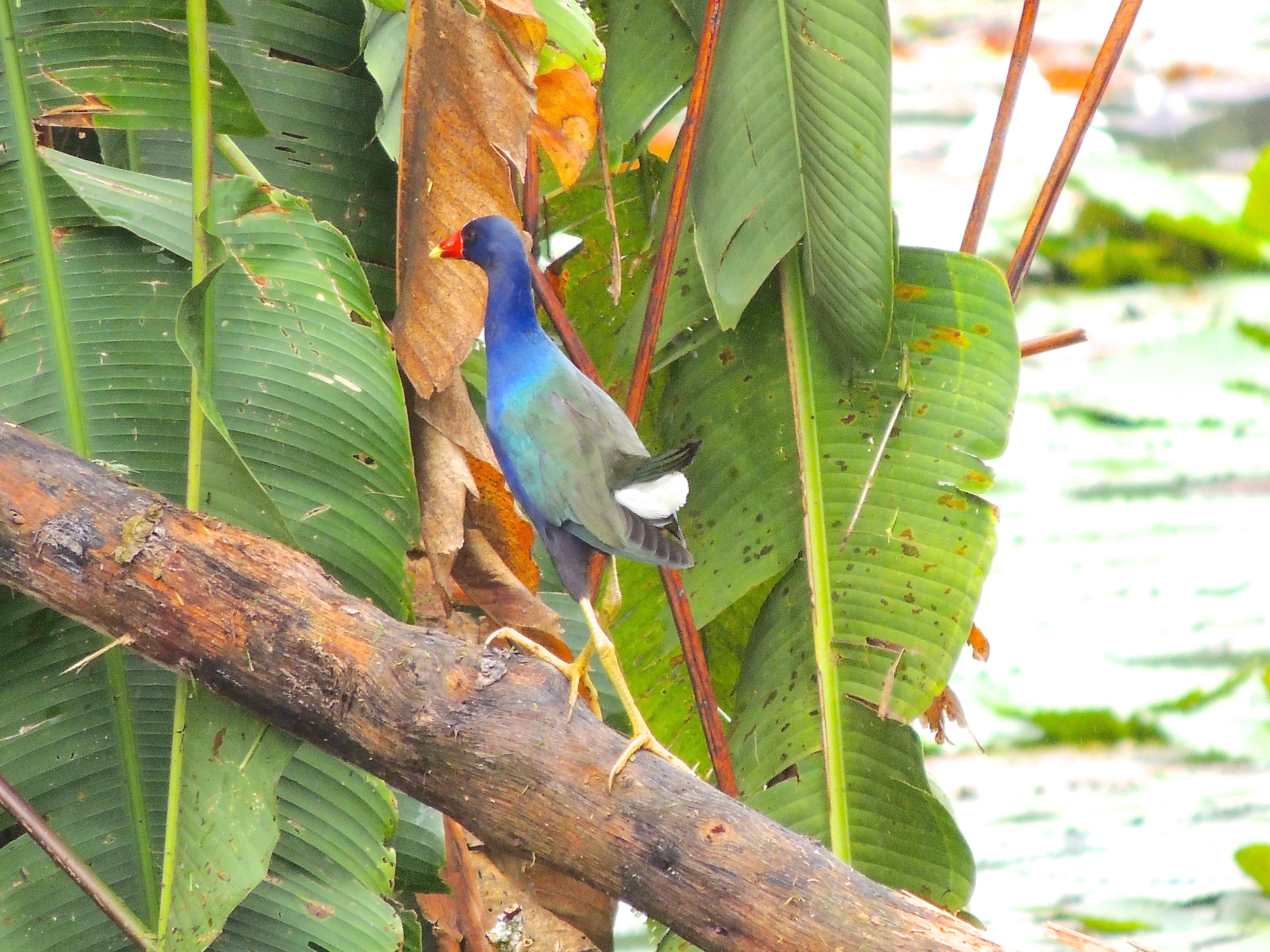 Purple Gallinule - Photo by William Young
Purple Gallinule - Photo by William YoungMercedes found a Double-striped Thick-knee at CATIE, which was a highly unusual place for it to be. It was on a lawn near the lake, and it was not bothered by someone about 25 yards away operating a leaf blower. It had a black stripe and a white stripe above its eye, which is the basis for its name. A lot of the guides from Rancho Naturalista went to CATIE in the afternoon to try to see the bird, but it had departed.
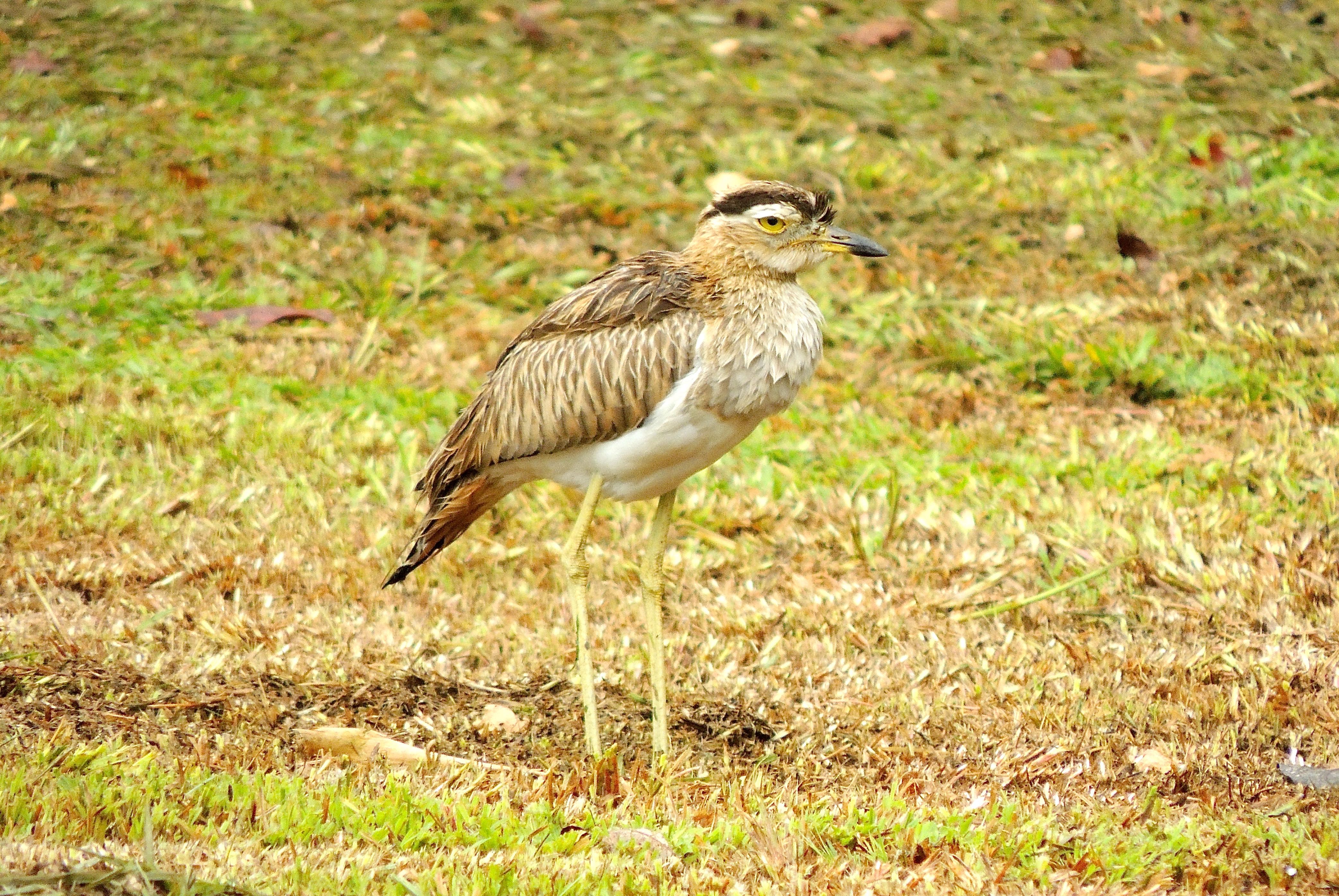 Double-striped Thick-knee - Photo by William Young
Double-striped Thick-knee - Photo by William YoungDoves, Parrots, and Cuckoos
I did not see a lot of any of these birds on the trip. I saw a few Squirrel Cuckoos. They are large, and I heard their loud 2-note call. They have a light bill and white markings on their long black tail. A few Groove-billed Anis flew around at La Mina. Ruddy Ground-Doves were on the ground and on wires at the base of Cerro Silencio. White-tipped Doves came to the ground around the feeders at Rancho Naturalista and at Wayne Easley's house. They have blue skin around the eye. On the road from the airport to Rancho Naturalista, I saw both White-winged Doves and Rock Pigeons. White-winged Doves were in populated areas. I saw Red-billed Pigeons in a few places, including at Casa Turire. We scoped one, and it did not have a red bill. It has a short light-colored bill with some red skin at the base.
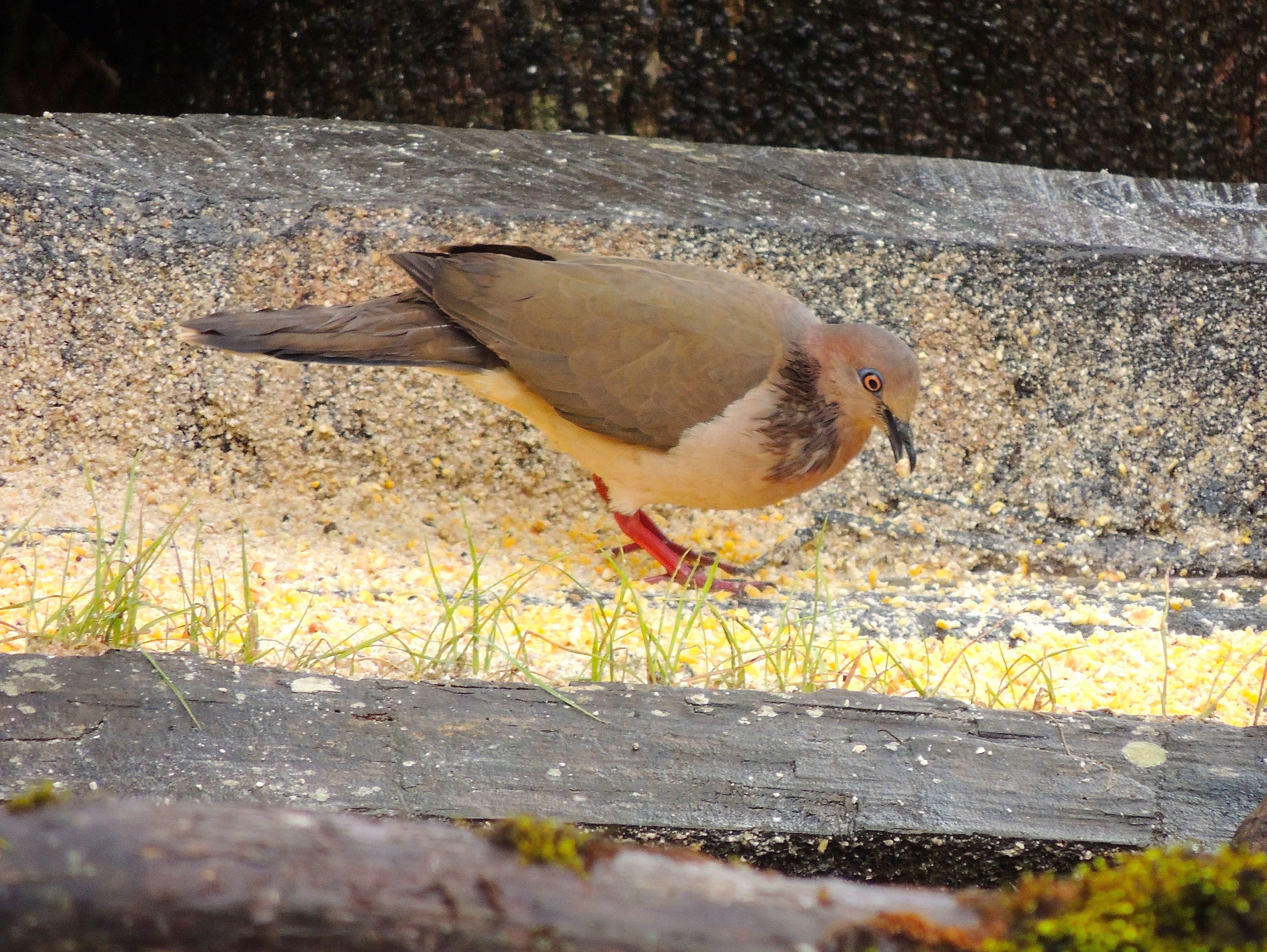 White-tipped Dove - Photo by William Young
White-tipped Dove - Photo by William YoungThe screeching of parrots was a common sound. I saw many more flying Crimson-fronted Parakeets than perched ones. In flight, their underwings look yellowish. Some were perched in a tree at CATIE. I also saw White-crowned Parrots. They are stockier and have a shorter tail than the parakeet. From a distance, they appear to be dark with a white cap. In good light, they are very colorful. They have red skin around the eye, gold and deep blue on their upperwings, and a red vent.
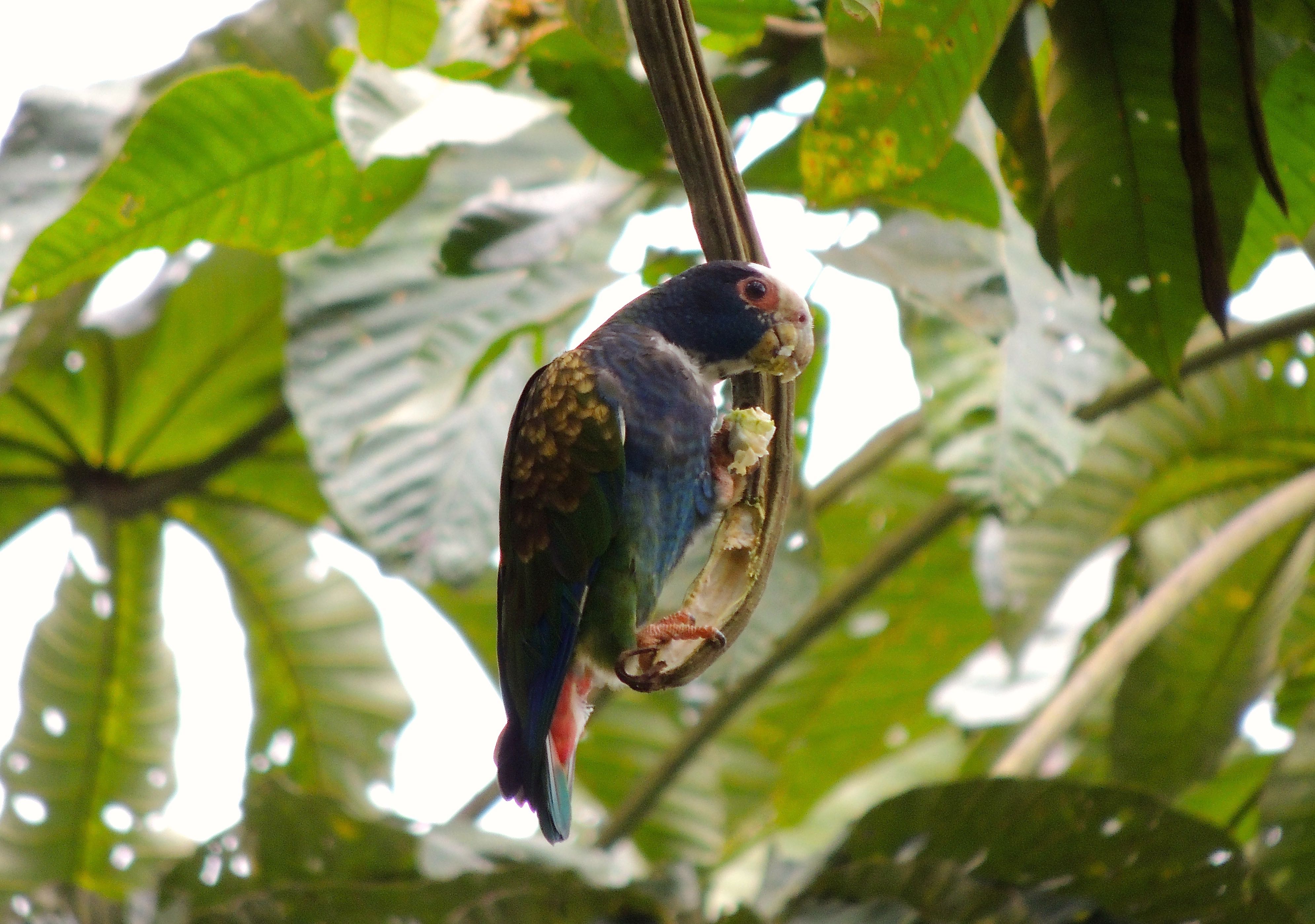 White-crowned Parrot - Photo by William Young
White-crowned Parrot - Photo by William YoungNightbirds and Swifts
I had never seen a Crested Owl, but somebody found one on a morning walk on the lower trails at Rancho Naturalista. I ran into Lisa on the trail, and she took me to the spot. The owl has two buffy ear tufts which start near the base of its bill. The buffy tufts have a black line on the bottom. Someone who saw a photo I took said the owl reminded her of Groucho Marx. After lunch, I returned to the spot, and the owl was still there. It blended in well, and even though it was relatively close, I sometimes had trouble relocating it. On some nights, I heard the slow hoots of a Mottled Owl, but I never saw one. I also heard the haunting laugh of Common Potoos near my cabin at Rancho Naturalista, but I did not see any. The only swifts I saw were White-collared Swifts the day we went to the highlands. They are quite large, and I could see the white collar.
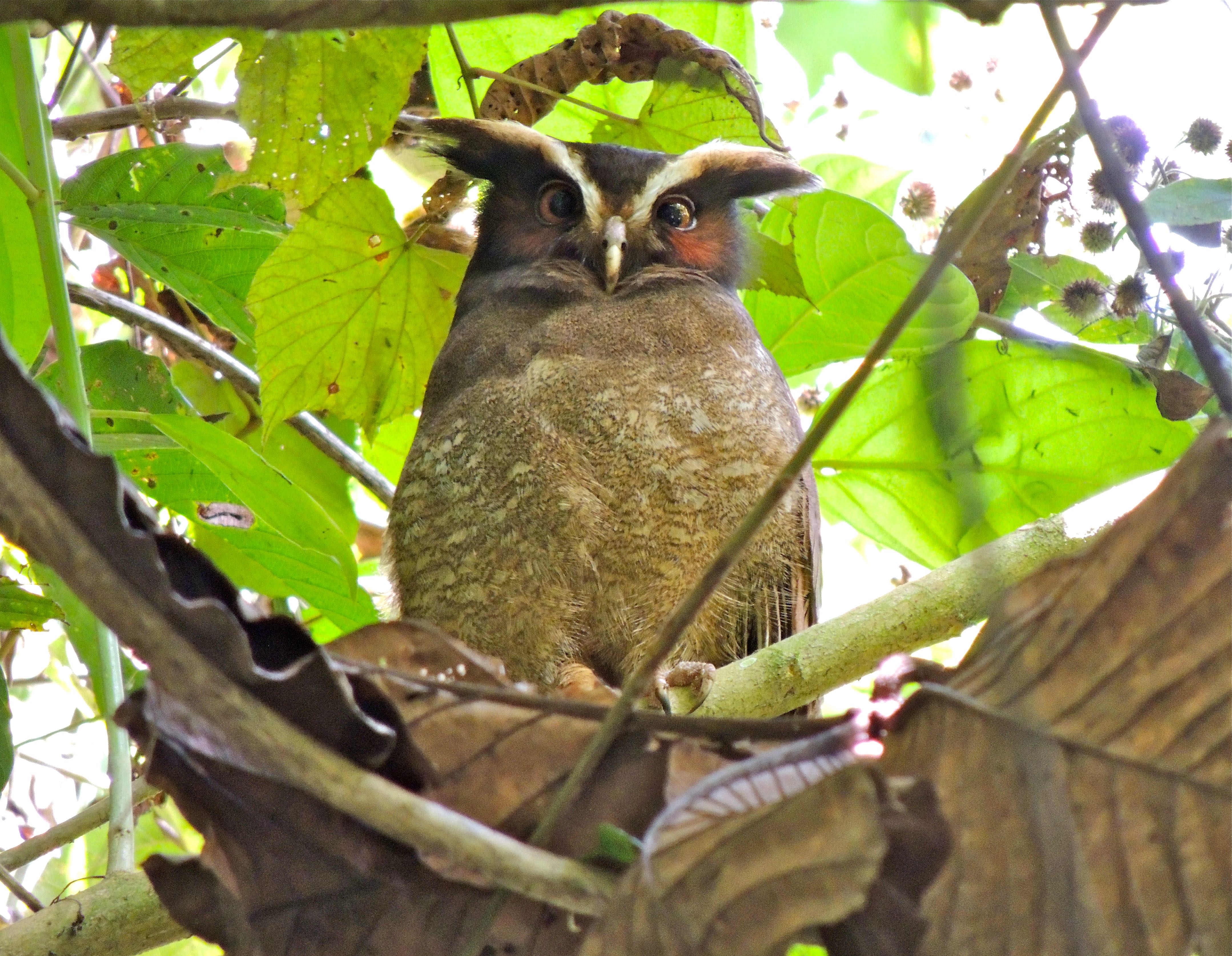 Crested Owl - Photo by William Young
Crested Owl - Photo by William YoungHummingbirds
I saw 17 species of hummingbirds. The one I wanted to see most was a Snowcap, and at least one frequented the verbena bushes outside a door at Rancho Bajo. The male is the color of port wine with a white cap, and it has two white marks on the edge of its tail. It is very tiny. I also saw both males and females bathing at the hummingbird pools. The females are plain. The small hummingbirds moved faster than the larger ones, which made photographing them a challenge. The best hope was to find perched ones.
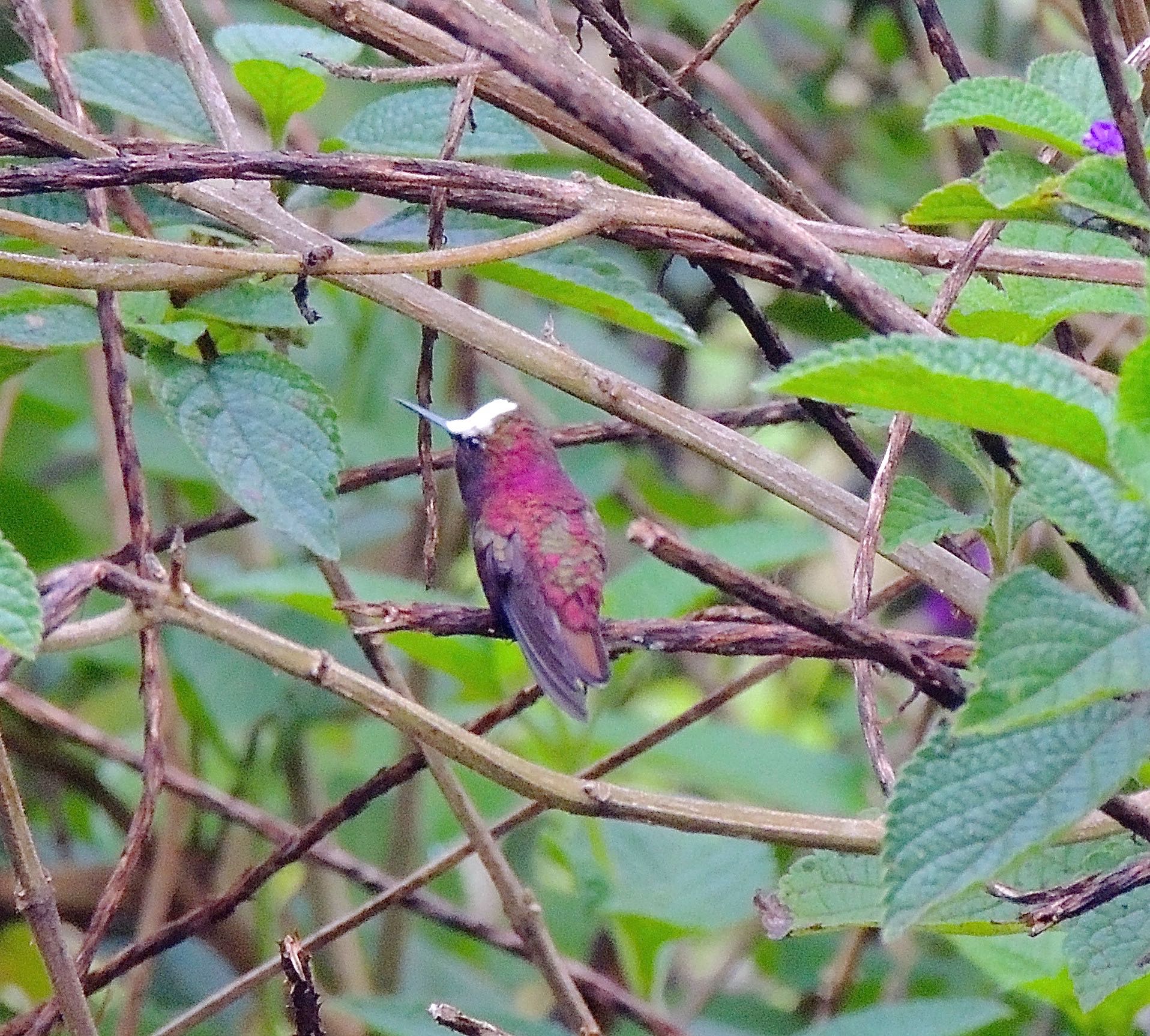 Snowcap - Photo by William Young
Snowcap - Photo by William YoungThe most common species around the feeders at Rancho Naturalista were White-necked Jacobins and Green-breasted Mangos. The Jacobins are very aggressive, chasing other species as well as their own species. The females do not have blue plumage and are spotted on the breast. At Rancho Bajo, I saw a lot of them at feeders, but I never saw any foraging in the bushes on the other side of the house. The male mangos have a dark line down their green underparts. Like the Jacobins, they are aggressive. I saw a pair of males crash into each other, and I heard the contact. The female is more distinctive, with a black line down her white underparts. After the mangos left the feeders, they sometimes went to nearby trees to perch. One afternoon, I watched as a male and female mango repeatedly returned to the same branch and perched together. We saw a female mango at Platanillo sitting on a tiny nest.
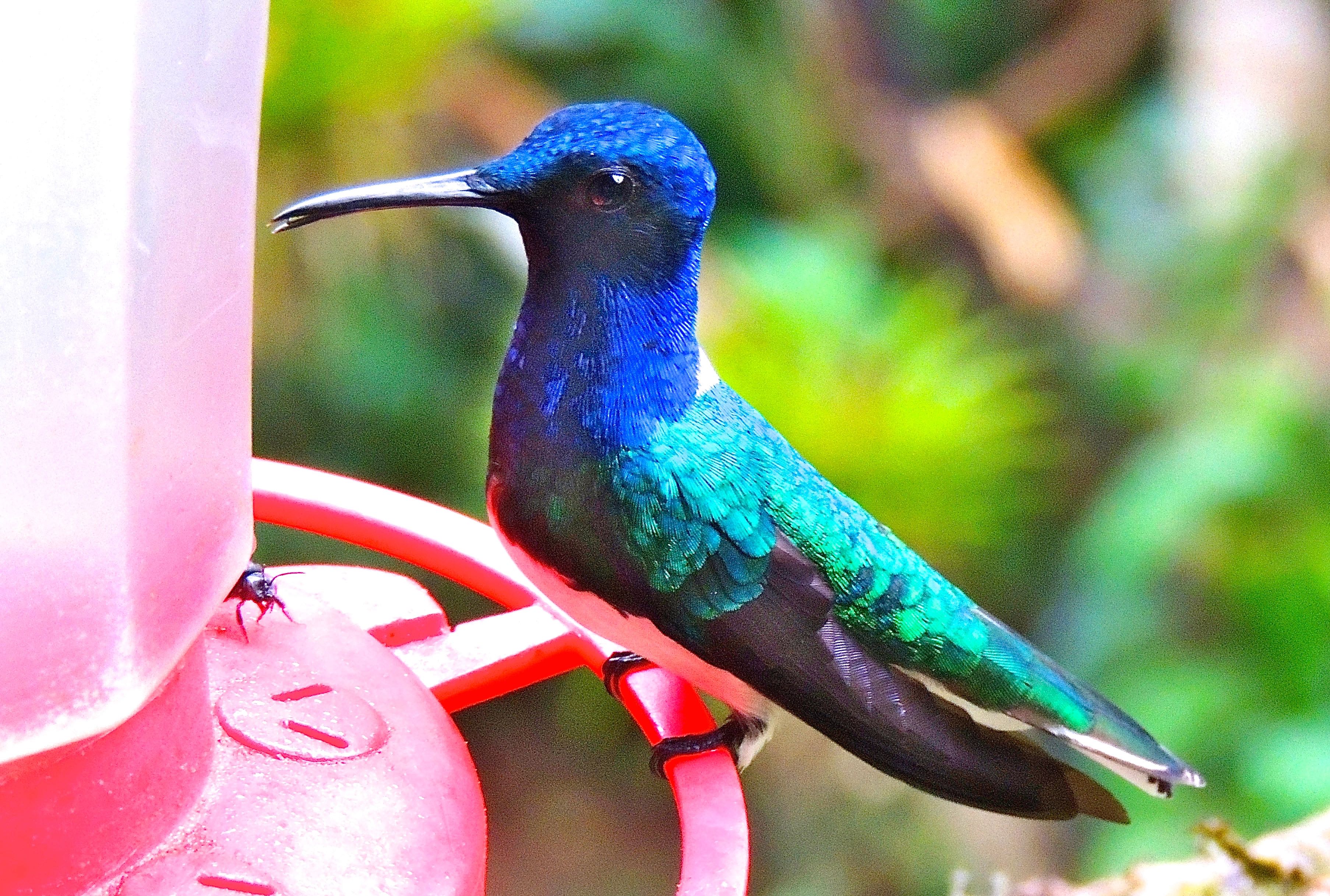 White-necked Jacobin - Photo by William Young
White-necked Jacobin - Photo by William Young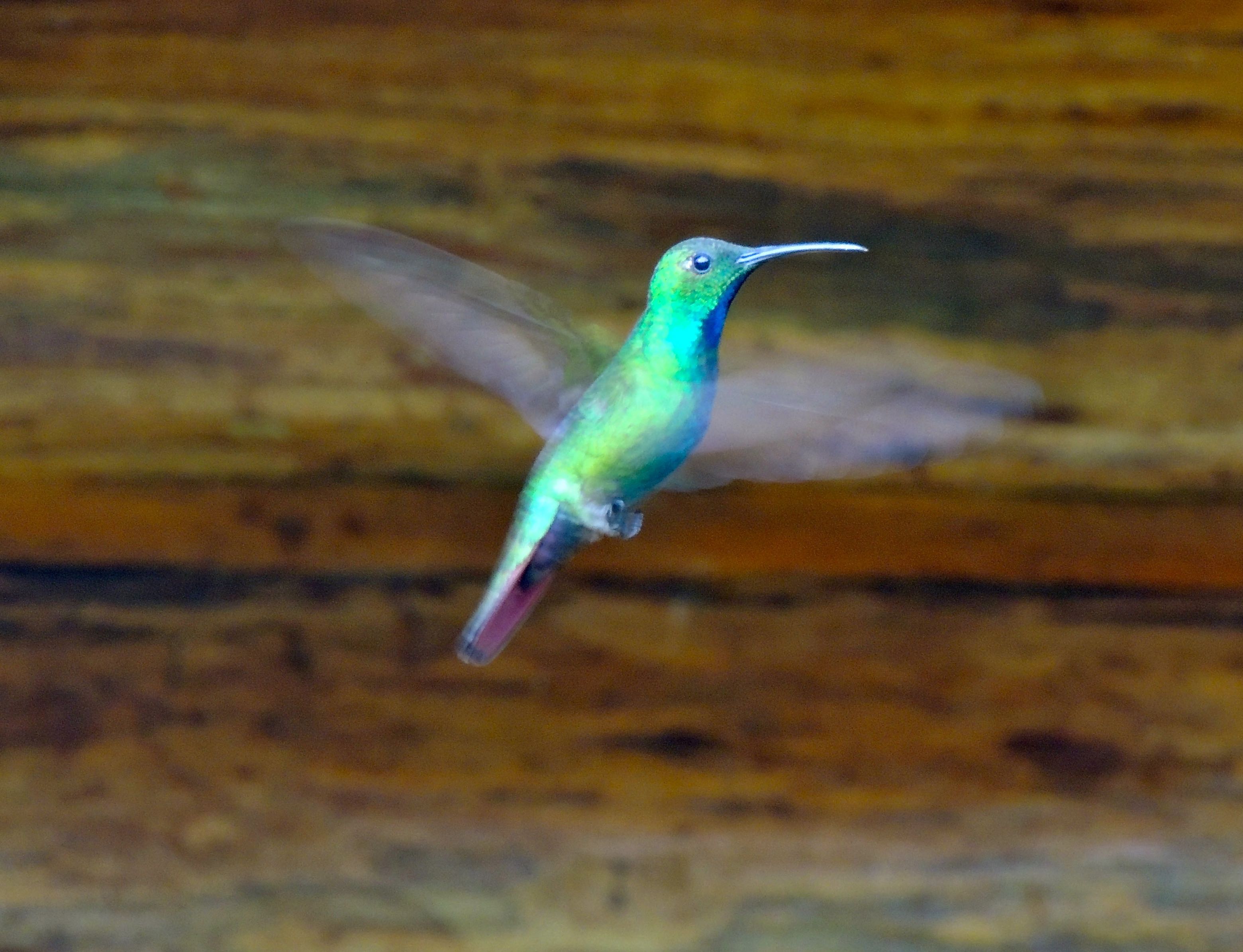 Green-breasted Mango - Photo by William Young
Green-breasted Mango - Photo by William YoungCrowned Woodnymphs came to the feeders. They used to be called Violet-crowned Woodnymphs before being lumped. They have a bright violet crown and an iridescent green throat. Occasionally, a Green Hermit would come to the feeders. It is bigger and longer-looking than the other hummers. The bushes at Rancho Bajo had Stripe-throated (Little) Hermits. They are quite small and brownish, and they have two white marks on the face. Rufous-tailed Hummingbirds were common around Wayne Easley's house. They are the only hummer with both a red bill and a rufous tail. They foraged in the bushes as well as going to feeders.
A few hummingbirds visited the area near the Rancho Naturalista feeders less frequently. One day, we saw a Green Thorntail in a tree over the fruit feeders. I could see the male's long thorn tail and the horizontal white line on his rump. In the same tree was a young Black-crested Coquette, who is tiny and also has a horizontal white rump line. I had previously seen a juvenile Green-crowned Brilliant, who is spotted below and has a long bill, some orange on the chin, and a white spot behind the eye. I saw a couple Violet Sabrewings at feeders along one of the Rancho Naturalista trails. They are large and purple, with a thick white edge to their tail. Purple-crowned Fairies bathed in the hummingbird pools. They perched in the nearby trees before coming to bathe again. There is an observation platform well above where the birds come to bathe, and the fairy appeared to be doing a ballet over the water. They are elegant hummers. A Ruby-throated Hummingbird frequented a bush outside Rancho Bajo. The people in Costa Rica were more excited about seeing it than I was, because I knew I would be seeing a lot of them soon near where I live.
 Ruby-throated Hummingbird Male - Photo by William Young
Ruby-throated Hummingbird Male - Photo by William YoungQuetzal's Paradise in the highlands has a completely different set of hummingbirds. The two most common species at the feeders were Talamanca and Fiery-throated Hummingbirds. The Talamanca (who was split from the Magnificent Hummingbird) is large and has a slower wingbeat than other hummers. The male reminded me of a Crowned Woodnymph. He has a purple crown and a bluish-purple throat. The female is grayish below, and she has a white line over her black cheek. Both the male and female have long bills. The Fiery-throated Hummingbird appears to be covered with iridescent sequins featuring all of the colors of the rainbow. When we were looking at the quetzals, Lisa found a Talamancan Pit-Viper. I noticed that the scales on the snake were similar to the feathers on the Fiery-throated Hummingbird. At certain angles, I could see the hummer's fiery throat. A small number of Lesser Violetears came to the feeders. They used to be part of the species called the Green Violetear before being split. One of them had lighter feathers on the crown and might have been partially leucistic. I found that if I spread my hands near the base of a feeder and stood very still, the hummers would perch on my fingers to drink from the feeders. The wind from their wings was very strong. The Volcano Hummingbirds are tiny. They did not come to the feeders on the deck outside the lodge, but they hung around in the nearby vegetation. We saw a male go to a different set of feeders, but he was quickly chased by a Magnificent. There are different races of Volcano Hummingbirds, and the males are differentiated by throat color. I had a close look at a female who is green on the back, white underneath, and has faint spotting on her throat. Her feathers look more like conventional feathers than like scales.
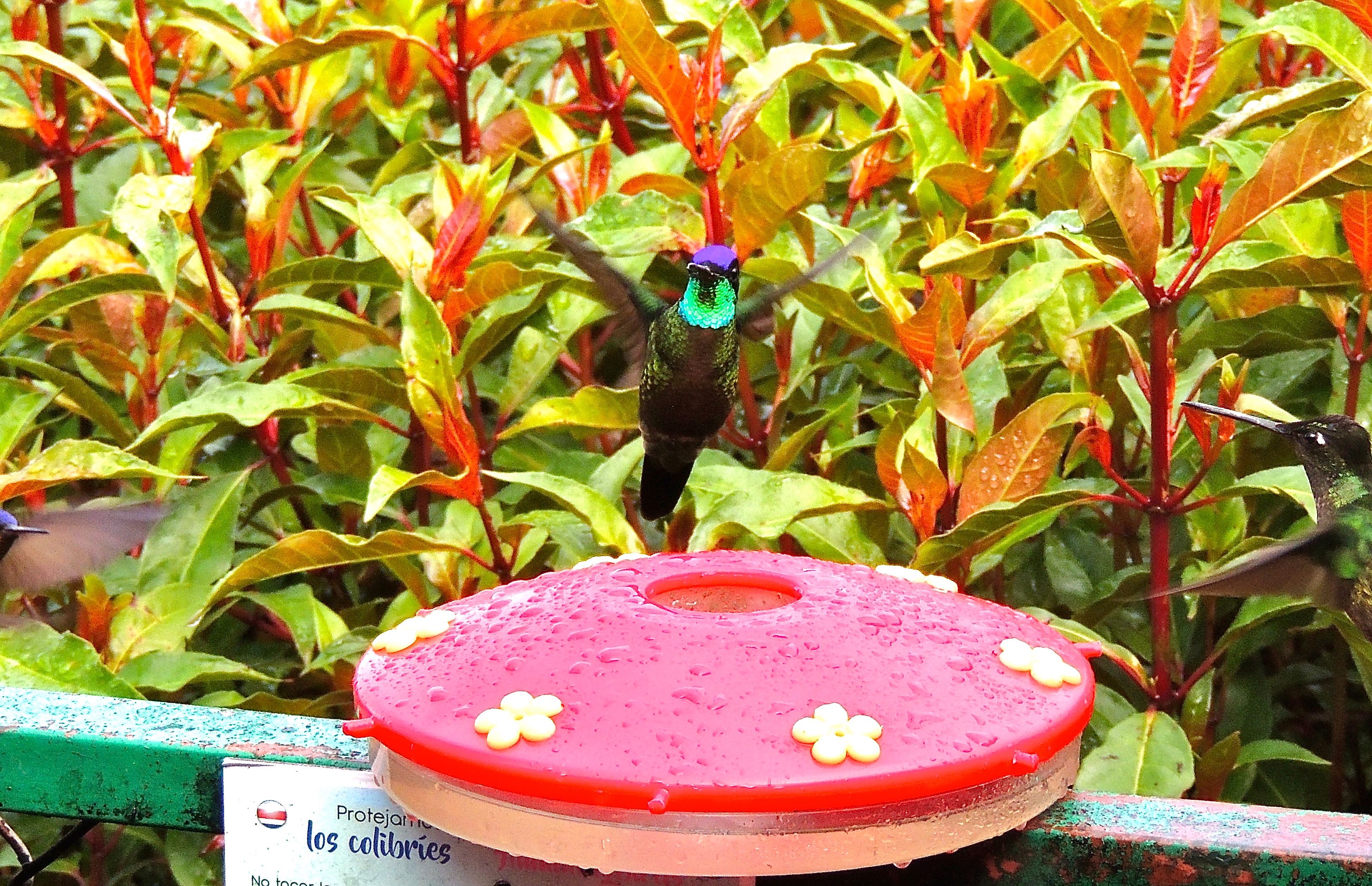 Talamanca Hummingbird Male - Photo by William Young
Talamanca Hummingbird Male - Photo by William Young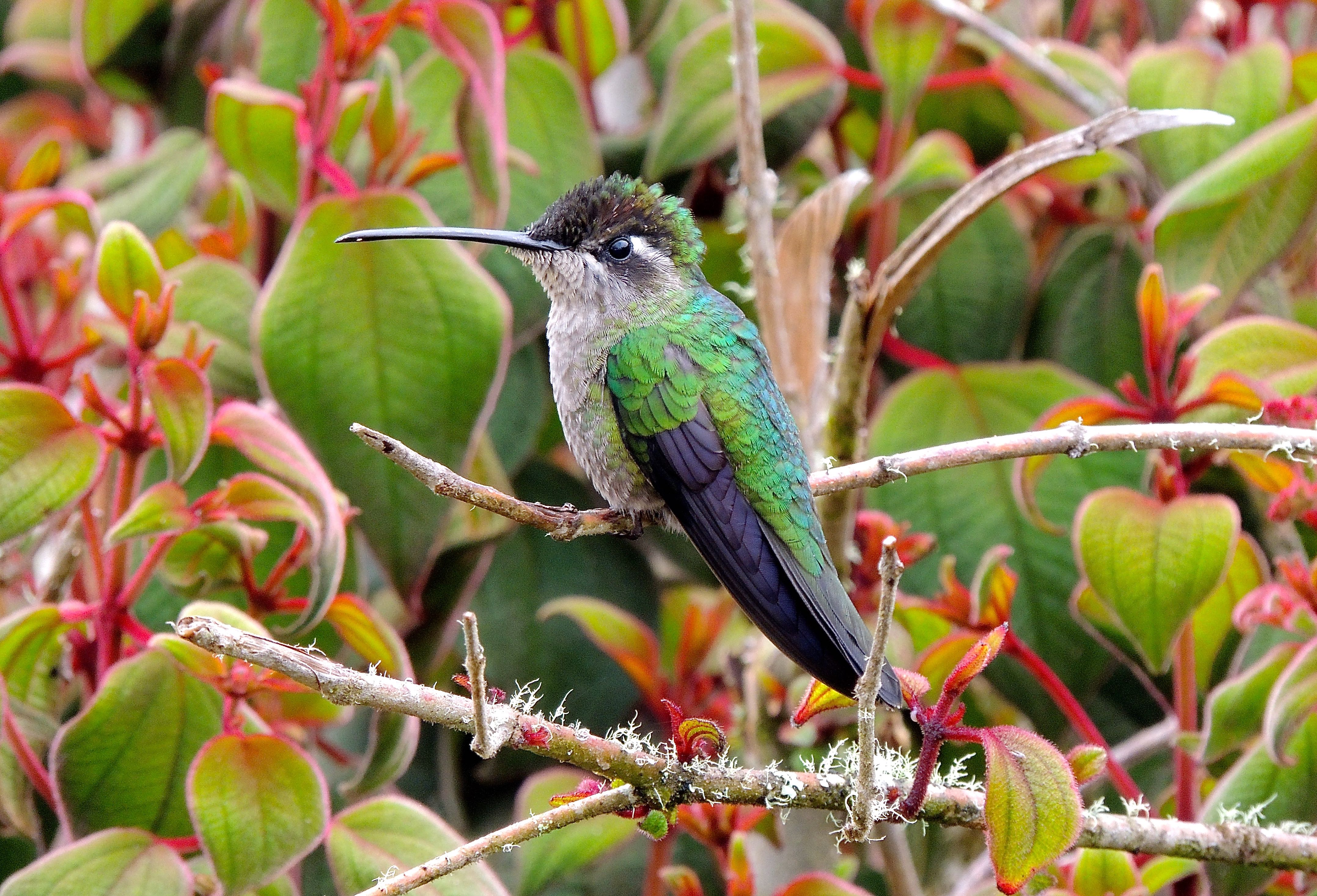 Talamanca Hummingbird Female - Photo by William Young
Talamanca Hummingbird Female - Photo by William Young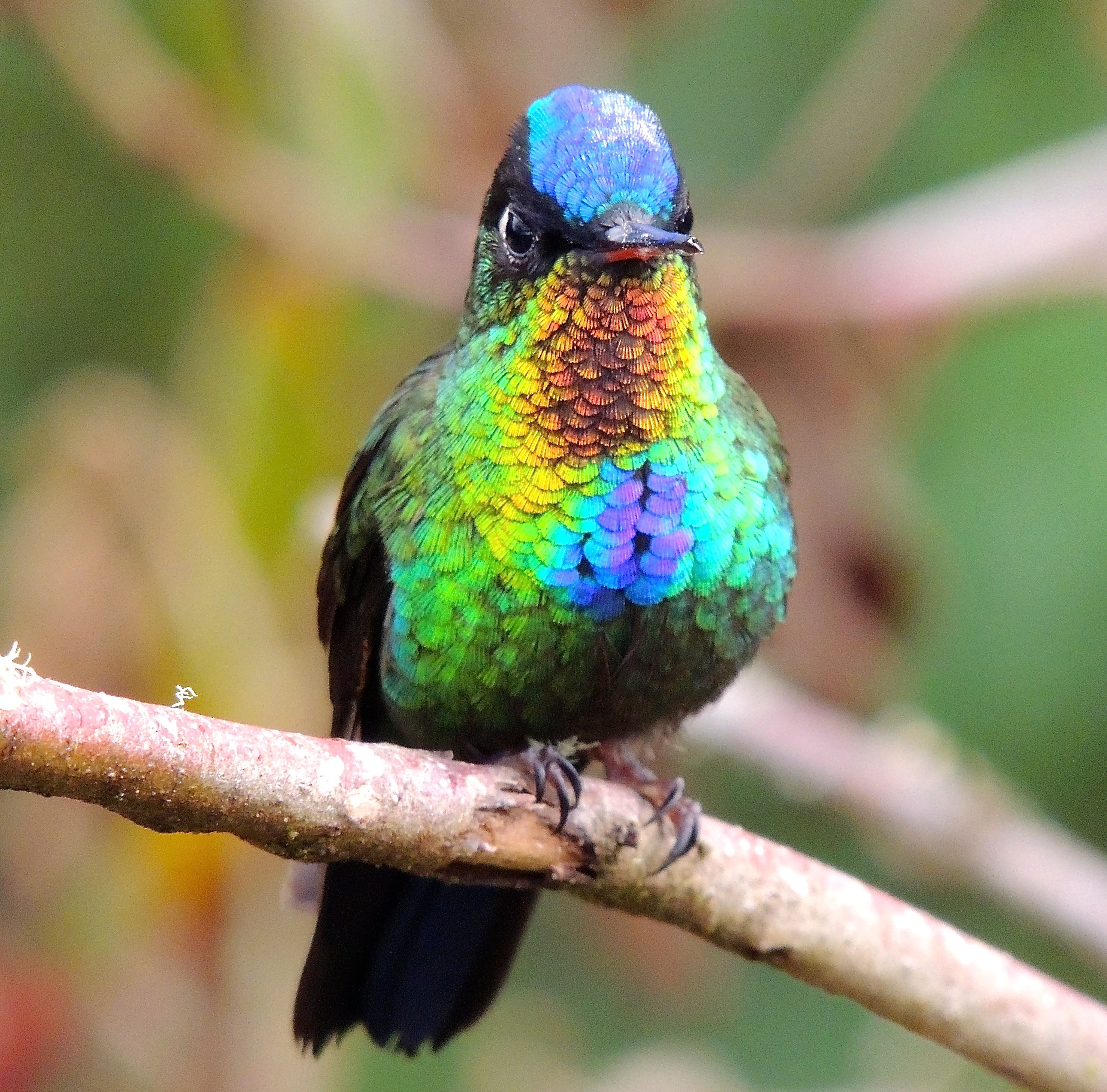 Fiery-throated Hummingbird - Photo by William Young
Fiery-throated Hummingbird - Photo by William Young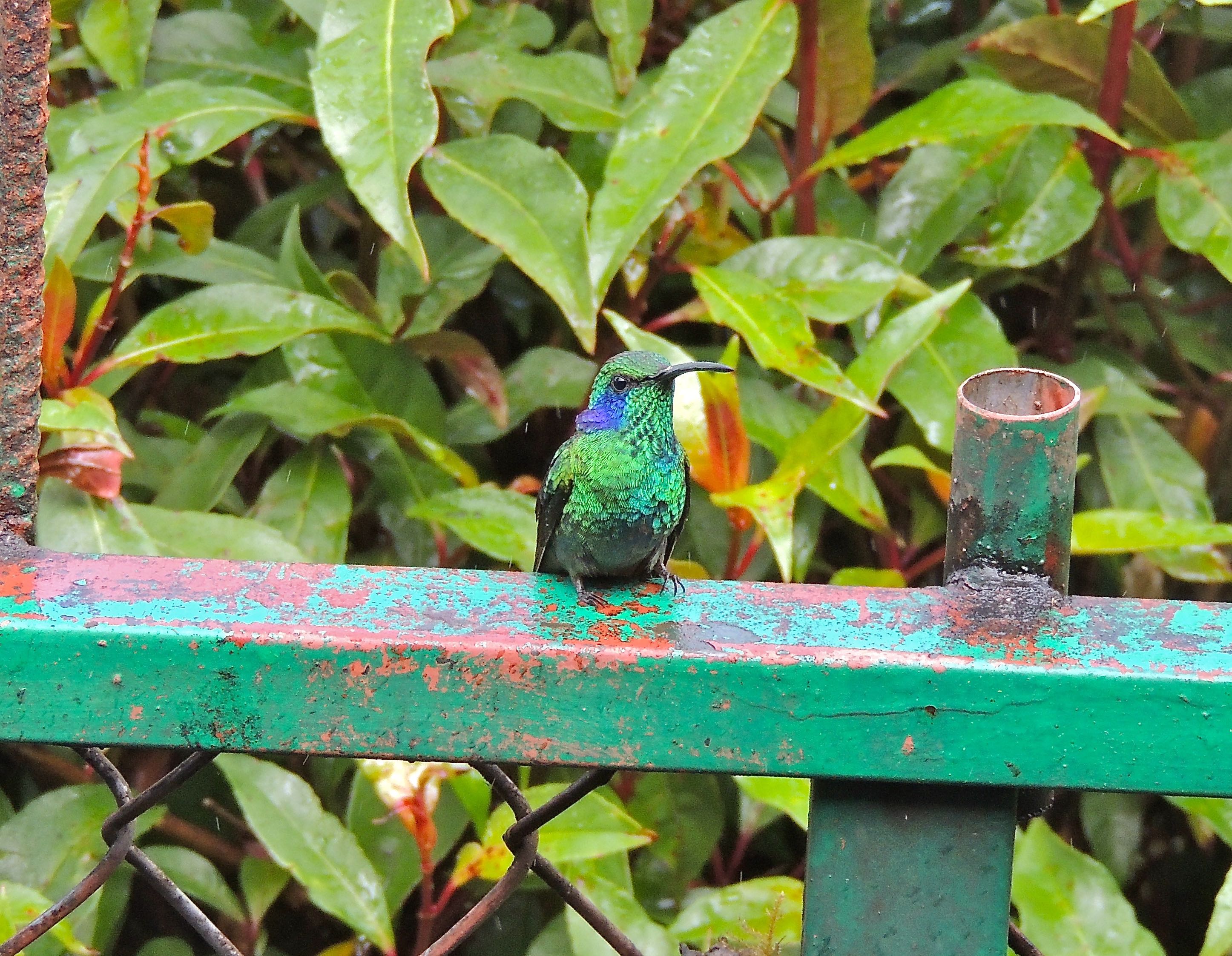 Lesser Violetear - Photo by William Young
Lesser Violetear - Photo by William Young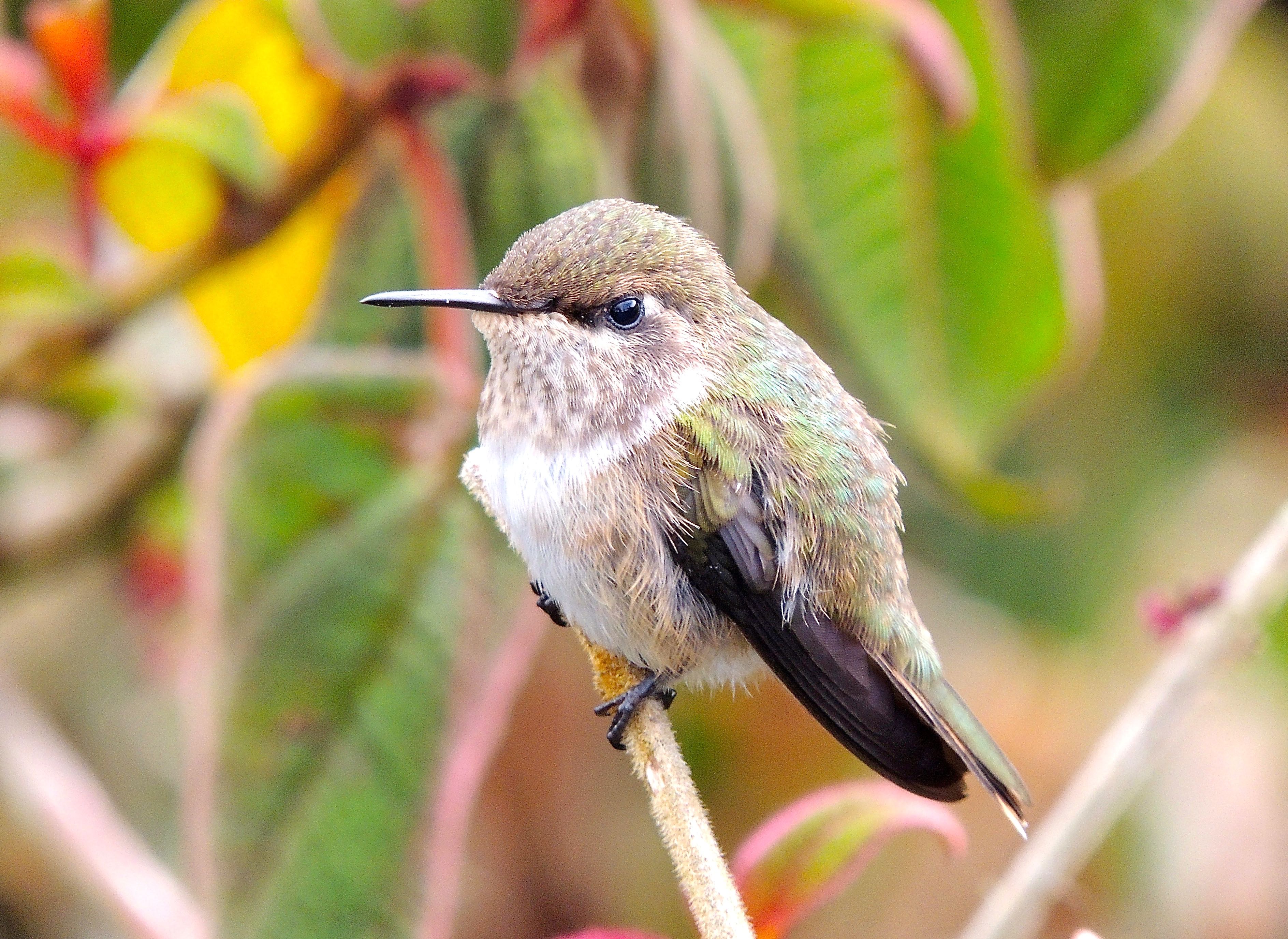 Volcano Hummingbird Female - Photo by William Young
Volcano Hummingbird Female - Photo by William YoungQuetzals and Trogons
The bird I most wanted to see on this trip was a Resplendent Quetzal, one of the spectacular birds in the world. Lisa took me and Mercedes to the highlands, and we saw four in a white avocado tree. There were two adult males, a young male, and a female. The color on the back of the adult male quetzals varied, depending on how the light hit it. From some angles, it looked entirely Day-Glo green. From other angles, I could see blue around the nape and on the breast. The black wings were partially covered by green feathers. The bill is yellow, and the belly is bright red. The male is 14 inches long, but in breeding plumage, he has two bright green plumes that extend another two feet beyond the tail. The adult males have a pure white undertail, while the much plainer females have a black and white undertail. The young males lack the two long plumes. When the adult males flew, their streamers wafted in the wind. Quetzals seem to be slow moving, and they tend to perch in one spot for a long time. I saw one aggressive encounter when the two adult males appeared to fly at each other, but each settled quickly on a different tree. Sometimes when a male would fly, he seemed to be going faster than he actually was because his steamers were swishing quickly. The quetzals sometimes flew to nearby trees and bushes, but they did not fly far.
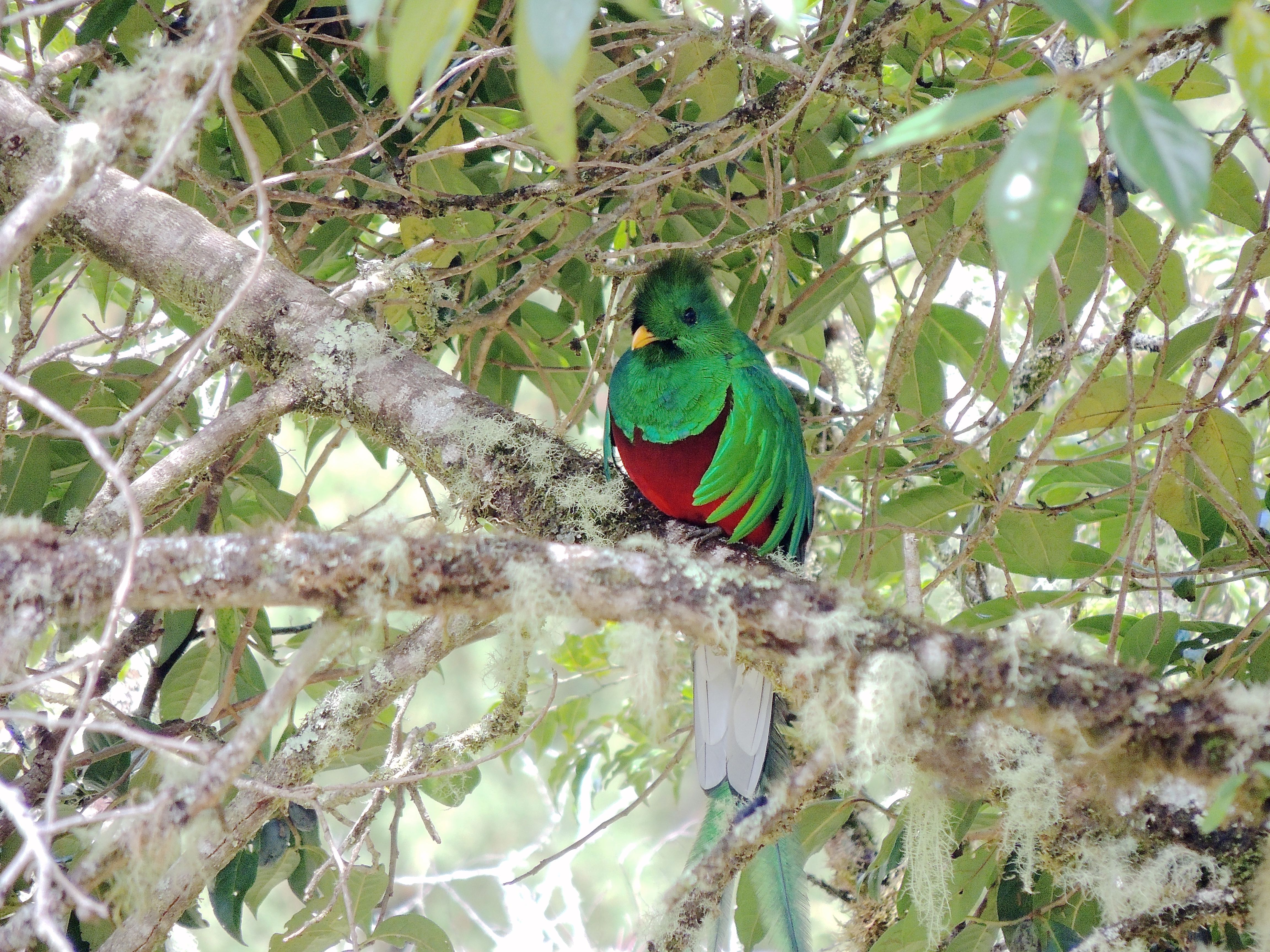 Resplendent Quetzal - Photo by William Young
Resplendent Quetzal - Photo by William Young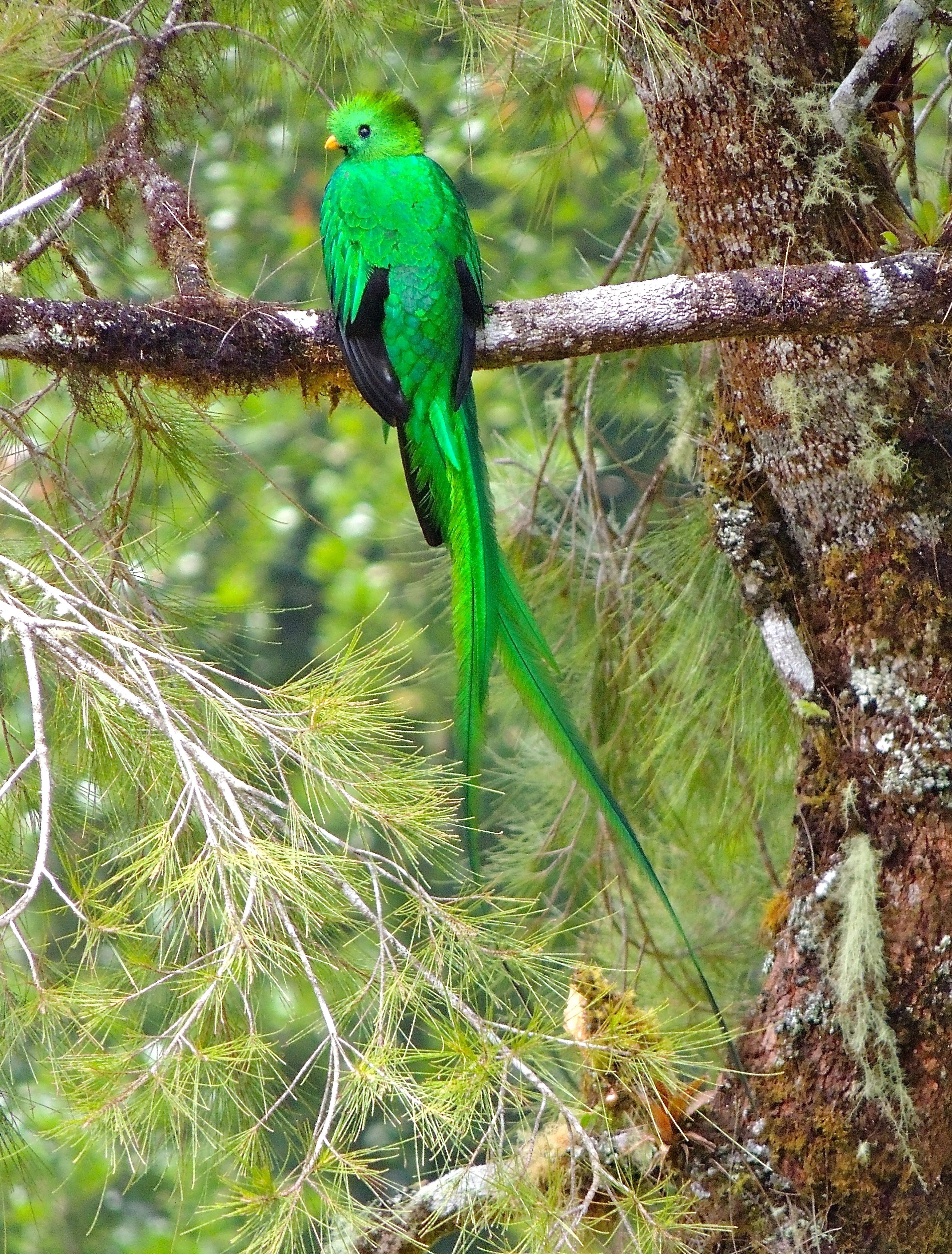 Resplendent Quetzal - Photo by William Young
Resplendent Quetzal - Photo by William Young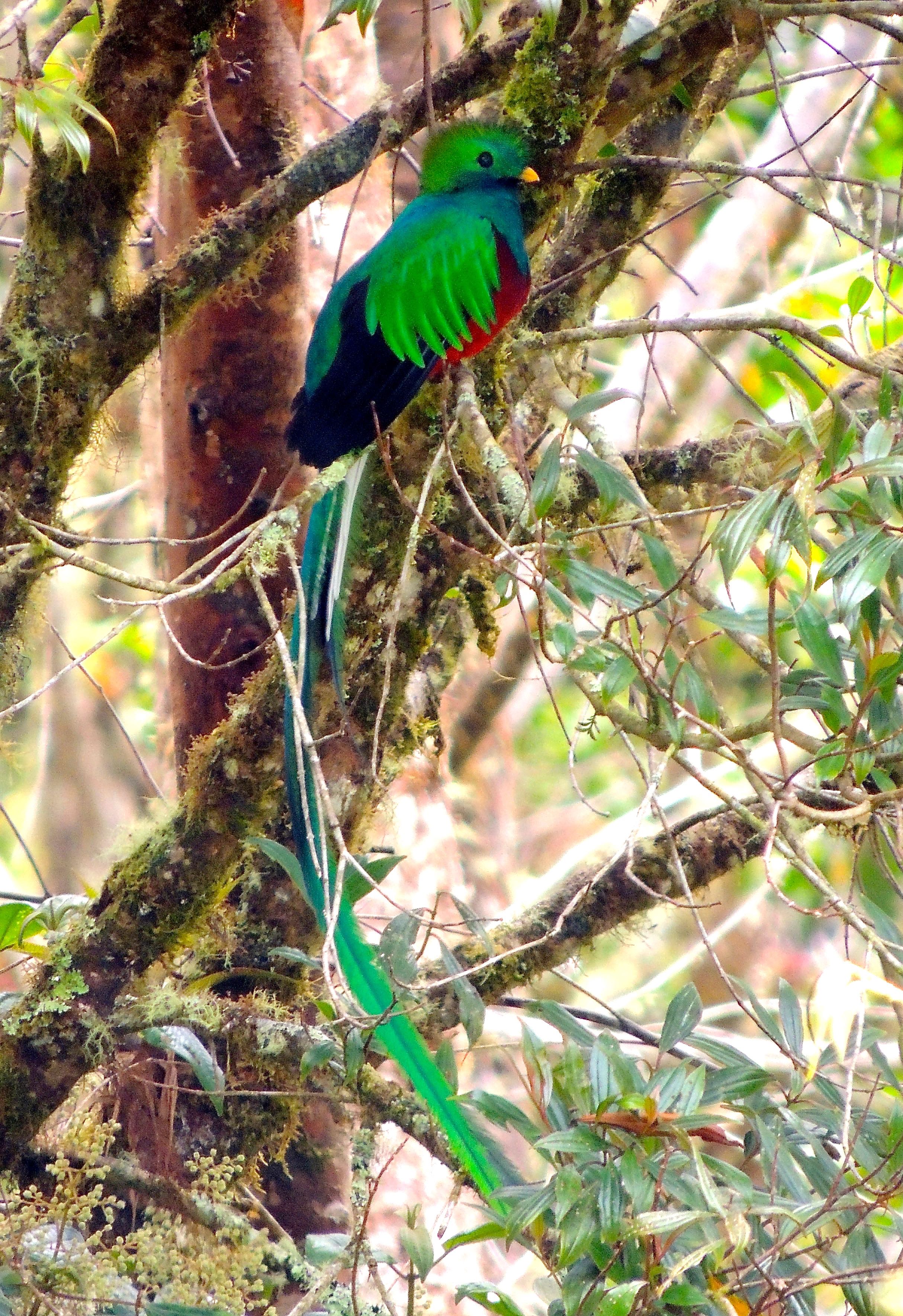 Resplendent Quetzal - Photo by William Young
Resplendent Quetzal - Photo by William Young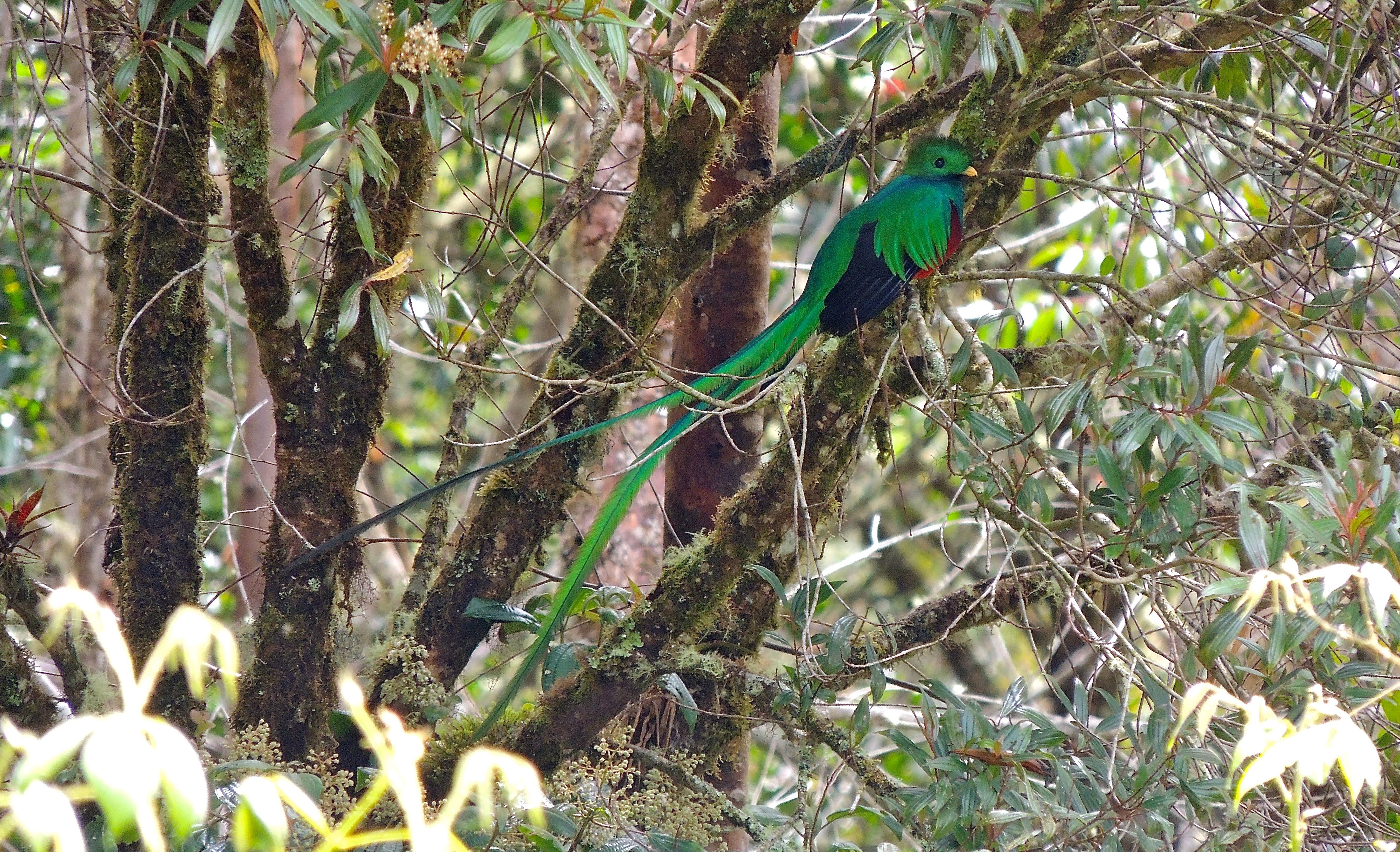 Resplendent Quetzal - Photo by William Young
Resplendent Quetzal - Photo by William YoungThe only trogons I saw were Gartered Trogons. A male-female pair was in a tree by the road leading to Rancho Naturalista. Mercedes and I saw another male-female pair on our drive toward Casa Turire. This species was split from the Violaceous Trogon. The male has a violet-blue back, a yellow belly, a black-and-white undertail, and a light blue eyering. Its call is a long series of separate notes. Trogons often perch in the same spot for a long time.
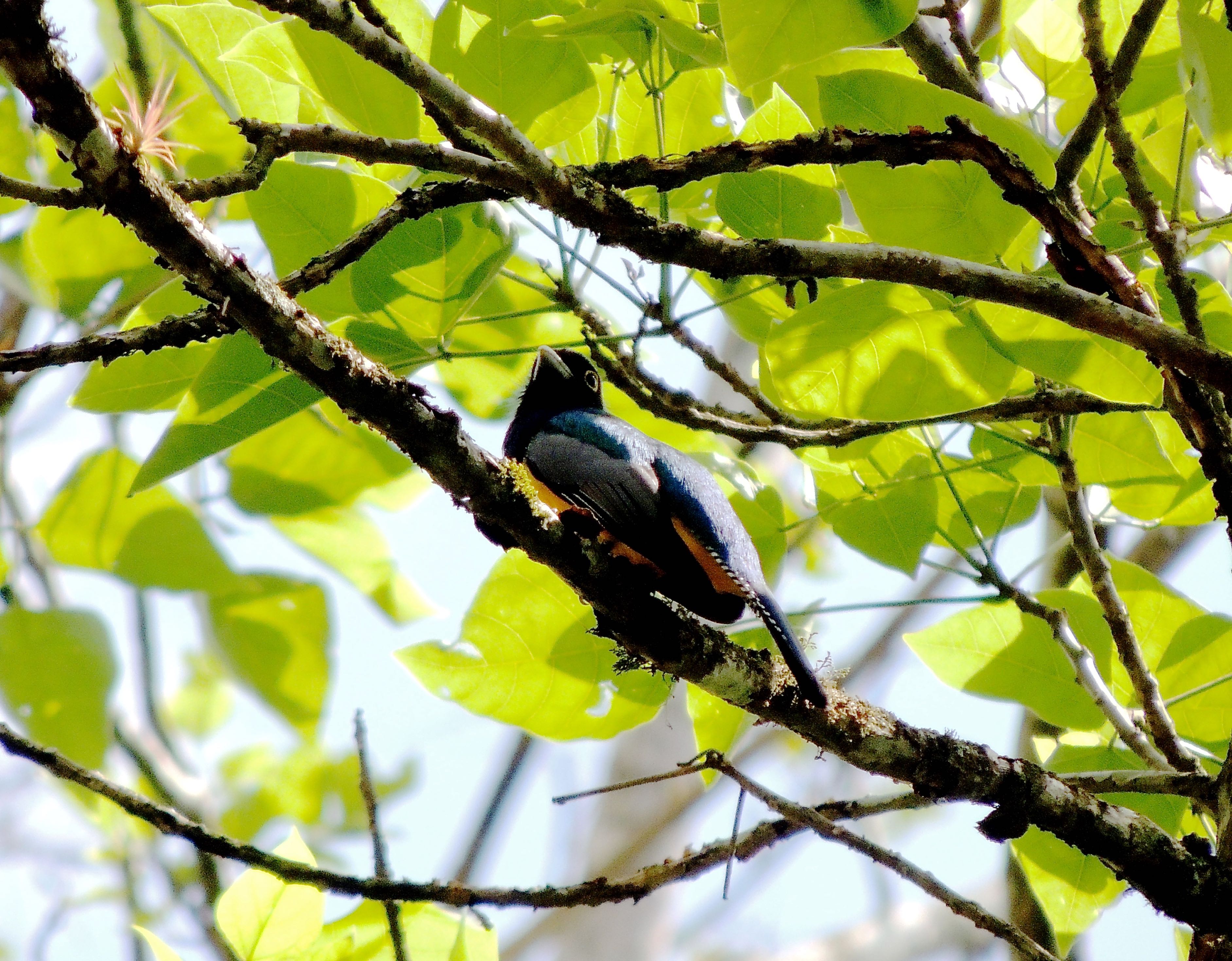 Gartered Trogon - Photo by William Young
Gartered Trogon - Photo by William YoungKingfishers, Motmots, Toucans, and Jacamars
I saw three species of kingfishers. The Amazon Kingfisher is large with a plain green back. I saw one who had caught a large fish. At La Mina, two were chasing each other. The Green Kingfisher is smaller and has white spots on the wings. The males of both species have rufous on the breast, while the female does not. This is the opposite of the Belted Kingfisher, whose female has a rufous band on her breast. At Casa Turire, we saw Ringed Kingfishers chasing each other. The male is all rufous below, while the female has a blue band above her rufous belly. On my first full day, I saw a male-female pair of Rufous-tailed Jacamar on the trails at Rancho Naturalista. They look like large hummingbirds.
A main component of the soundtrack for the trip was the frog-like vocalizations of Keel-billed Toucans. I did not see many, but I heard them frequently. I had good looks at some around Wayne Easley's house. On my first morning of birding, I saw Collared Aracaris in a cecropia tree over the pond at Rancho Naturalista. On my final day, I saw one on the roof of the cabin where I had stayed. Along Rio Tuis, Mercedes and I ran into some young women from Texas, and we showed them an aracari in the telescope. They were excited and asked if we would wait until they got some of their friends to see it. We said we would not, but that we would be birding along the road. When their friends came about ten minutes later, a Keel-billed Toucan was perched near the top of a hill, so we let them look at it in the telescope. They were happy about seeing the Fruit Loops bird.
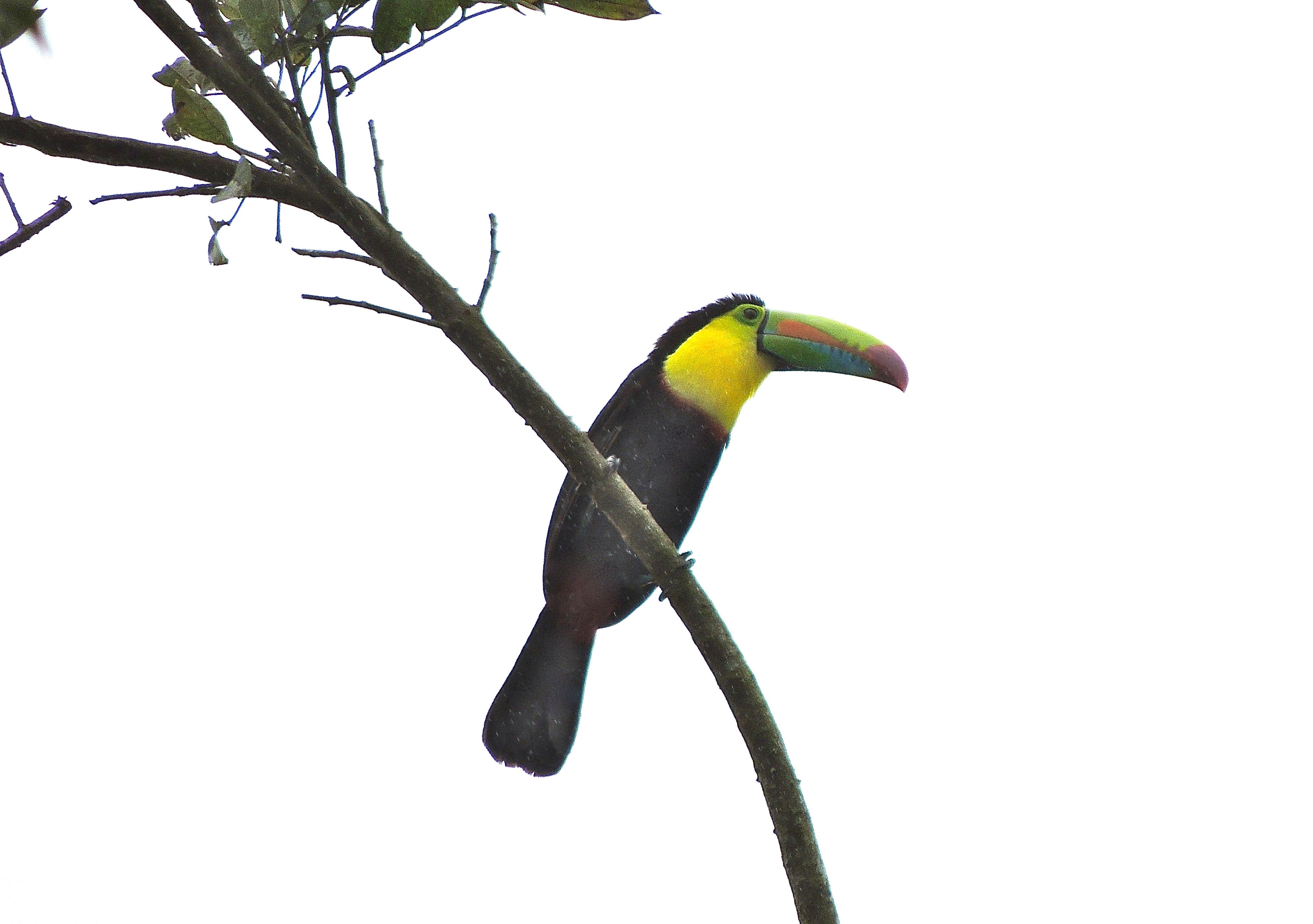 Keel-billed Toucan - Photo by William Young
Keel-billed Toucan - Photo by William Young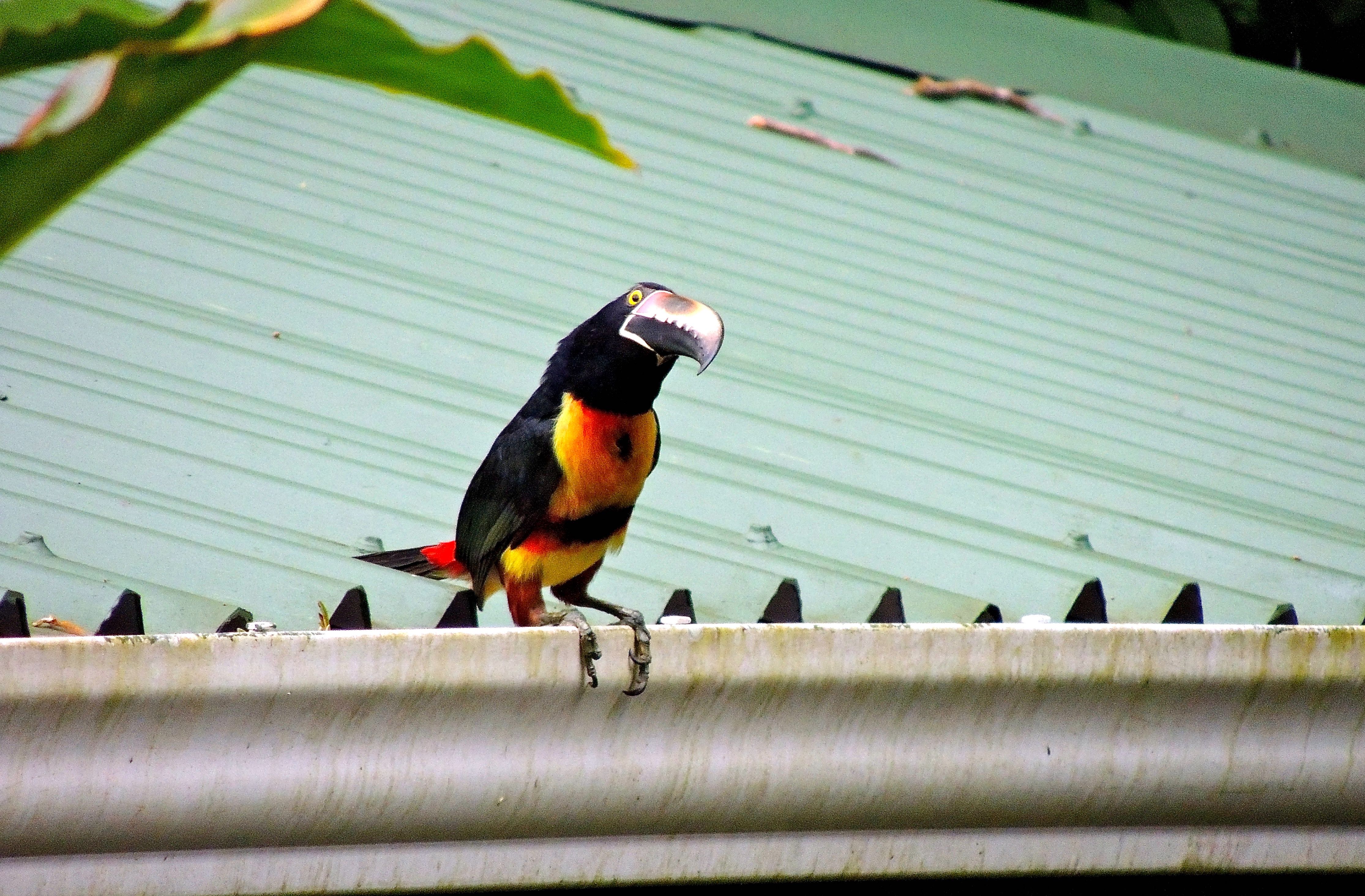 Collared Aracari - Photo by William Young
Collared Aracari - Photo by William YoungMercedes has a Lesson's Motmot on her business card because it is her favorite bird. This beautiful bird was split from the Blue-crowned Motmot. On my final day in Costa Rica, she met me at 5:15 and we walked to Wayne Easley's house where a Lesson's Motmot regularly came to the feeders in the morning. When it showed up, it sometimes lifted its tail and waggled the two rackets back and forth. We had heard its whoop-whoop call when we were walking to Wayne's house, and we saw a backlit motmot in a tree. Four days earlier when I was at Wayne's house, I saw a Rufous Motmot come to the feeders. After getting something to eat, it perched above the feeders for awhile. It seemed sluggish. Its rolling call is one of the archetypal sounds of Neotropical rain forests. The black spot on its rufous breast looks like a passageway to its heart. The Lesson's Motmot has a similar black spot.
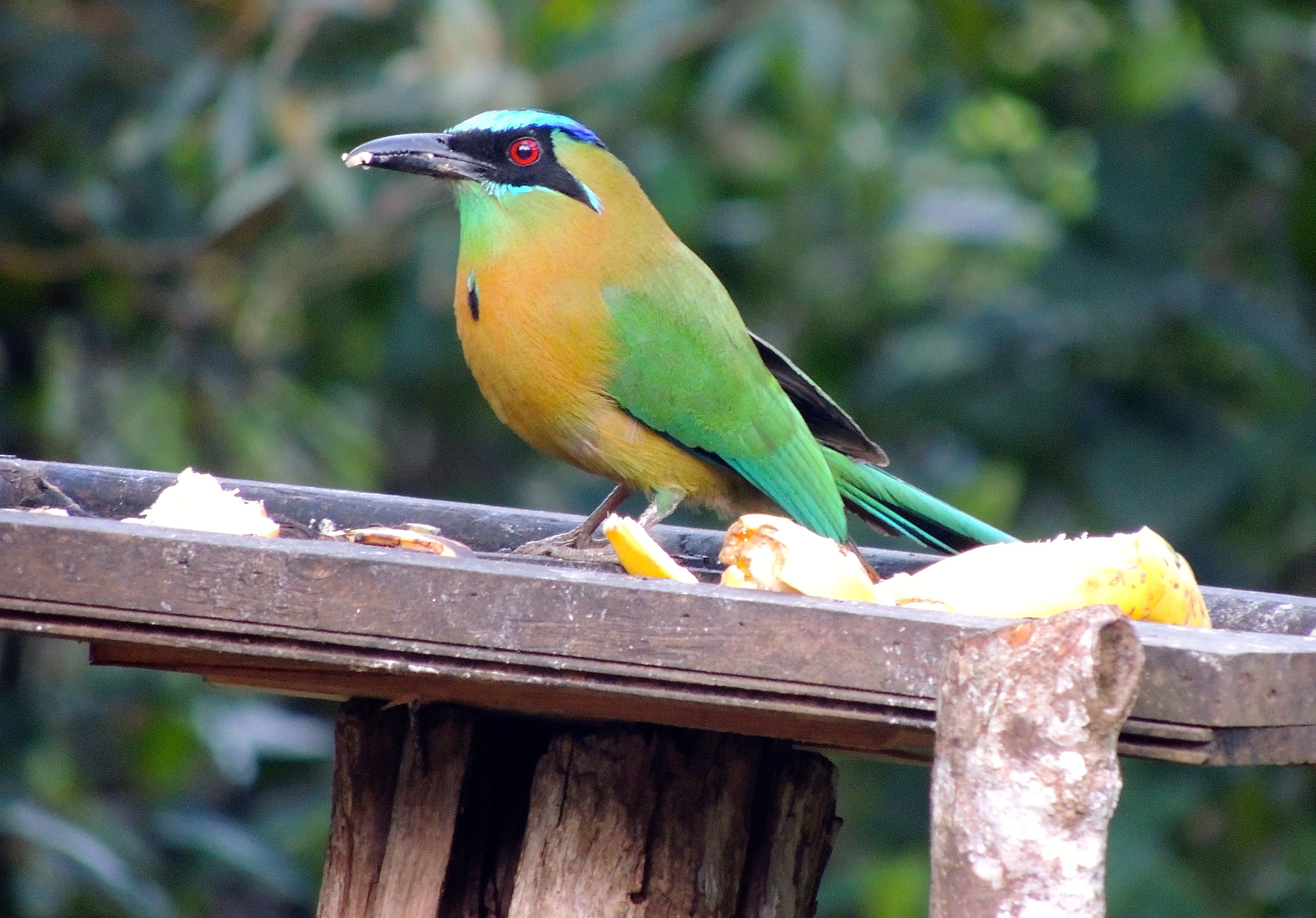 Lesson's Motmot - Photo by William Young
Lesson's Motmot - Photo by William Young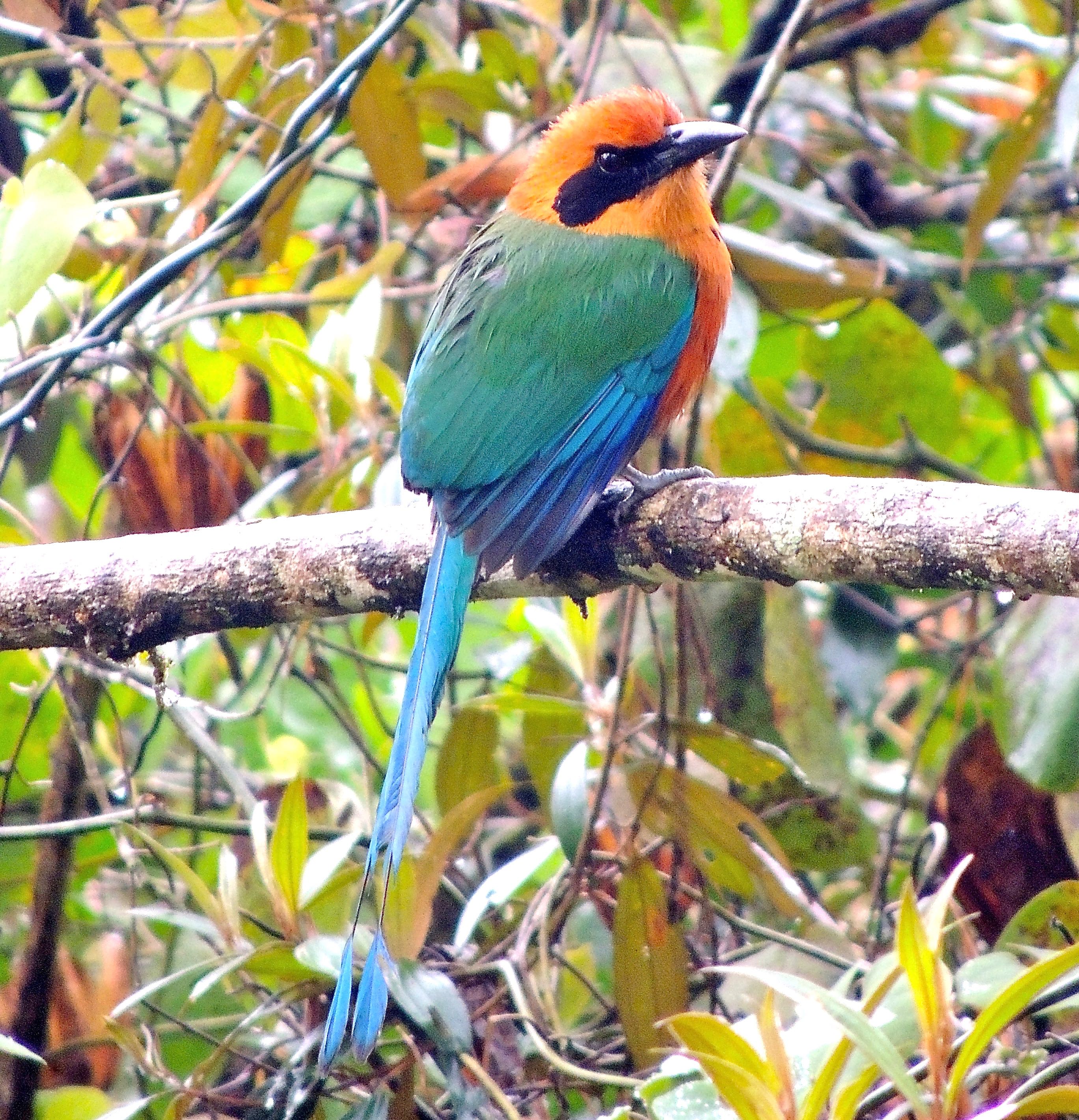 Rufous Motmot - Photo by William Young
Rufous Motmot - Photo by William YoungWoodpeckers, Ovenbirds, and Antbirds
I did not see many woodpeckers on the trip. On my final day, I had a close look at a male Golden-olive Woodpecker busily working on a branch in the pastures around Rancho Naturalista. He has a gray cap, a whitish face, a red malar stripe, a striped golden belly, and a solid olive back. On a walk on the upper trails, we heard a Lineated Woodpecker but did not see one. A Black-cheeked Woodpecker came to the Rancho Naturalista feeders on my final day, and I had earlier seen one frozen on a tree trunk on the road up to Rancho Naturalista.
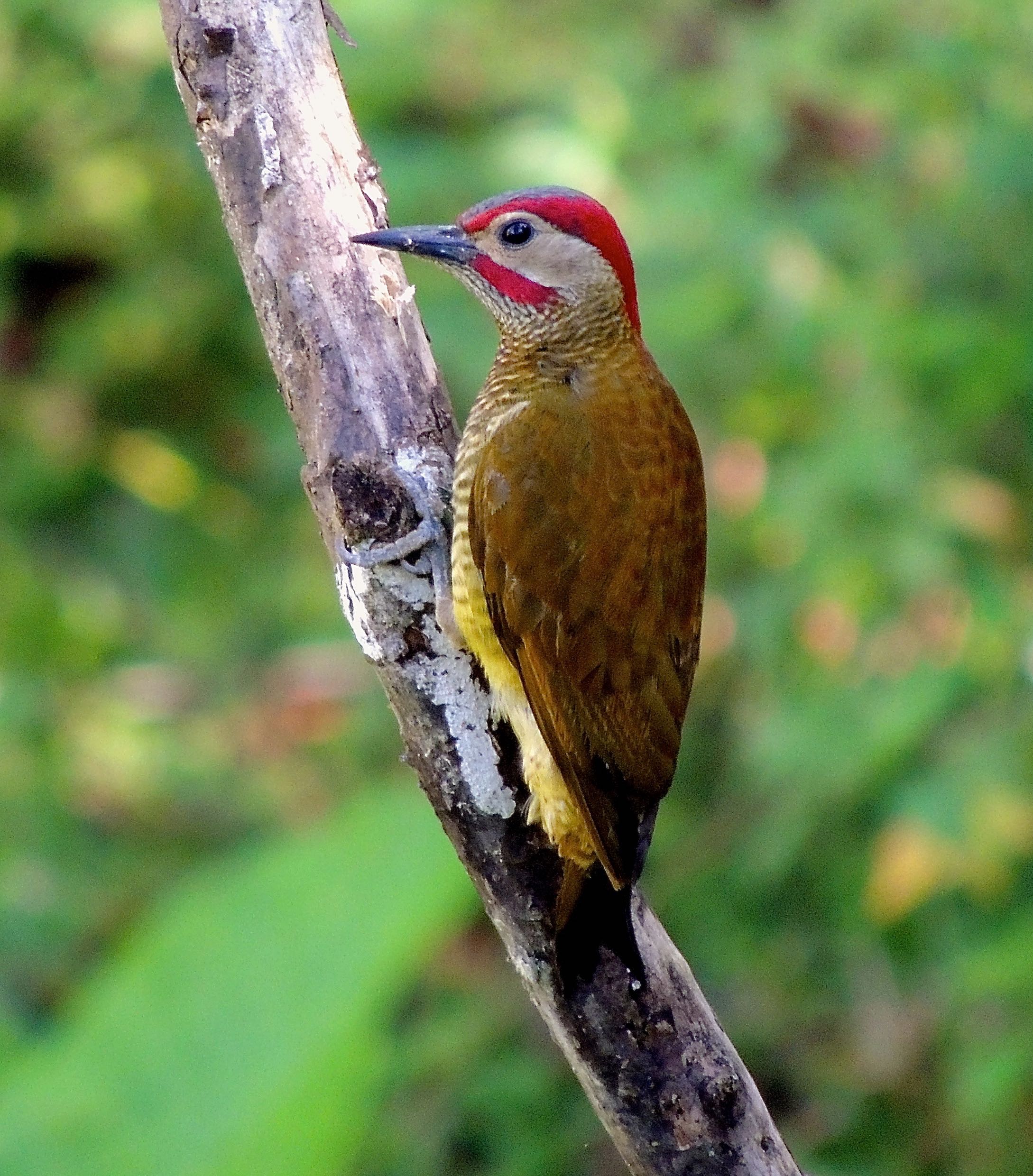 Golden-olive Woodpecker - Photo by William Young
Golden-olive Woodpecker - Photo by William YoungWoodcreepers were more common than woodpeckers. Streak-headed Woodcreepers were in a number of places. They look and sound like Cocoa Woodcreepers, who were also around but are a little smaller and have a narrower bill. The call is a long loud series of clear notes that rise and then fall. A Spotted Woodcreeper was on the lower Rancho Naturalista trails on my first full day. It has spots rather than streaks, and its bill is shorter than a Cocoa Woodcreeper's. On the same walk, I saw a Plain Brown Woodcreeper, who has no spots or streaks. All of these birds look very much alike and are difficult to tell apart. At Wayne Easley's house, I saw a pair of Northern Barred Woodcreepers, who are larger than the others and have faint black barring on their breast and back that is difficult to see. One of the easier ones to identify is the Olivaceous Woodcreeper, who is much smaller than the others and has an olive head. Another small one is the Wedge-billed Woodcreeper, who is brown and has a small bill like the Olivaceous. The Wedge-billed Woodcreeper is easily distinguishable from the other woodcreepers, but it looks and behaves a bit like a Plain Xenops. We heard a xenops near the hummingbird pools but did not see one. The only ovenbirds I saw at Rancho Naturalista were Buff-throated Foliage-gleaners, who regularly hung around the moth light. I saw them all three mornings I went to the light. At Quetzal's Paradise, we saw a Ruddy Treerunner, who is large and bright rufous. It flitted around quickly.
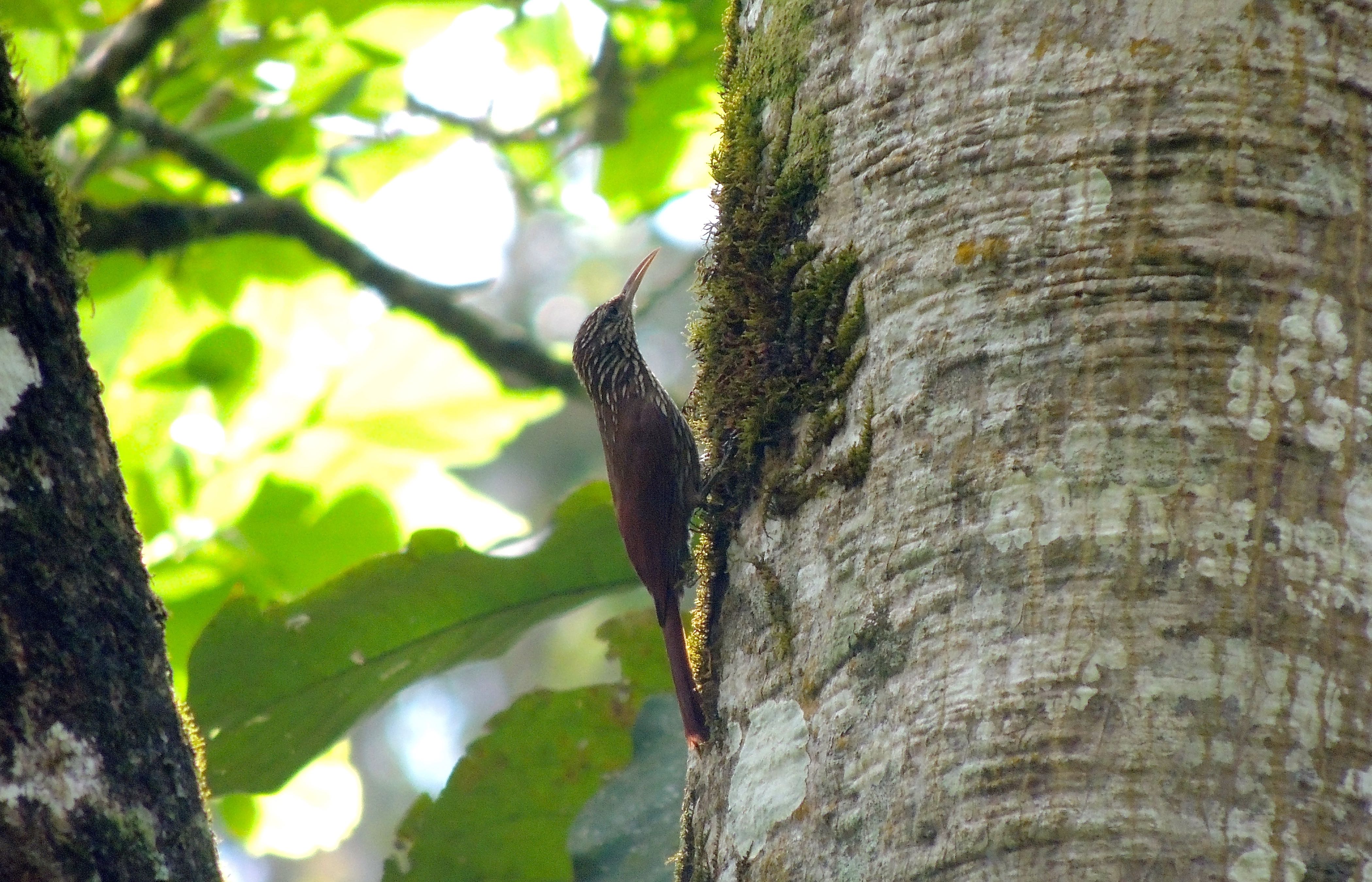 Streak-headed Woodcreeper - Photo by William Young
Streak-headed Woodcreeper - Photo by William YoungI saw very few antbirds on the trip. I saw Slaty Antwrens on my first and last days on the trails at Rancho Naturalista. The male is sooty gray with white spots on the wings. Mercedes and I saw Plain Antvireos at Rio Tuis. I had previously seen this nondescript species at the moth light.
Manakins
I saw three species of manakins. The most common was the White-collared Manakin. Its distinctive call sounds like one of those joy buzzer practical jokes when you shake hands with someone. I heard this sound in many places without seeing the bird. I finally saw a male not far from the cabin where I had stayed at Rancho Naturalista. His front half is mostly white, except for his black cap. His belly is yellow, and he has black wings. I did not find out until later that I had seen a female the day before along Rio Tuis. Our driver found a nest occupied by a small yellow-green bird, and a couple days later, Mercedes told me the bird was a female White-collared Manakin. At first, we thought the bird might be a euphonia. On the lower trails at Rancho Naturalista, I saw a male White-ruffed Manakin, who is a small black bird with a white throat. And on the upper trails, we encountered a singing White-crowned Manakin, who is all black with a white cap like a Snowcap. I managed to get a photo of this tiny bird while he was singing, and he had his bill wide open.
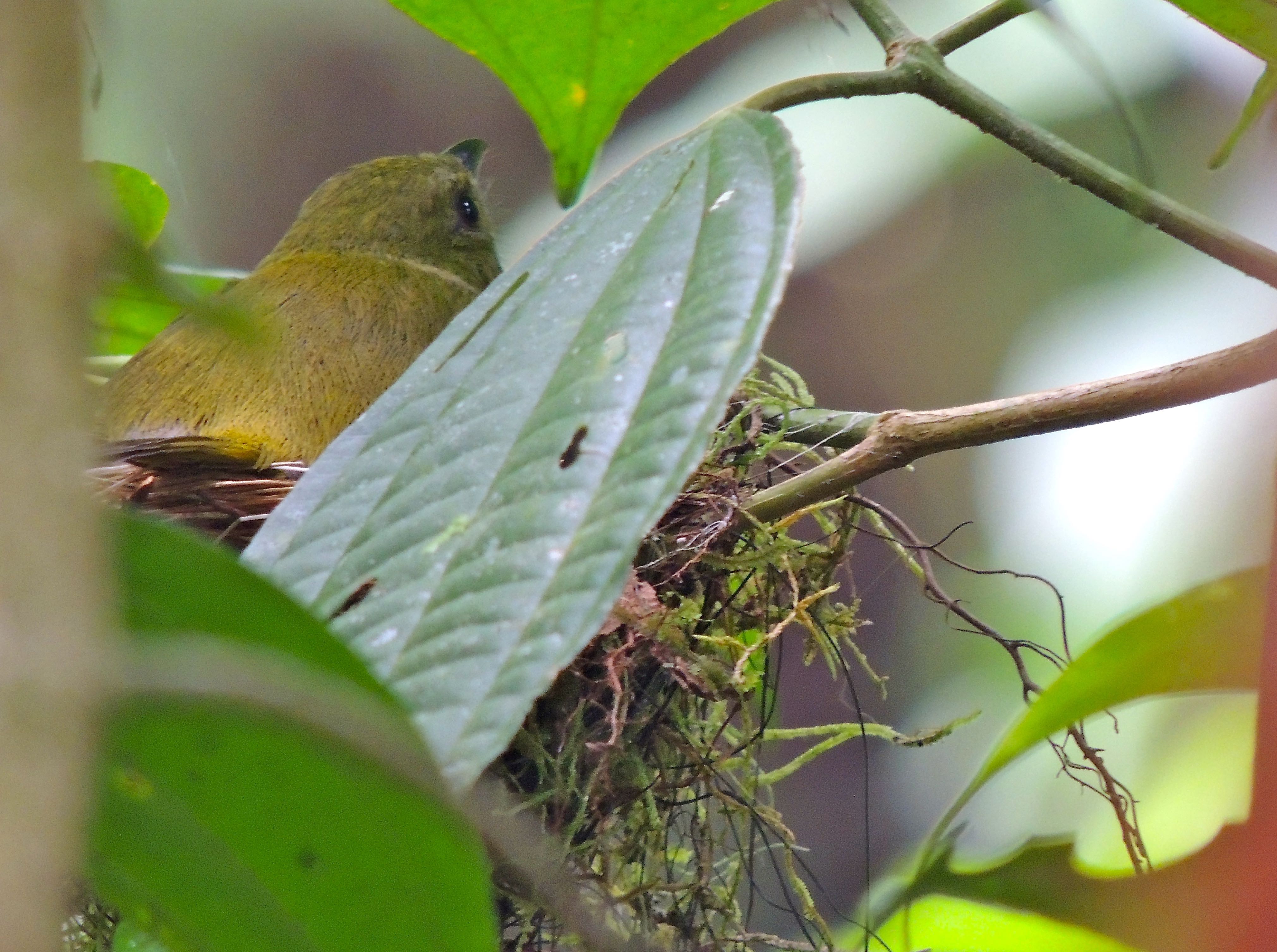 Female White-collared Manakin on Nest - Photo by William Young
Female White-collared Manakin on Nest - Photo by William Young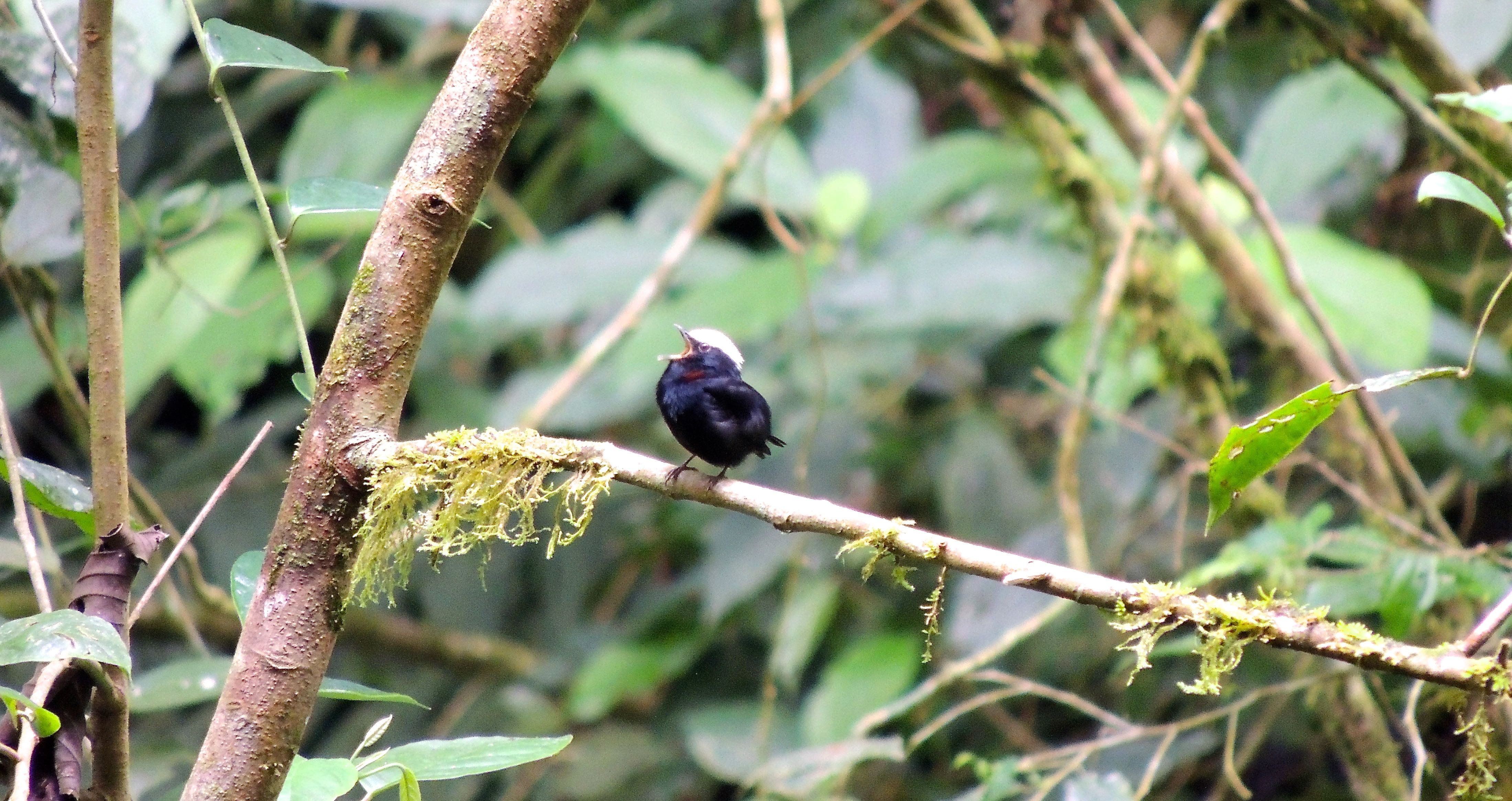 White-crowned Manakin - Photo by William Young
White-crowned Manakin - Photo by William YoungFlycatchers, Silky Flycatchers, Becards, and Tityras
The tyrant flycatchers are the largest bird family in the world, and Costa Rica has a lot of them. Great Kiskadees are common. When they were wet, I could see the golden crown that was usually hidden beneath the black feather combover. Boat-billed Flycatchers look similar, but they have a larger bill and no rufous on the wings like the kiskadees. The call of the Boat-billed has loud notes with a bit of static. Smaller than both of these species but with similar plumage are the Social and Gray-capped Flycatchers. Both nest near the bridge at Platanillo. The Social has a darker head and more of a white stripe over the eye. A Social was also building a nest near one of the hanging plants at Rancho Bajo. The Piratic Flycatcher has dark streaks on its white breast. I frequently heard its loud two-note call. Tropical Kingbirds are not nearly as common in Costa Rica as they are in Panama. I saw a few, especially in agricultural areas.
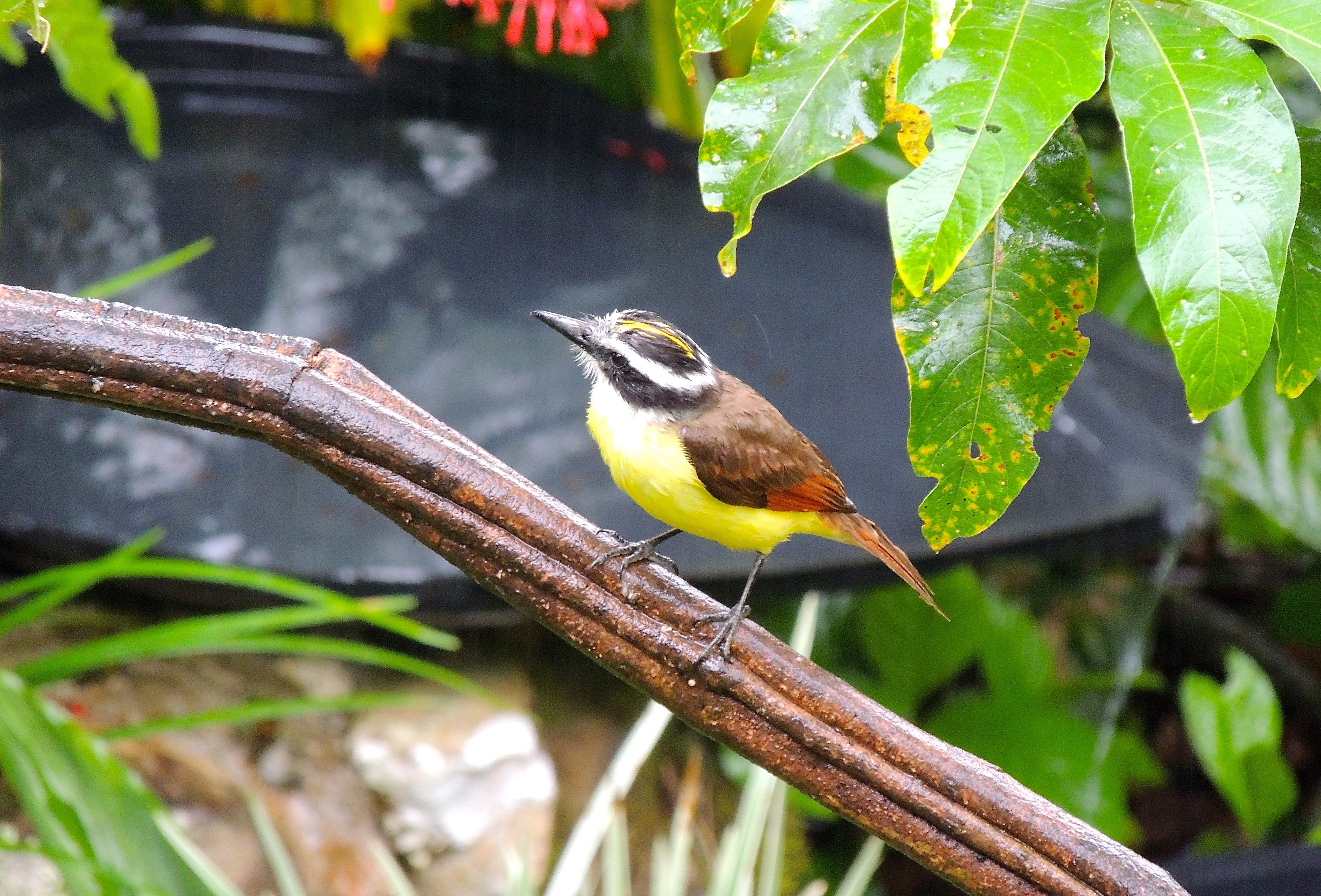 Great Kiskadee - Photo by William Young
Great Kiskadee - Photo by William Young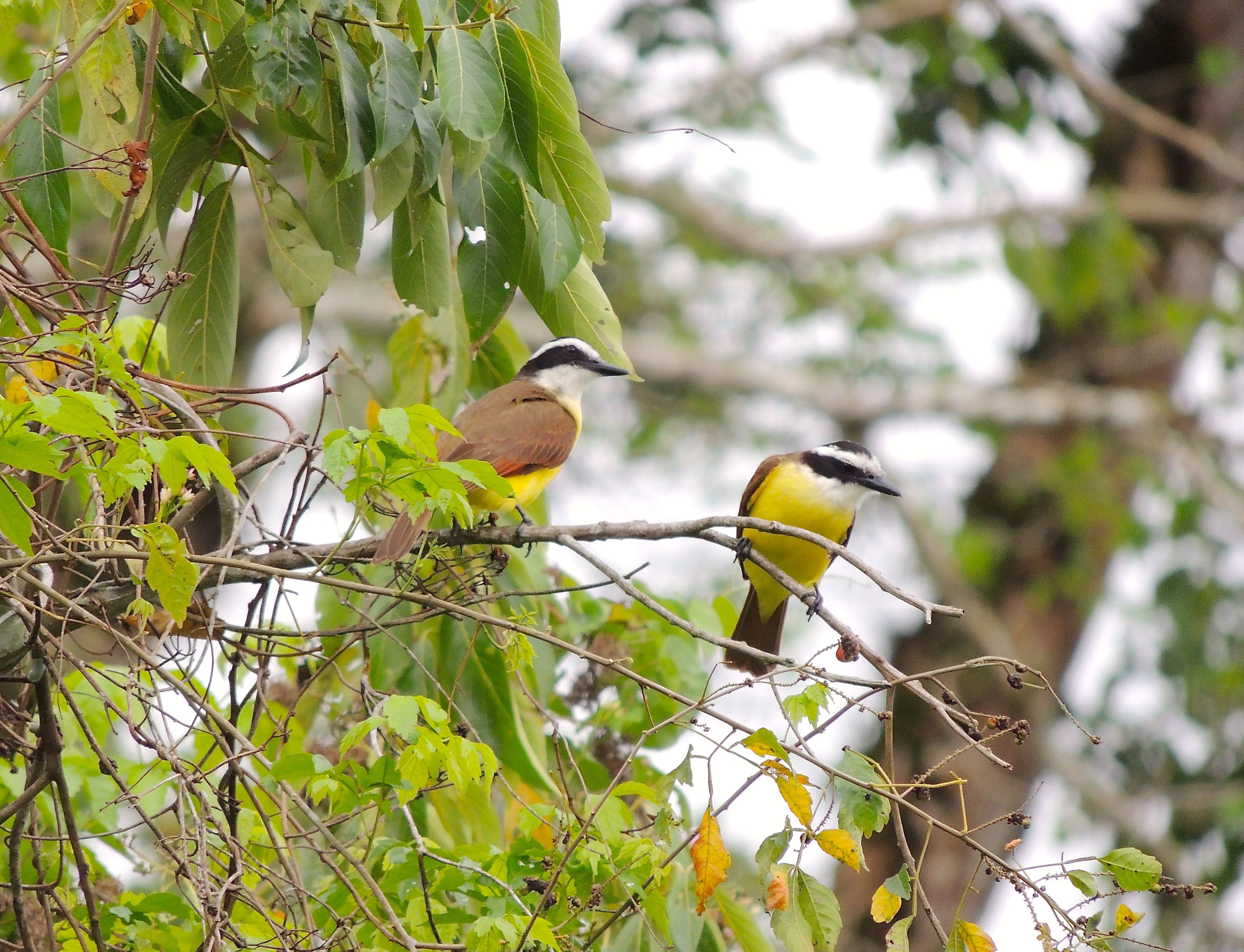 Great Kiskadees - Photo by William Young
Great Kiskadees - Photo by William Young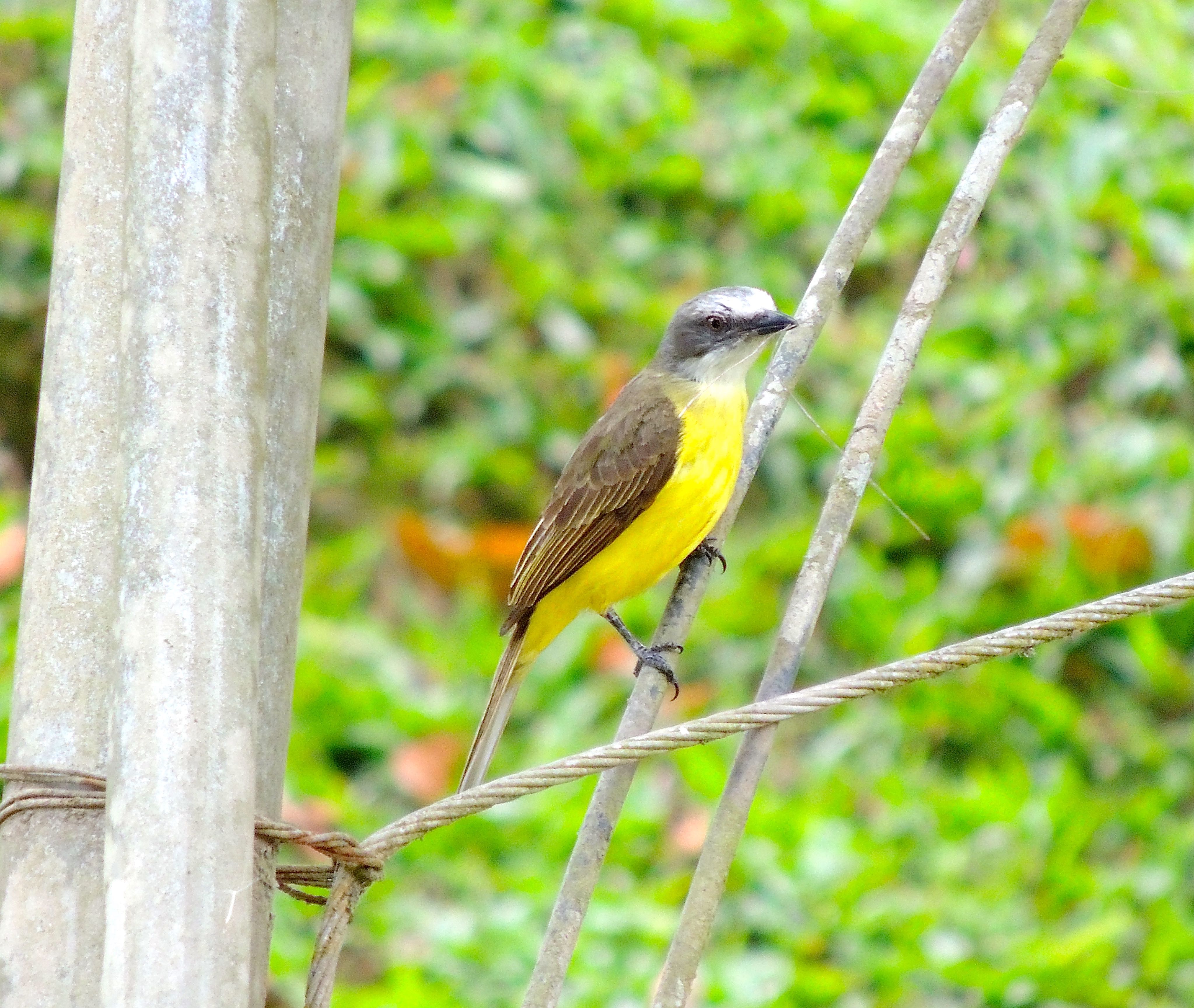 Gray-capped Flycatcher - Photo by William Young
Gray-capped Flycatcher - Photo by William YoungDusky-capped Flycatchers are common. In good light, they are lemony yellow below. From certain angles, the cap looks dark. They are the only Myiarchus flycatcher I saw. Yellow-bellied Flycatchers are the only Empidonax flycatcher I saw. They were quite common, and I had an opportunity to study this species I rarely see where I live. They had a pinkish bill. They are supposed to be the easiest Empidonax to identify, but I still have trouble seeing the slight nuances of throat color. I have seen Acadian Flycatchers who have yellowish bellies. On my final day, I saw a Yellow-bellied near the Rancho Naturalista pond, and it quickly dipped into the water rather than going in to bathe. I saw a couple of Bright-rumped Atillas near the moth light, but I heard a lot more of them. The call builds and builds and ends with what sounds like relief.
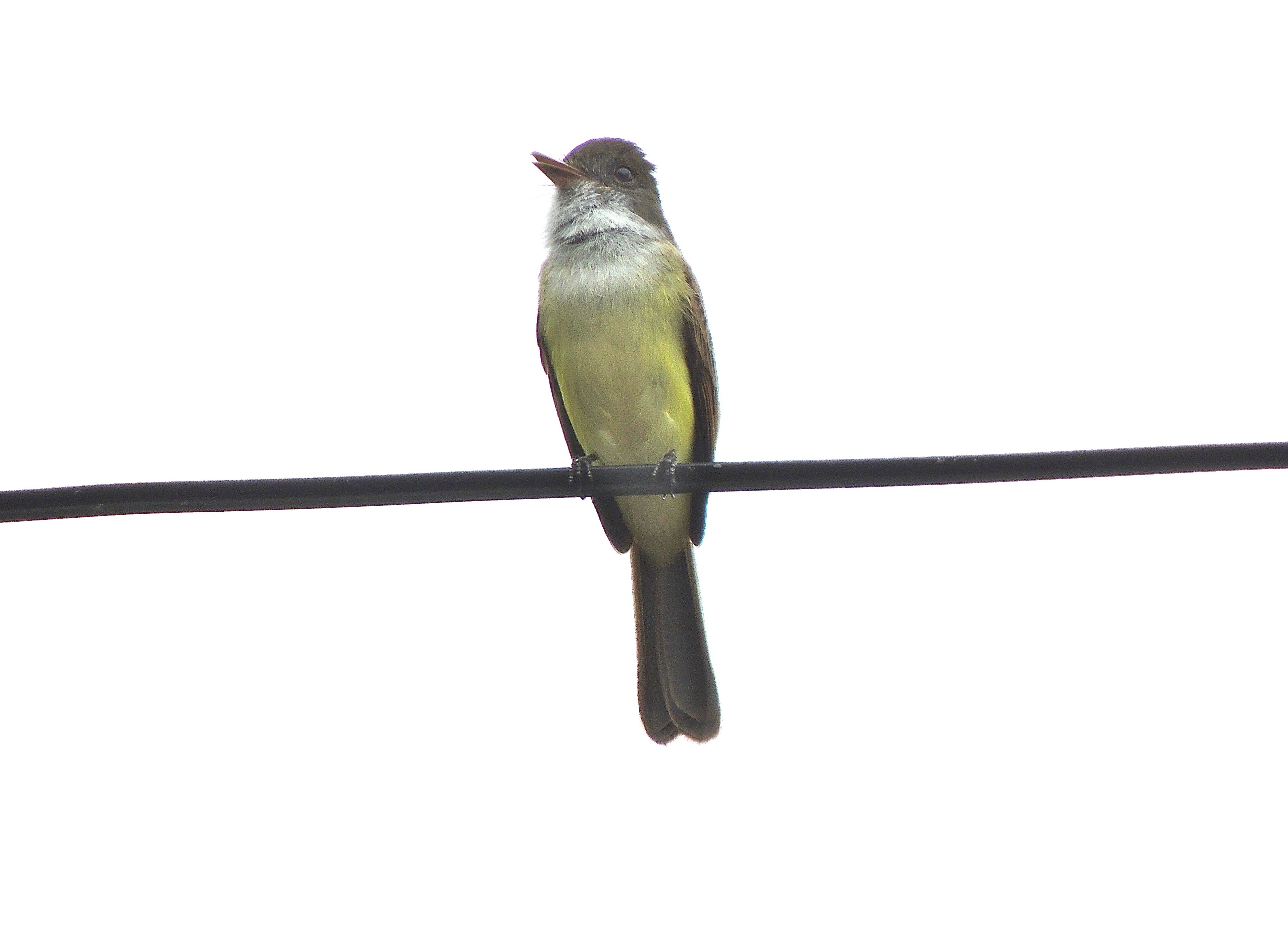 Dusky-capped Flycatcher - Photo by William Young
Dusky-capped Flycatcher - Photo by William Young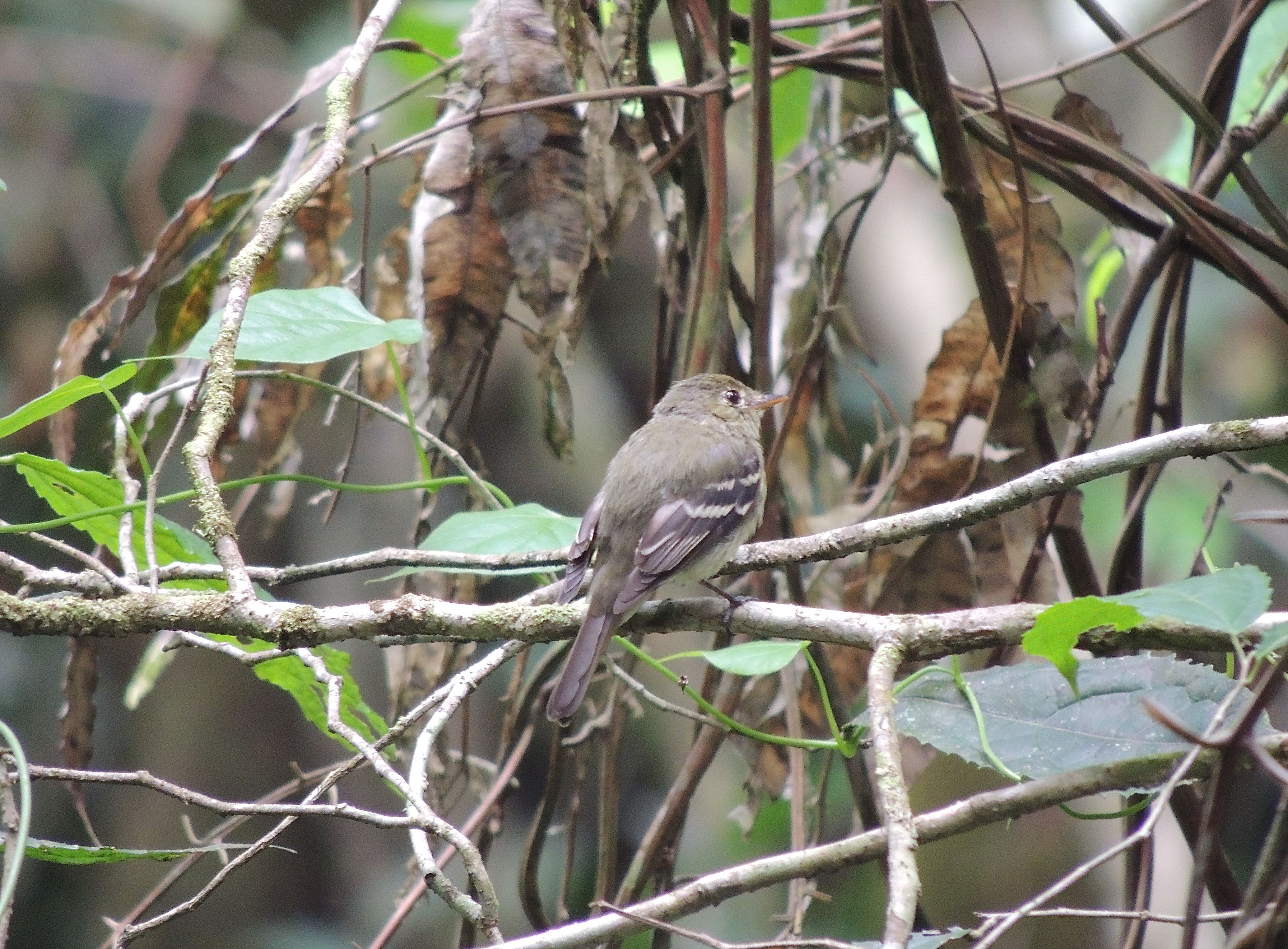 Yellow-bellied Flycatcher - Photo by William Young
Yellow-bellied Flycatcher - Photo by William YoungBlack Phoebes were common in rivers, foraging among the stones for insects. They sometimes flick their tails, but in a different manner than the Eastern Phoebe. Torrent Tyrannulets were in the same area. They are small gray birds who foraged on the rocks in rivers. I saw one Tropical Pewee on the way to Casa Turire. The field guide mentions the white mark near the bill, but I could not see it. I saw a yellowish wash on the underparts and the light-coloring on the bill. Ochre-bellied Flycatchers bathed in the hummingbird pools. I remember that they spent a lot of time splashing around in a stream at the Canopy Camp in the Darien. Common Tody-Flycatchers were in a couple of places, including the verbena bushes at Rancho Bajo. The only Black-headed Tody-Flycatcher I saw was behind Wayne Easley's house. It has a white throat, while the Common Tody-Flycatcher has a yellow throat. Mercedes pointed out the call of a Scale-crested Pygmy-Tyrant on the trails at Rancho Naturalista, but we did not see one. The same was true for a Rufous Mourner, whom we heard on a couple of days.
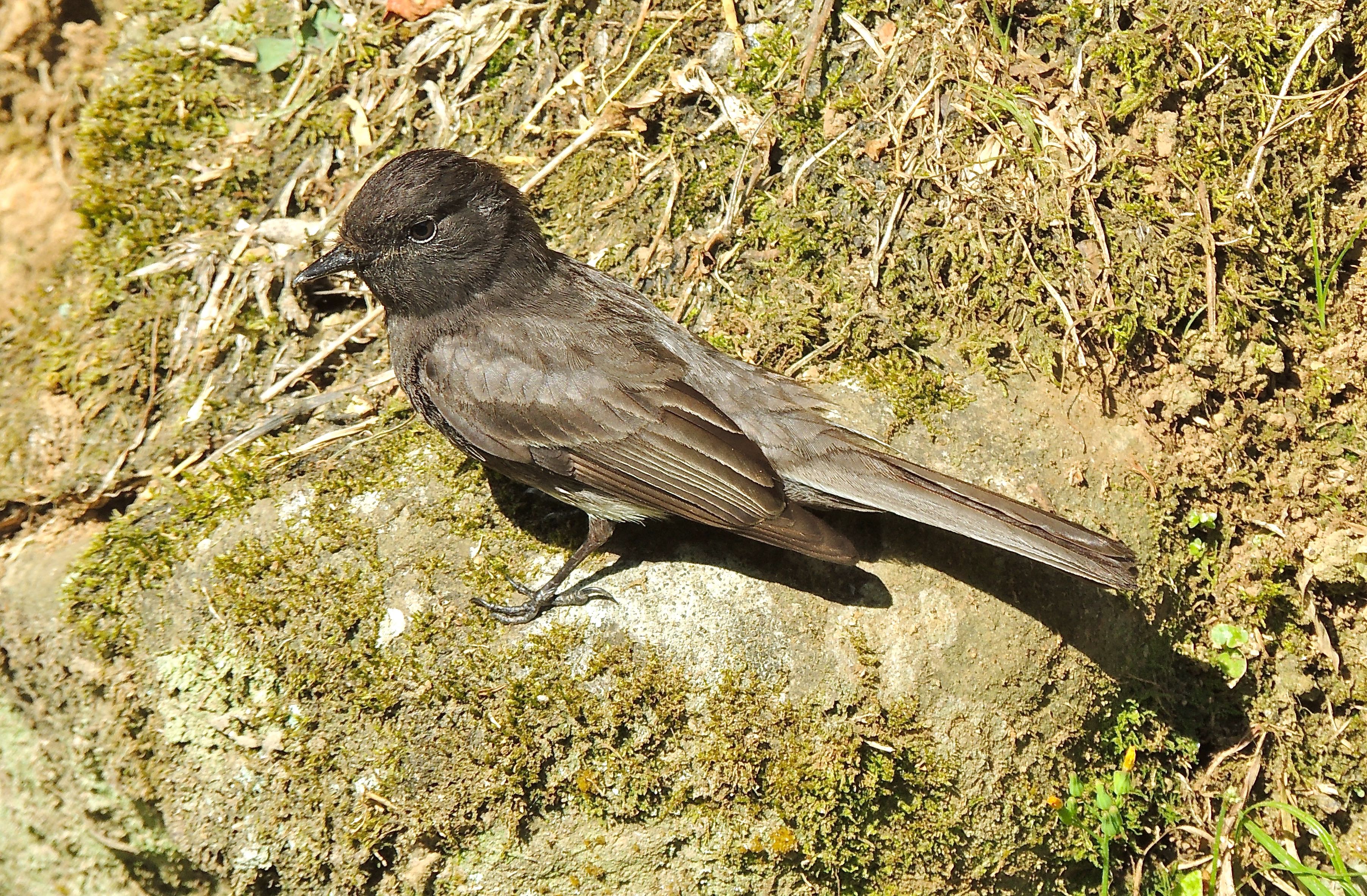 Black Phoebe - Photo by William Young
Black Phoebe - Photo by William Young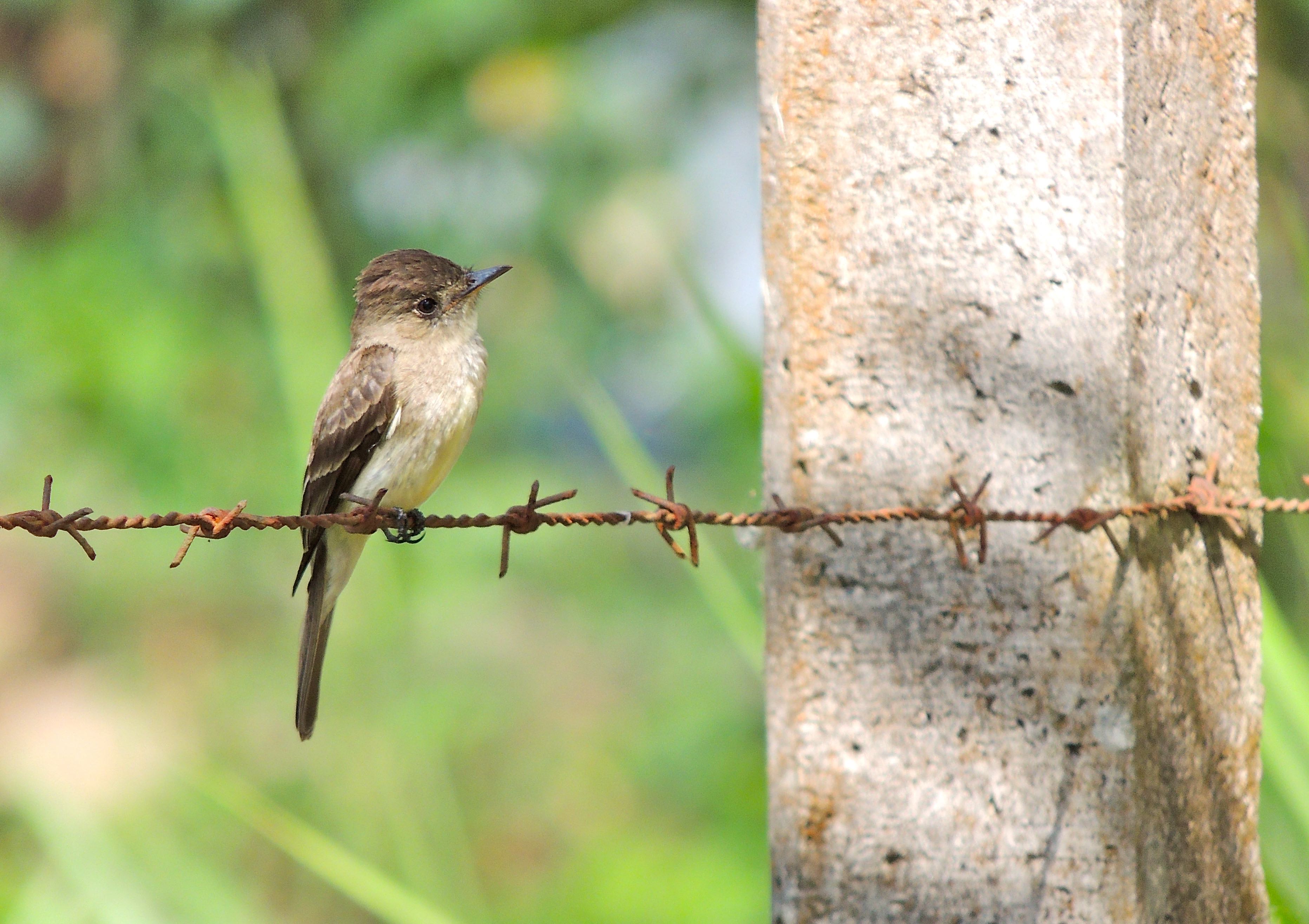 Tropical Pewee - Photo by William Young
Tropical Pewee - Photo by William YoungPaltry Tyrannulets nest around Rancho Naturalista, and I saw a couple. They looked like small Tennessee Warblers. They did not look small enough to warrant their name. I saw Yellow-bellied Elaenias on four days. Their ruffled crest made them look as if they were having a bad hair day. I saw a pair of Slaty-capped Flycatchers at La Mina. They are yellowish below, with a gray cap and a black ear streak. I saw a Yellow-olive Flycatcher behind the feeders at Rancho Naturalista. Mercedes and I saw another one at Rio Tuis in better light. In the same area, some Cinnamon Becards were building a nest. They have a cinnamon back and lighter underparts. I had seen one previously at La Mina. On my second visit to La Mina, I saw a Ruddy-tailed Flycatcher, who is small and moves quickly. It is rufous with a gray head and back.
At the dining area at Rancho Naturalista, a male-female pair of Masked Tityras foraged in the trees. I heard their belchy call. The male has a black mask, red skin around the eye, and a red-and-black bill. The female has a red bill, and her head and back are brown. I previously saw a pair at the base of Cerro Silencio. On the grounds of Quetzal's Paradise, we saw a female Black-and-yellow Silky Flycatcher, who is not related to the flycatchers. She was chunky, with an olive breast and a black cap.
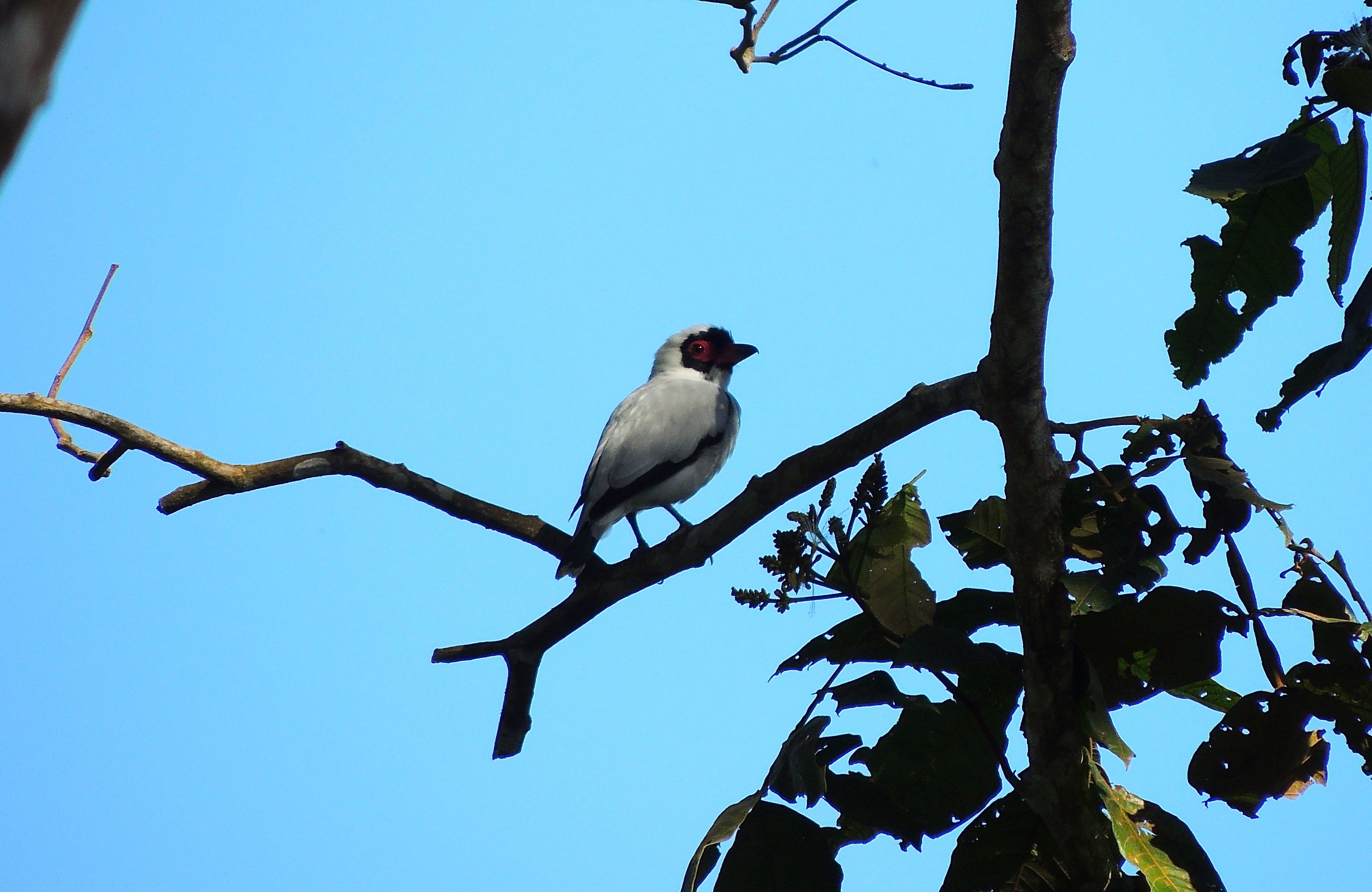 Masked Tityra - Photo by William Young
Masked Tityra - Photo by William YoungSwallows
The most common swallow were the Blue-and-white Swallows. They are small, with a dark blue back, white underparts, and a slightly forked tail. A couple of times, I saw them on the ground. Also common were Northern and Southern Rough-winged Swallows. The two are similar, but the Southern has a peach-colored throat and a light rump. At Platanillo, we saw Gray-breasted Martins, who are bigger than the other swallows.
Wrens and Gnatcatchers
I heard more wrens than I saw, which is usually the case. White-breasted Wood-Wrens were singing in a lot of places, and their song can be fairly persistent. I had good looks at them at the moth light at Rancho Naturalista. Some were fighting with each other. On the trails at Quetzal's Paradise, we heard Gray-breasted Wood-Wrens but did not see any. At Rancho Naturalista, I heard Stripe-breasted Wrens, but I never saw one. The song sounds like a truncated version of a Ferruginous Pygmy-Owl. Bay Wrens sang in a number of places, including where the road to Rancho Bajo intersects the road to Rancho Naturalista. We saw a couple foraging along the Rio Tuis. House Wrens were common, and I saw or heard them on the majority of days of the trip. I saw a Tropical Gnatcatcher in the verbena outside Rancho Bajo and another the same day at La Mina. It has a black head. At Rio Tuis, we saw an American Dipper nest, but we dipped on the Dipper.
Thrushes and Jays
Brown Jays were one of the most common species on the trip. They are larger than Blue Jays. Unlike Blue Jays who sometimes imitate hawks, the Brown Jay always seem to sound like a screaming Buteo. Many came to the Rancho Naturalista feeders. Juvenile Brown Jays have a yellow eyering. One of the other most common birds at the feeders is the Clay-colored Thrush, who used to be called the Clay-colored Robin. It is the national bird of Costa Rica. Costa Ricans sometimes call it the rain bird, because it starts to sing around the beginning of the rainy season. There is something to be said for having a common bird who everyone knows as the national bird rather than a showy bird who most people rarely see. It is in the genus Turdus like the American Robin. Clay-colored Thrushes frequently went to the Rancho Naturalista pond to bathe, and unfortunately, often chased warblers I was trying to photograph. They have a wide range, and I also saw some at Quetzal's Paradise in the highlands, along with a few Sooty Thrushes, who are in the Turdus genus. Sooty Thrushes are a dark sooty gray with a yellow bill and feet. A couple foraged on the ground. Quite a few Black-billed Nightingale-Thrushes foraged in the same area. Their back is the color of a Wood Thrush. They have a gray face and a short black bill. They are about the size of a sparrow. In the highlands, we heard a Black-faced Solitaire but did not see one. They are frequently trapped for the cage bird trade because they sing well. They do not do well when taken out of their highland habitat. I saw one Swainson's Thrush and one Wood Thrush on the trip. They were more common when I was in Panama.
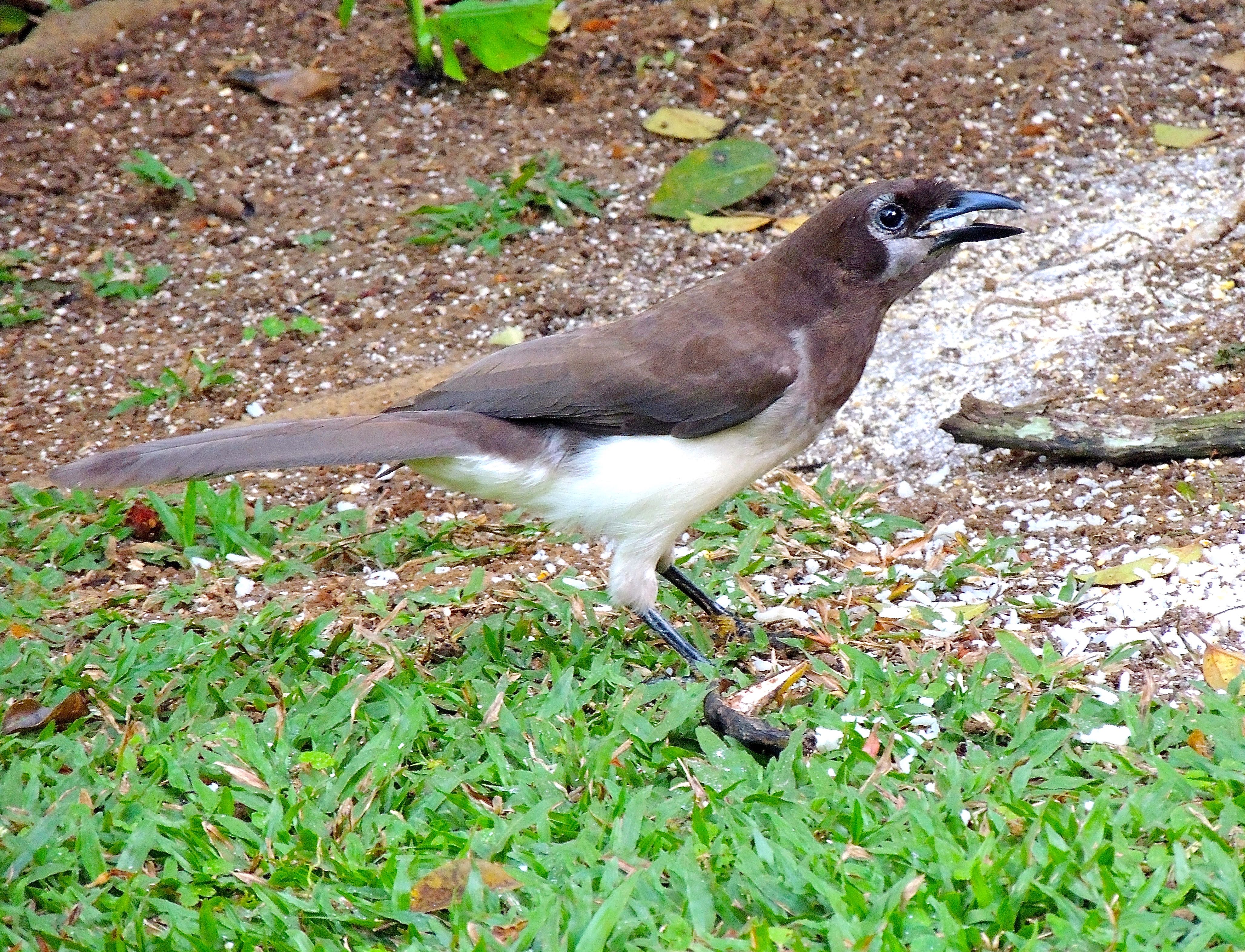 Brown Jay Adult - Photo by William Young
Brown Jay Adult - Photo by William Young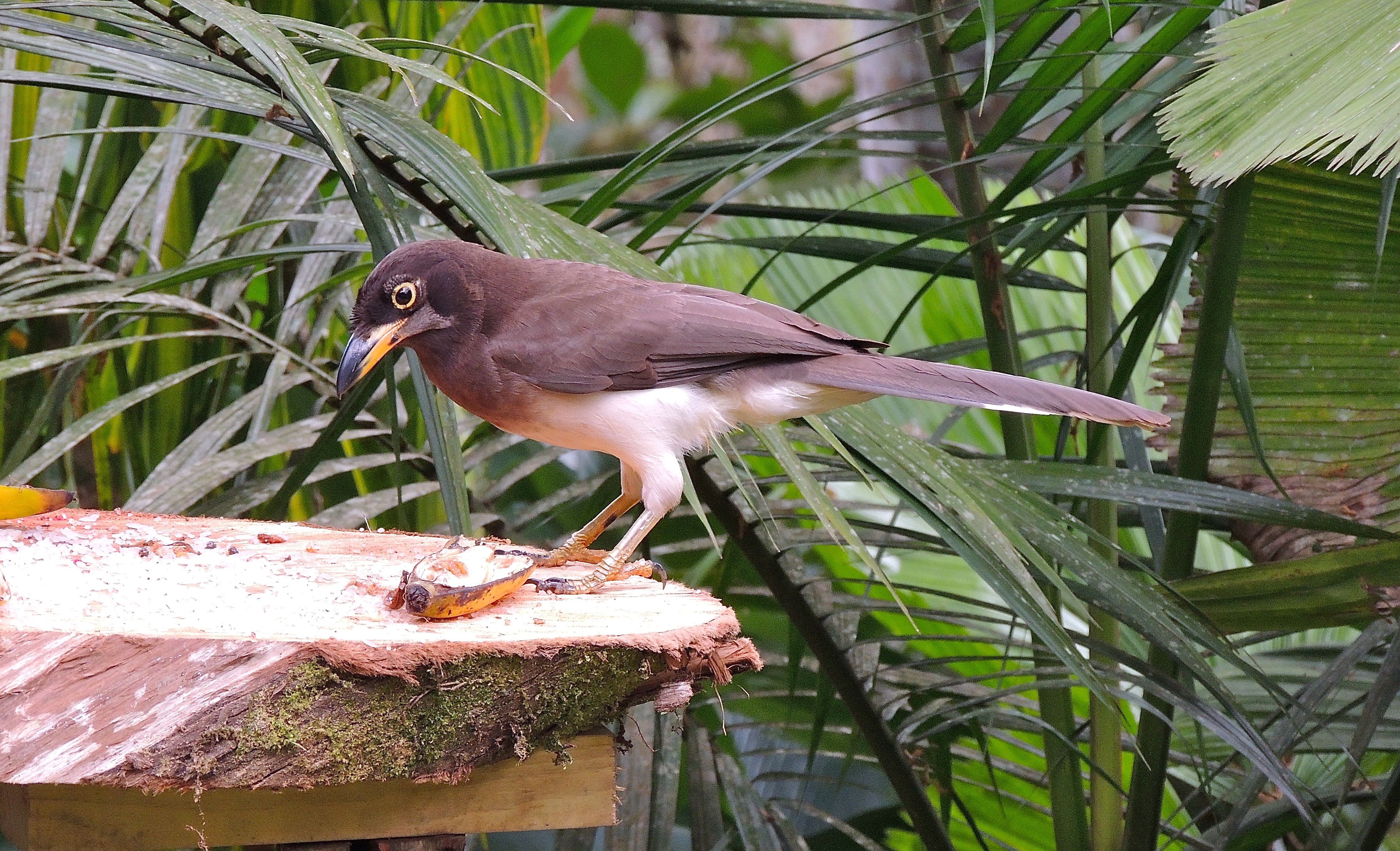 Brown Jay Juvenile - Photo by William Young
Brown Jay Juvenile - Photo by William Young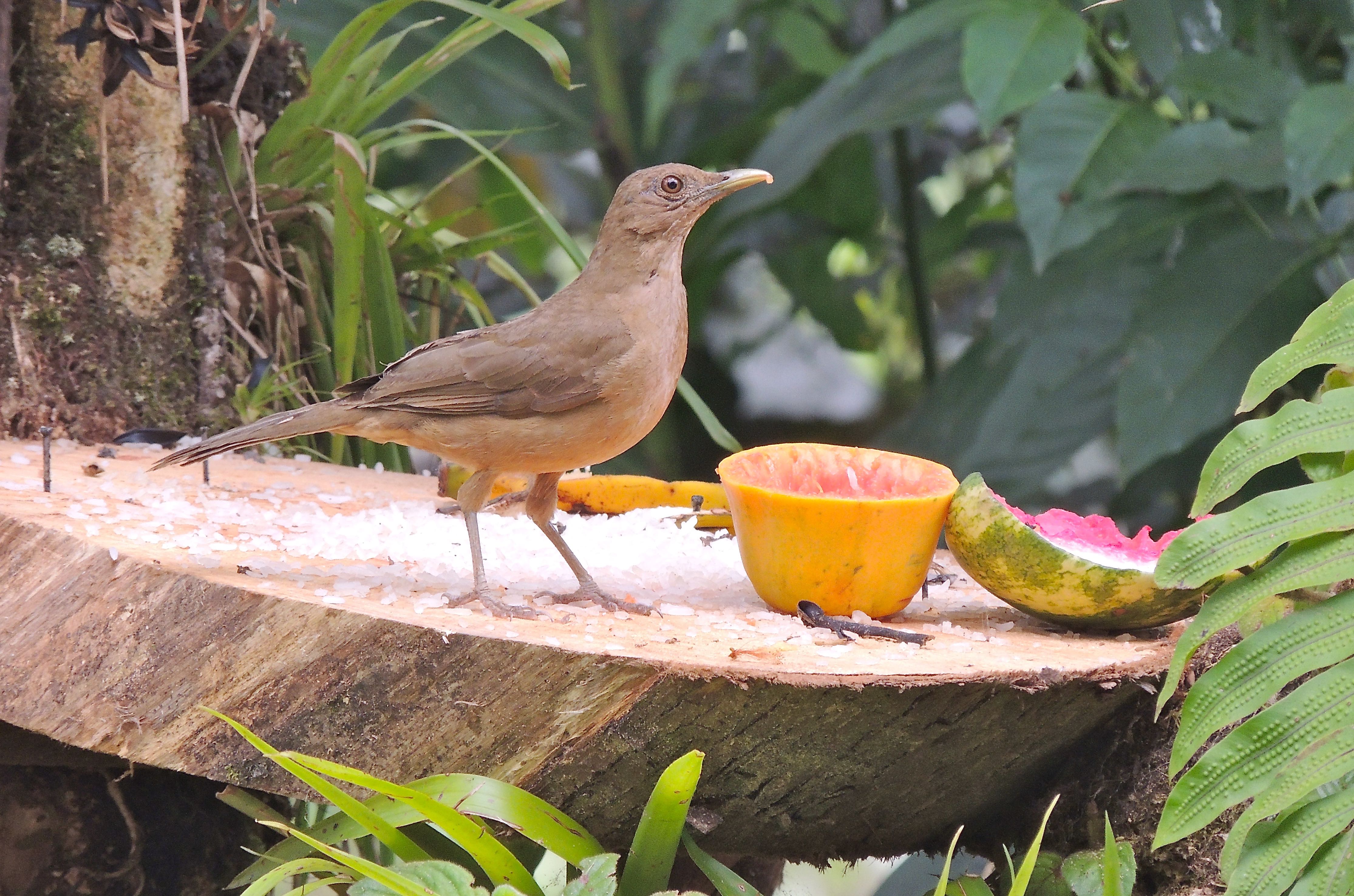 Clay-colored Thrush - Photo by William Young
Clay-colored Thrush - Photo by William Young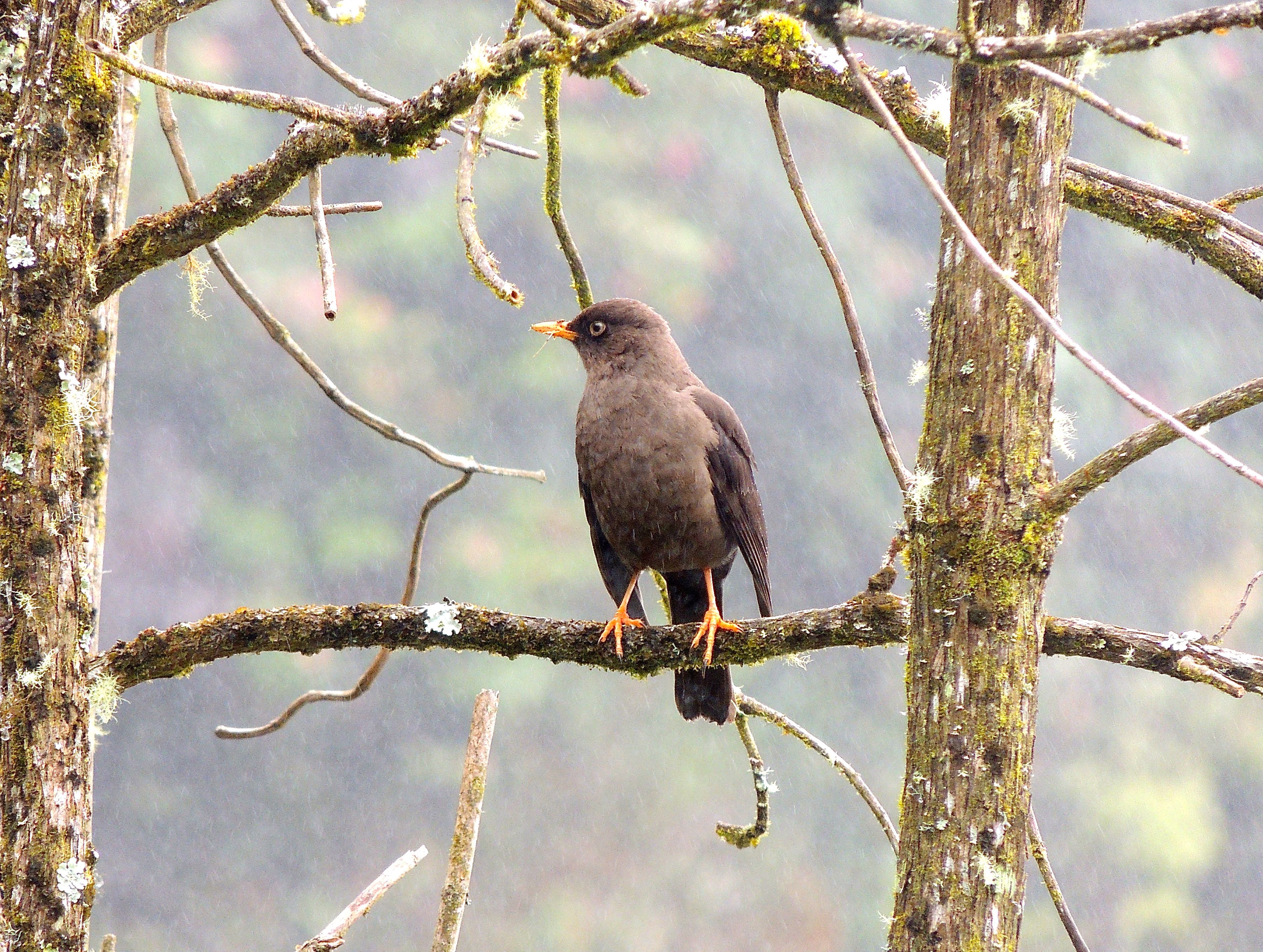 Sooty Thrush - Photo by William Young
Sooty Thrush - Photo by William Young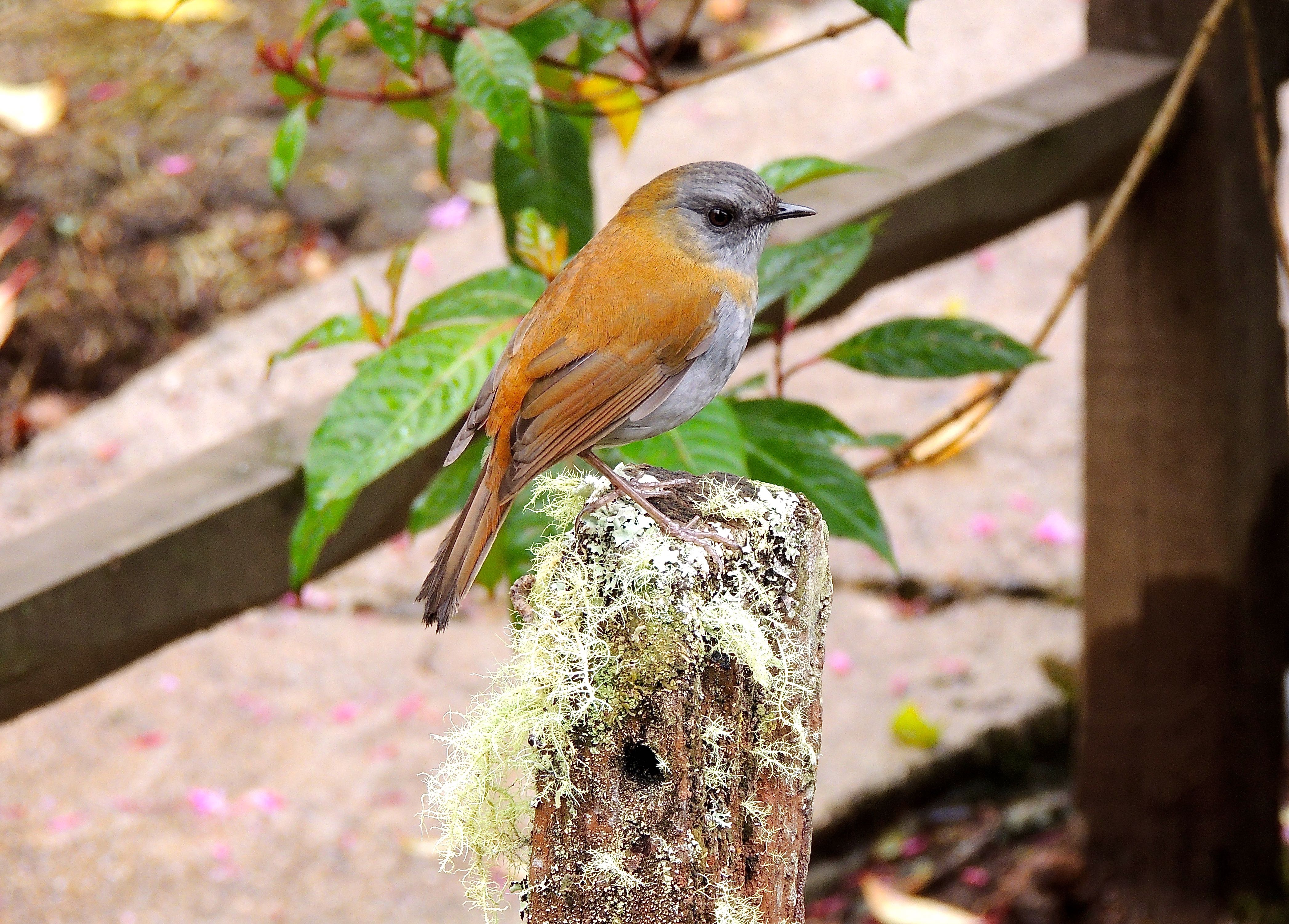 Black-billed Nightingale-Thrush - Photo by William Young
Black-billed Nightingale-Thrush - Photo by William YoungVireos
Mercedes and I saw a Philadelphia Vireo and a Tennessee Warbler foraging in the same tree next to Rancho Bajo. The vireo was moving more slowly and has a bigger head and bill. It also appeared to be rounder than the warbler. The Tennessee Warbler looks more like a Philadelphia Vireo than a Red-eyed. A Yellow-green Vireo and a Yellow-throated Vireo were in a tree next to the bridge at Platanillo. The Yellow-green looks like a Red-eyed with a few tinges of yellow. I saw a Lesser Greenlet on my second trip to La Mina. It is a nondescript bird.
Warblers
I saw 23 species of warblers, including 16 who migrate to Virginia. I was excited to see Golden-winged Warblers. I had great looks at them at Rancho Naturalista and at Wayne Easley's house, and a couple came to bathe at the pond near the dining area. This species has become scarce in Northern Virginia, and I have not seen one during migration in years. I was also excited to see male Blackburnian Warblers in breeding plumage. I watched one at the base of Cerro Silencio and another one in a tree next to the house at Rancho Bajo. The bright orange throat gives me a thrill no matter how many times I see it. In the highlands, I saw a Flame-throated Warbler, whose throat is a similar orange. I call them Flame-thrower Warblers. They are gray on the back and white below.
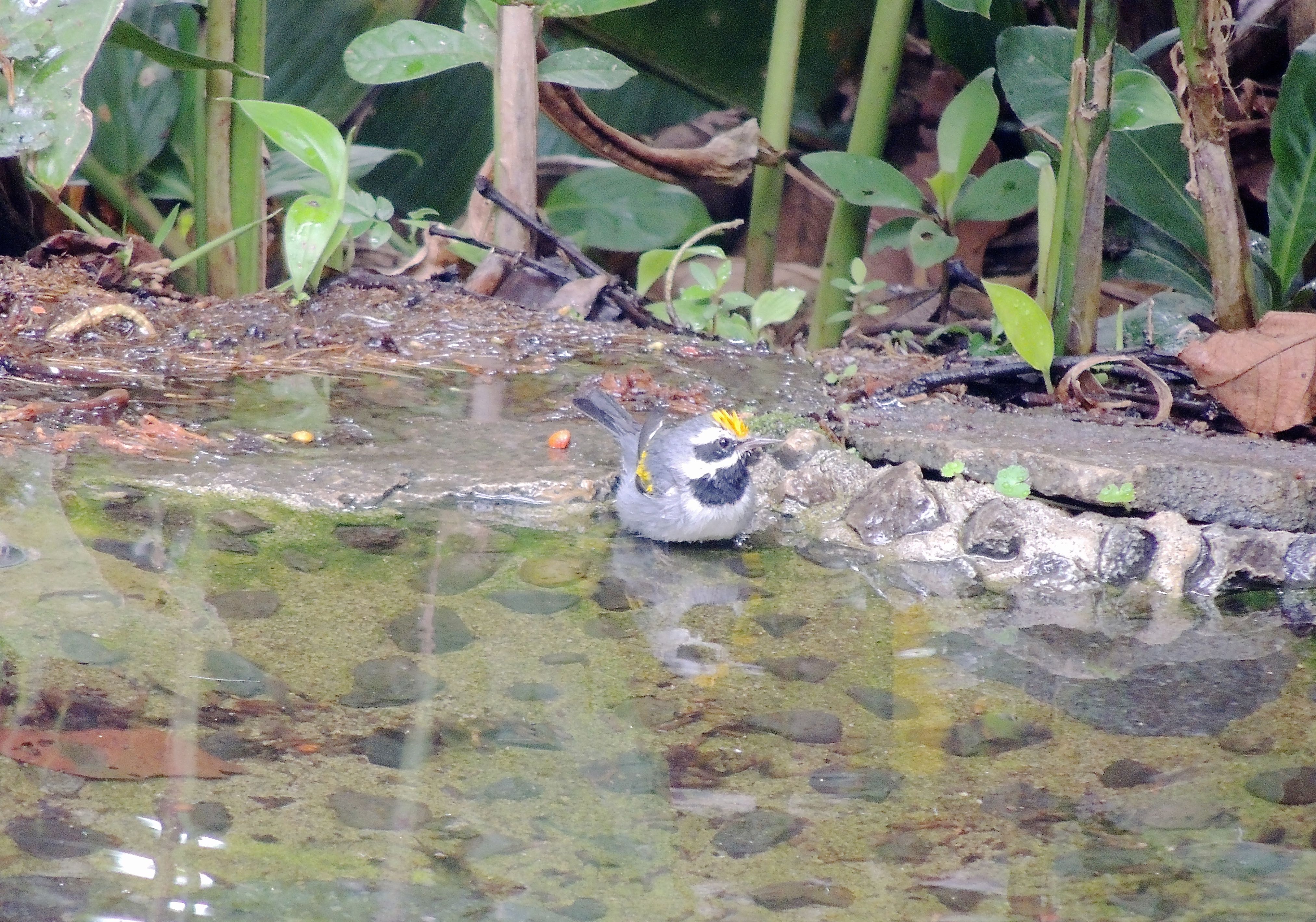 Golden-winged Warbler - Photo by William Young
Golden-winged Warbler - Photo by William Young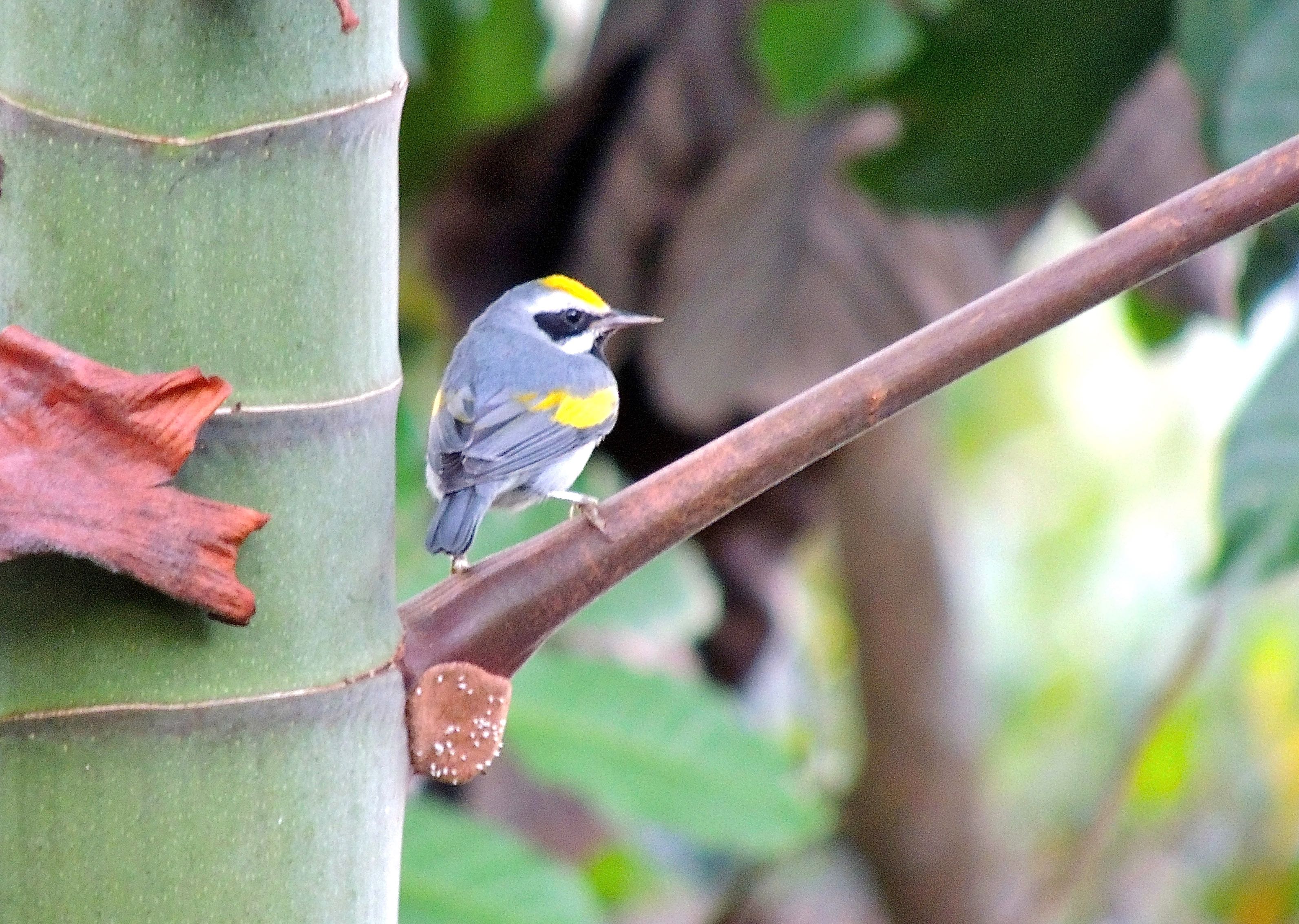 Golden-winged Warbler - Photo by William Young
Golden-winged Warbler - Photo by William YoungThe most common warbler was the Chestnut-sided. They are one of the whitest looking warblers, and I saw many in different plumages, including full breeding males. Tennessee Warblers were fairly common in a number of places. I had good looks at the gray head and the white over the eye. Black-and-white Warblers were common. I saw both males and females, and they were probably getting ready to head north soon. On the upper trails at Rancho Naturalista, I was with Mercedes when she saw two life birds — a Cerulean and a Canada Warbler. In the same tree was a Golden-winged, a Black-and-white, and a Chestnut-sided Warbler. I often saw many different bird species in fruiting trees. The Cerulean is not common in Costa Rica. A bit later on the same walk, we saw a Magnolia Warbler. Mercedes had not seen many previously. On our trip to CATIE, Luis called me over to identify a bird. It was a Prothonotary Warbler, and it was a life bird for him. Mercedes was also at CATIE at the same time, and it would have been a life bird for her, but she was with two other people coming around the lake in the opposite direction, and the bird was not still there when she went to look for it.
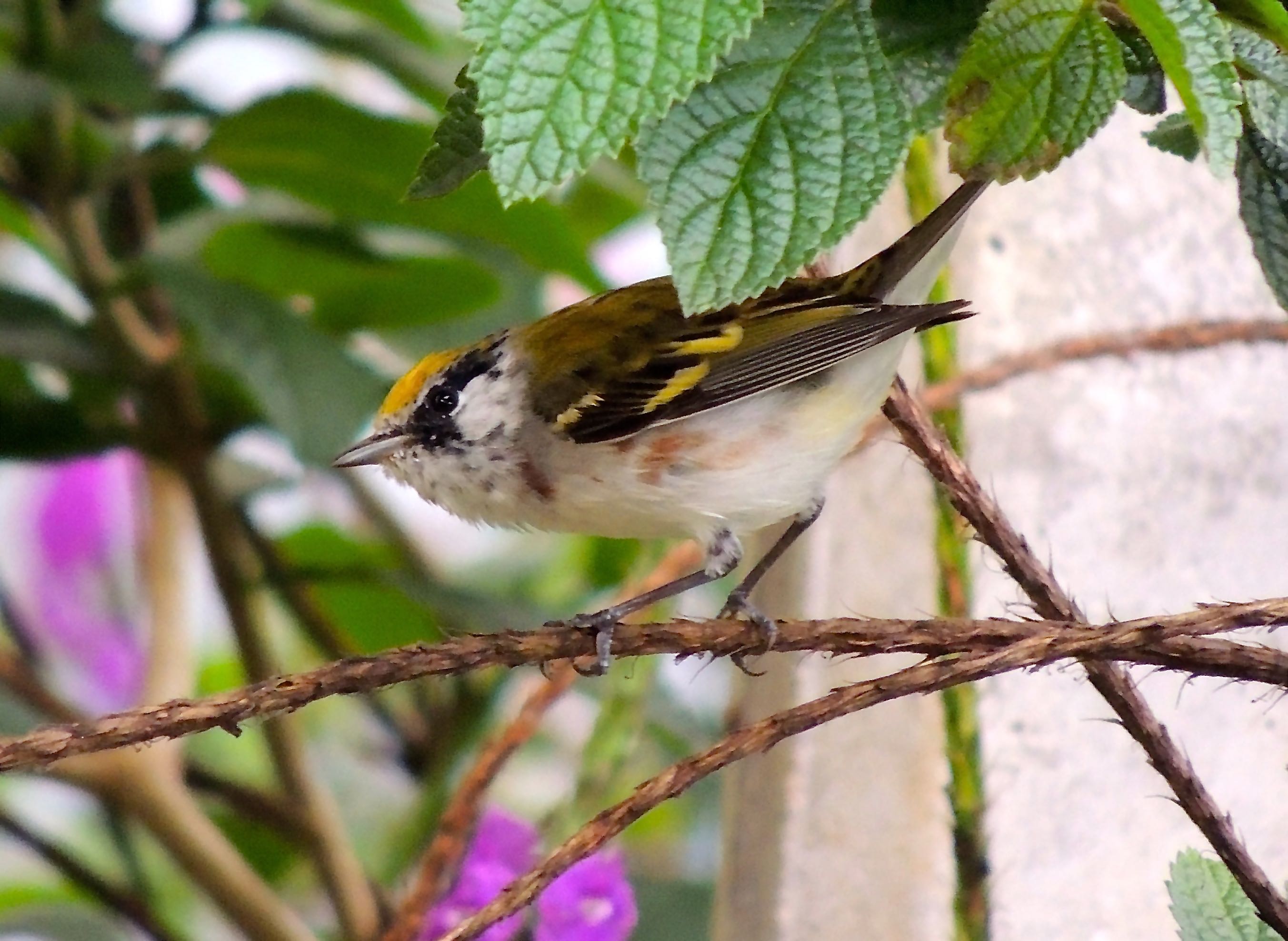 Chestnut-sided Warbler - Photo by William Young
Chestnut-sided Warbler - Photo by William Young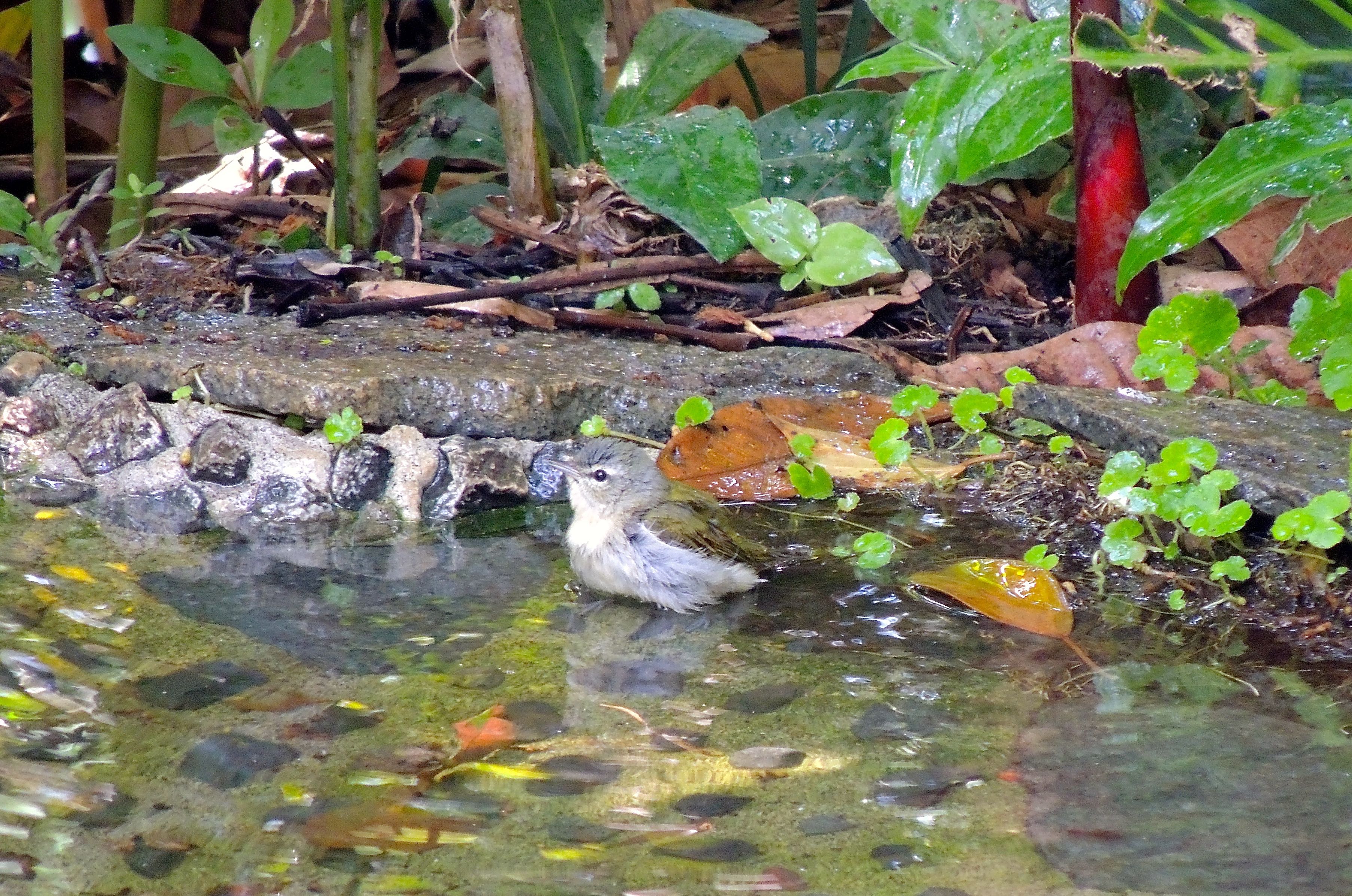 Tennessee Warbler - Photo by William Young
Tennessee Warbler - Photo by William YoungOn my final day at Rancho Naturalista, I sat next to the dining area for more than an hour to see what warblers would come to bathe. I had had a brief look at a Mourning Warbler the first morning I was there, but I wanted to get a better look. A male Mourning eventually came in to take a bath. Before that, a male Wilson's Warbler had come in, along with a Golden-winged, Chestnut-sided, and Tennessee. Even though Rufous-capped Warblers are fairly common, I did not see any until the final day, when I saw a few of them, including two who came to bathe at Rancho Naturalista. On previous days, an Ovenbird hopped near the pond, but I never saw it bathing. At the Rancho Naturalista moth light, a Kentucky Warbler hopped by each morning at about 6:45. I also saw one bathing at the hummingbird pools. On the hill between Rancho Naturalista and Rancho Bajo, I saw a female American Redstart. And on the trips along rivers, I saw both a Louisiana and a Northern Waterthrush. The Buff-rumped Warbler behaves like a manic waterthrush, hopping on rocks while foraging. It moves its tail a lot more than a waterthrush and flashes its buff rump.
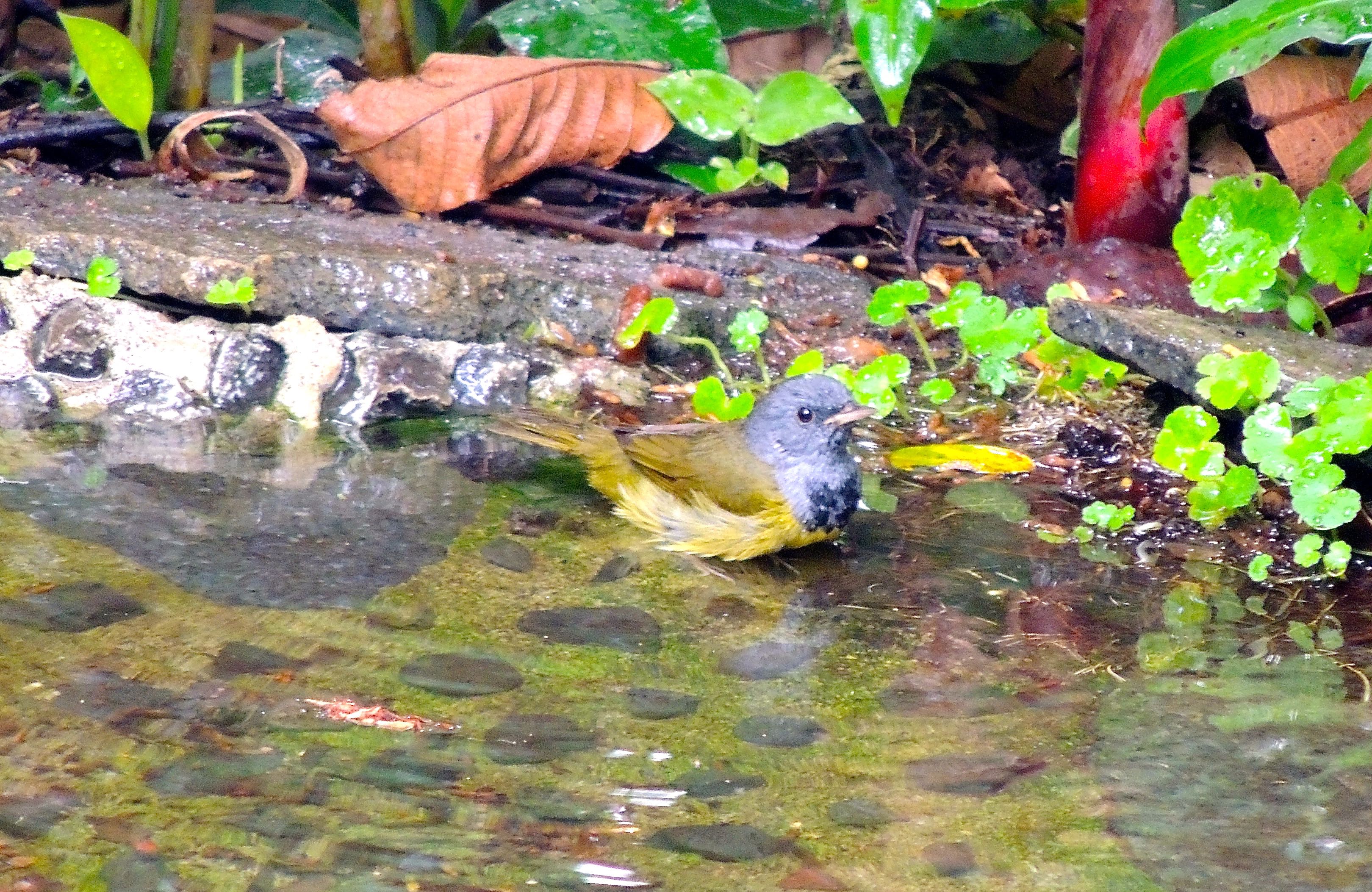 Mourning Warbler - Photo by William Young
Mourning Warbler - Photo by William Young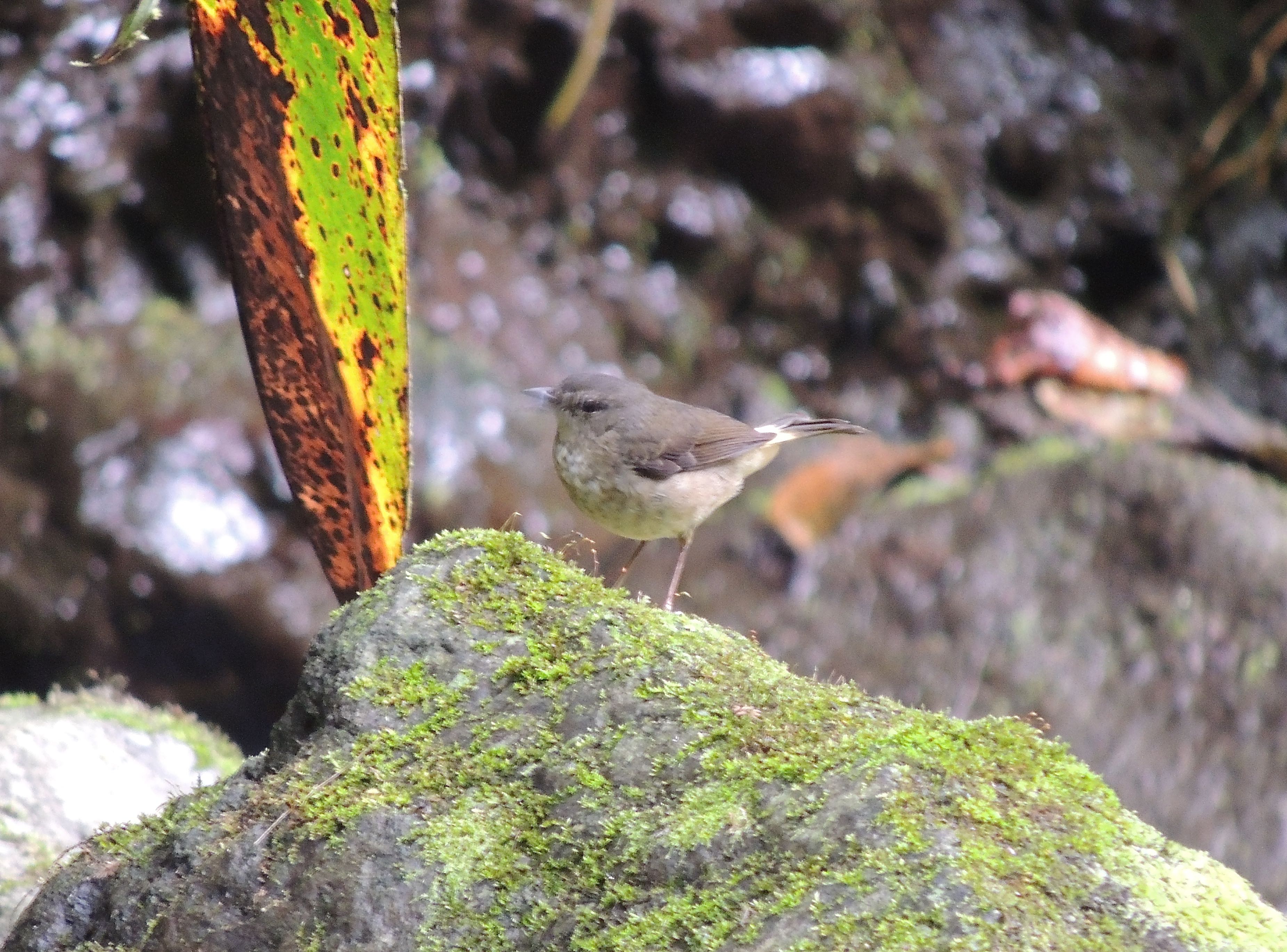 Buff-rumped Warbler - Photo by William Young
Buff-rumped Warbler - Photo by William YoungOf the Costa Rican warblers, a lot of Golden-crowned Warblers were in the woods near Rancho Naturalista. They move quickly. They are yellow below, and a couple of times, I saw the stripes on their head. A few came down to the area near the moth light. Tropical Parulas were fairly common. They have a dark head, and I saw one who had the reddish tinge on the yellow breast. They look a bit sleeker than Northern Parulas. At the base of Cerro Silencio, a couple of Slate-throated Redstarts foraged in low vegetation. I could see the top of their heads, but their crowns were not showing. They have a slate-gray bib. At Quetzal's Paradise, I saw Collared Redstarts, and their red crown was very much in evidence. They have a yellow face and a thin gray line on their breast.
Tanagers
The tanager name is used to describe birds in different families. The tanagers in North America are in the same family as cardinals and are not related to most of the Costa Rican Tanagers. I saw a male Scarlet Tanager in spring plumage at La Mina. Summer Tanagers were more common. At least one splotchy one was hanging around Rancho Naturalista, looking as if he were wearing a red-and-olive camo uniform. The Passerini's Tanager was one of the most common of the Costa Rican species. It is jet black with a red back that at time looked orange if the light hit it a certain way. It used to be called the Scarlet-rumped Tanager before being split. The female looks very different, being mostly olive and yellow with a gray head. Both the male and female have a blue-gray bill. Blue-gray Tanagers were fairly common at the feeders. I had not realized how pretty they are until I saw them in bright sunlight, with their two-toned blue wings on their bluish-gray body. One at the feeders at Wayne Easley's house was partially leucistic with some white feathers on its back. Palm Tanagers also came to the feeders. I saw only a couple Bananaquits on the trip — one in the verbena outside Rancho Bajo, and one outside the offices of Rancho Naturalista. They have a little white handkerchief like a Black-throated Blue Warbler.
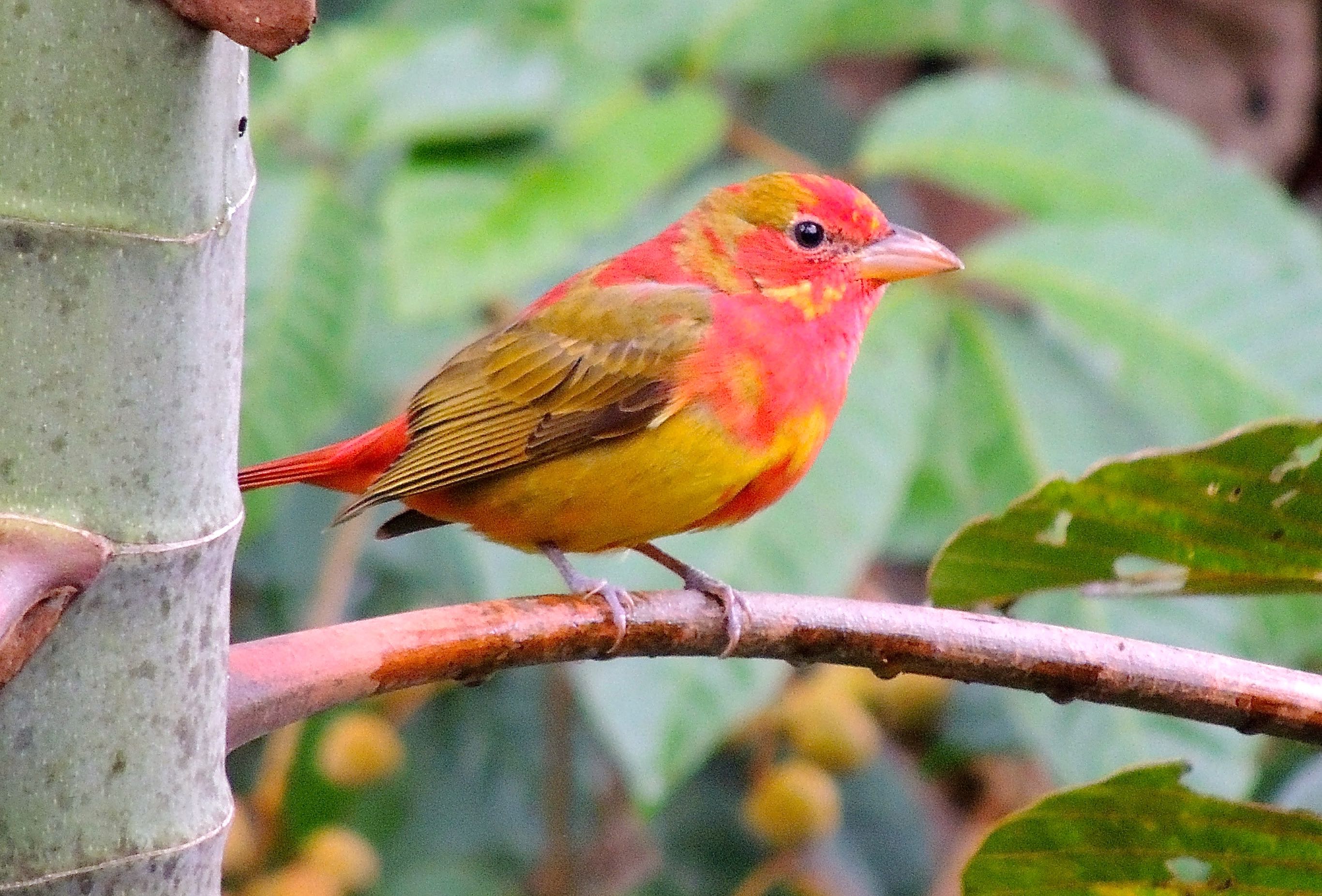 Summer Tanager - Photo by William Young
Summer Tanager - Photo by William Young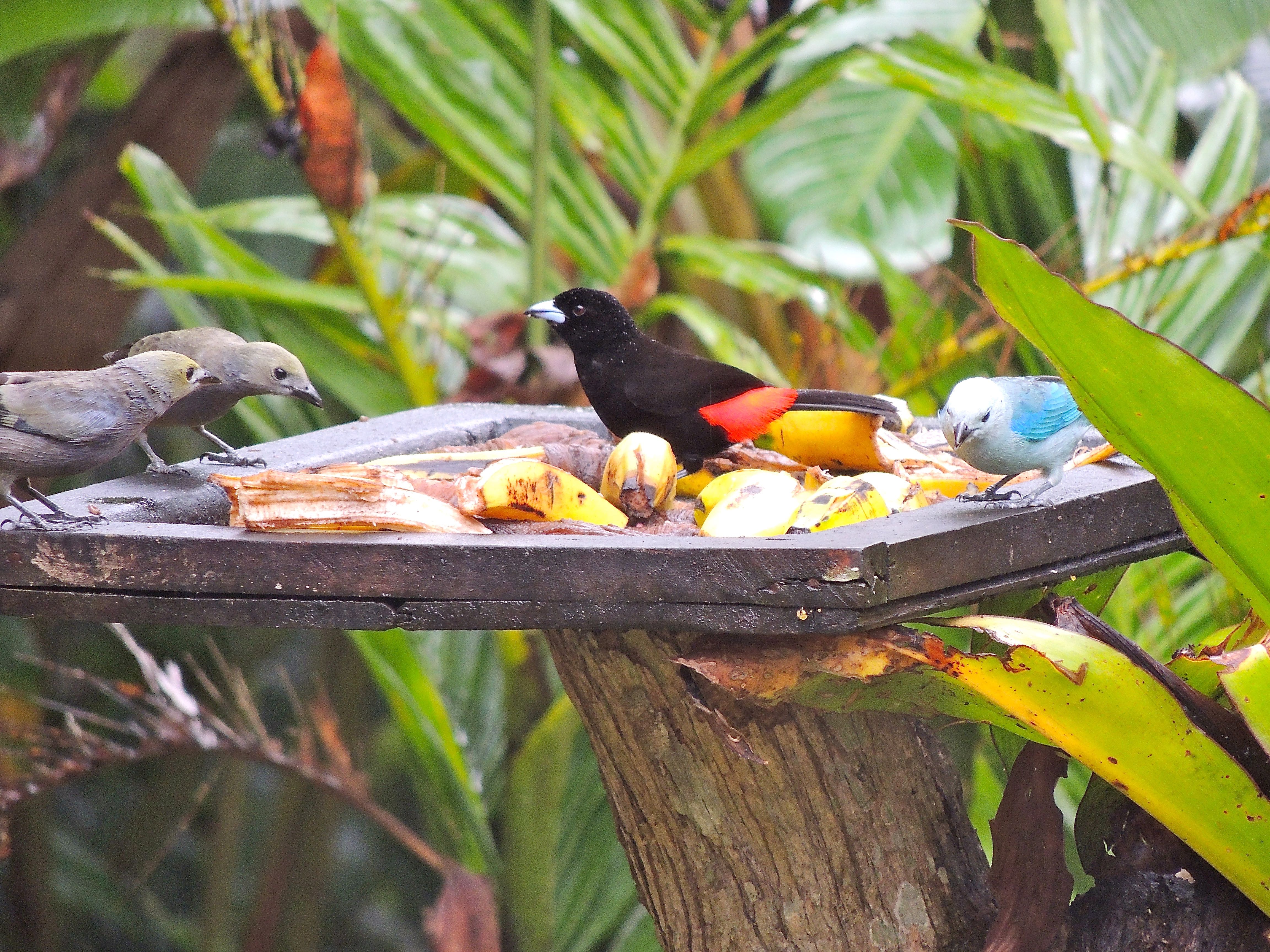 Palm, Passerini's, and Blue-gray Tanagers - Photo by William Young
Palm, Passerini's, and Blue-gray Tanagers - Photo by William Young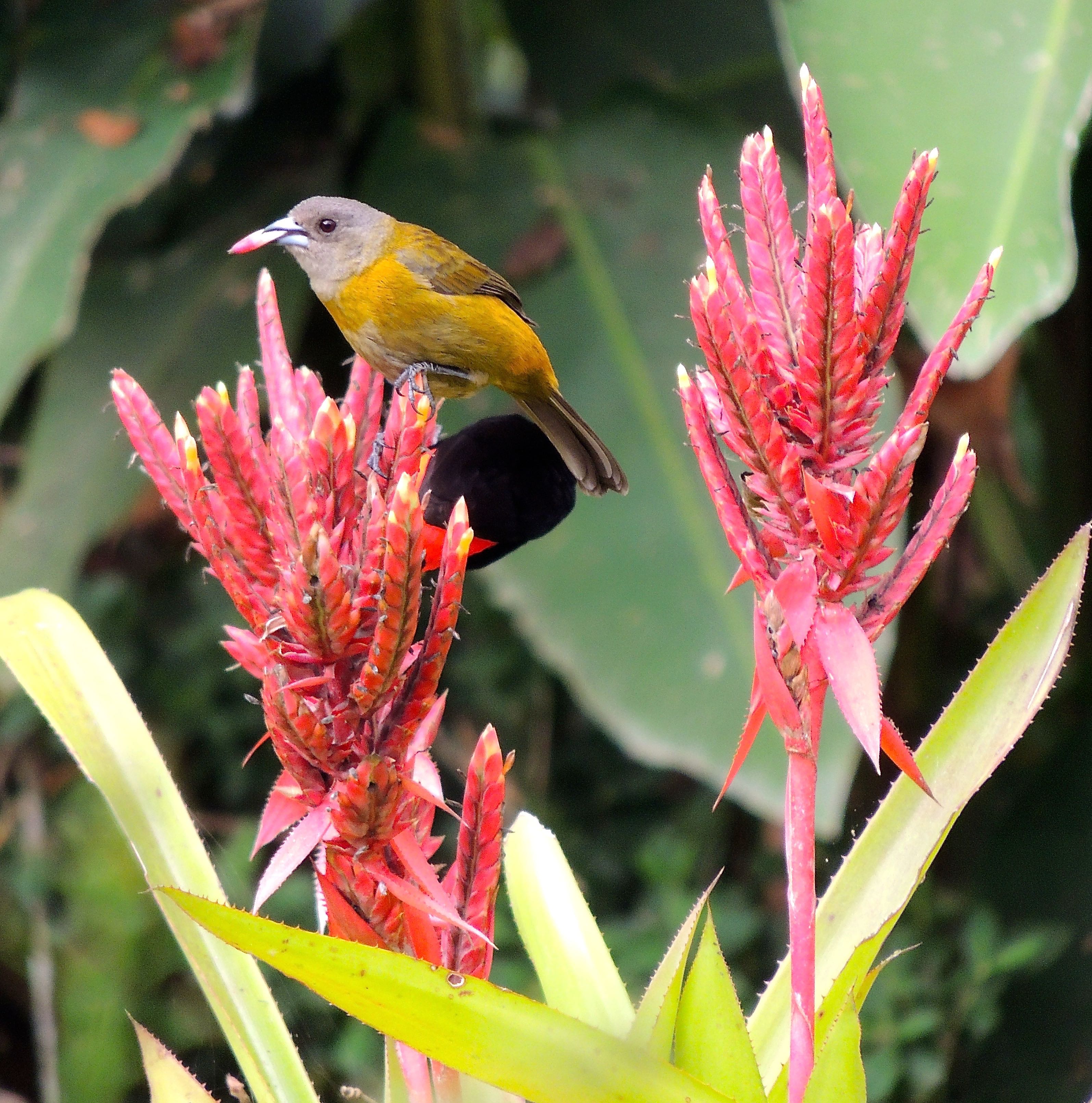 Female and Male Passerini's Tanager - Photo by William Young
Female and Male Passerini's Tanager - Photo by William Young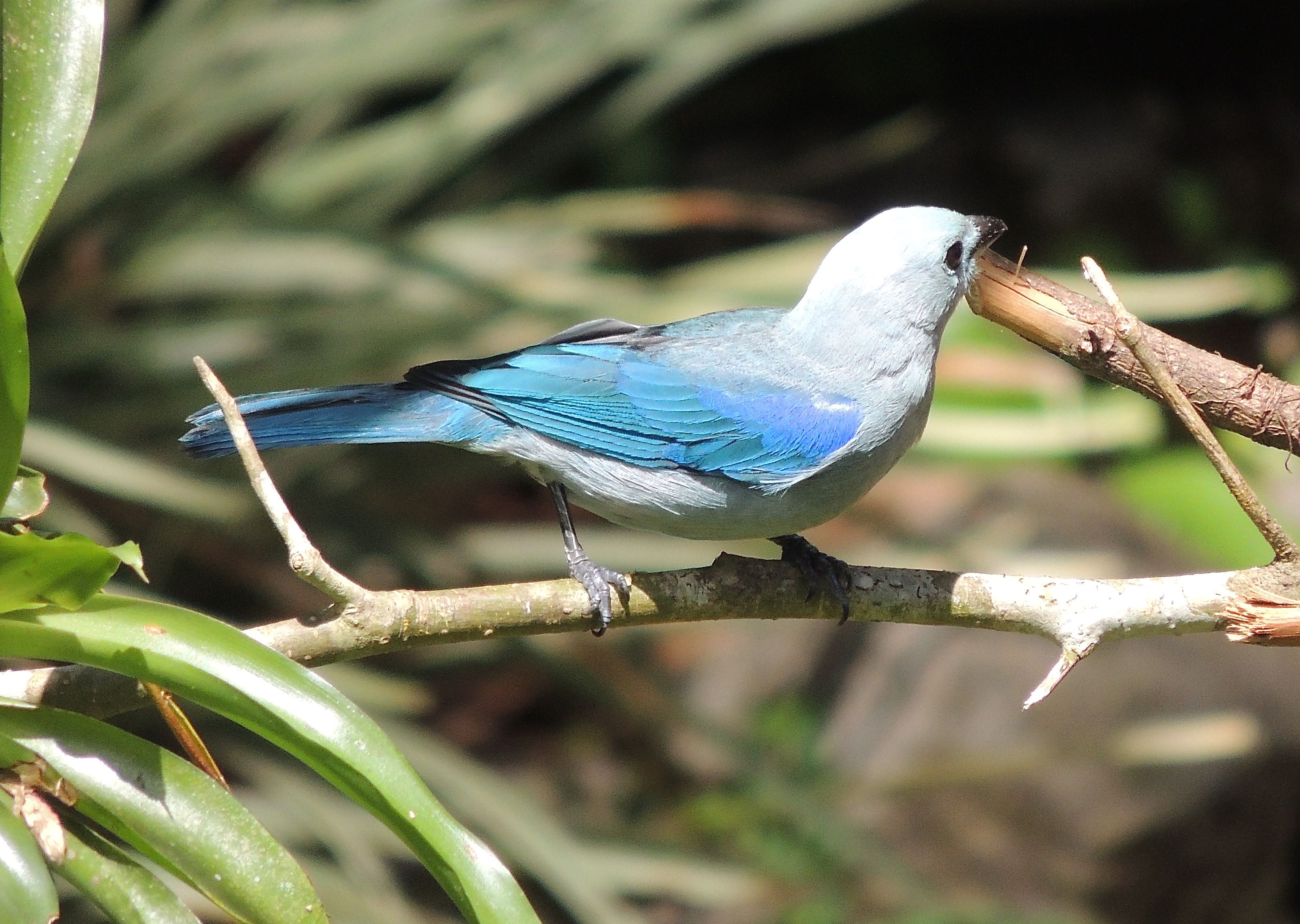 Blue-gray Tanager - Photo by William Young
Blue-gray Tanager - Photo by William Young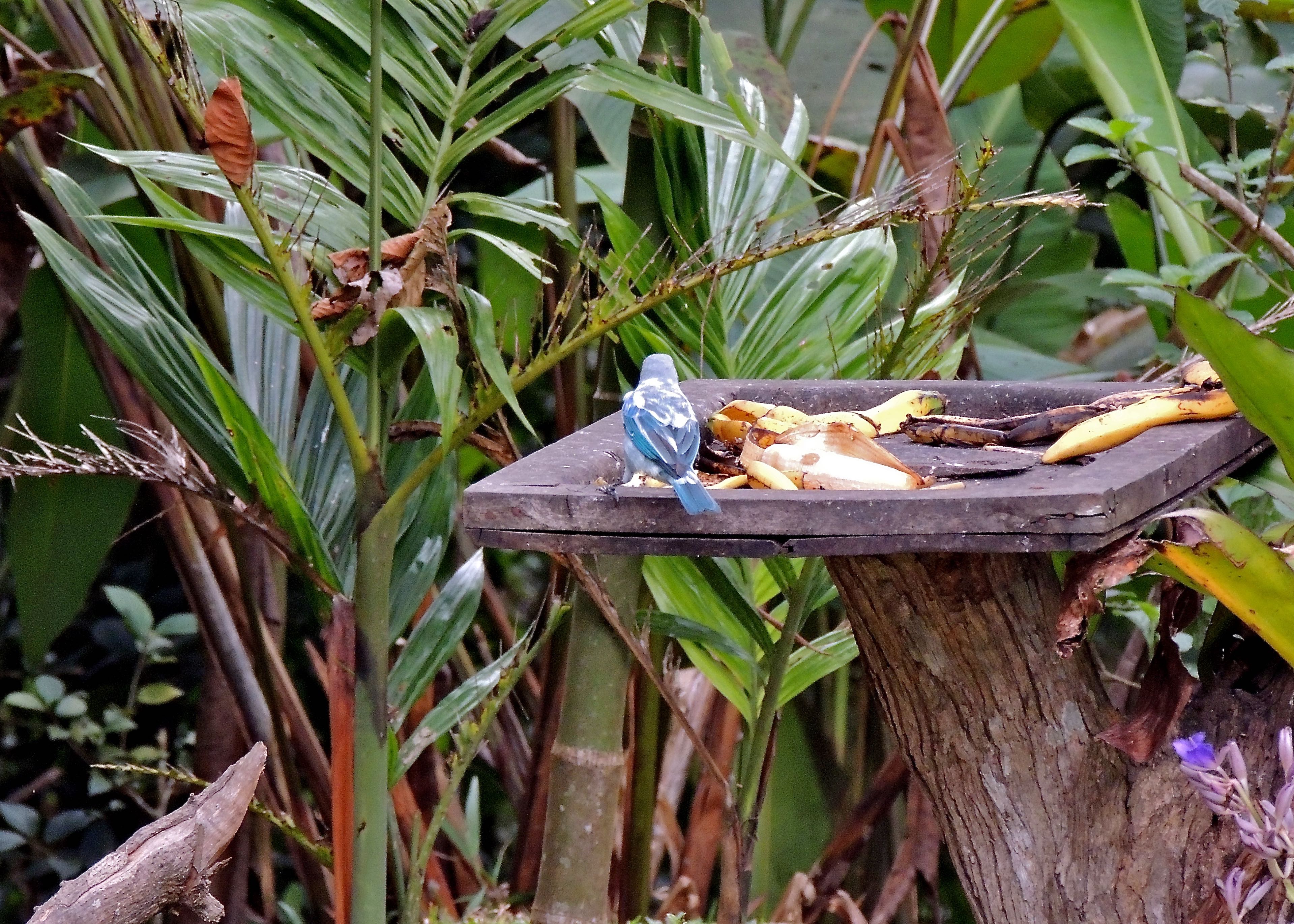 Luecistic Blue-gray Tanager - Photo by William Young
Luecistic Blue-gray Tanager - Photo by William YoungMale White-lined and White-shouldered Tanagers are black birds with a bit of white on the shoulder that is usually mostly hidden. The white showed a lot when both species flew. One of the best ways to tell them apart was to look at the females. The female White-lined is a rufous bird, while the female White-shouldered is olive and yellow. The White-lined usually traveled in male-female pairs and is larger than the White-shouldered. We saw a pair of Tawny-crested Tanagers at the base of Cerro Silencio. The male is all black with a tawny beret. The area around Cerro Silencio had a lot of tanagers. I had nice looks at a couple of male Black-and-yellow Tanagers, who are canary-yellow with black wings. The females are greenish with a yellow throat and breast. A Crimson-collared Tanager was perched for a long time at the top of a bare tree. It has a red head and collar, and a black face and breast. Emerald Tanagers are warbler-sized, and I saw the black comma behind the ear on this mostly green bird. On the trails at Rancho Naturalista, Mercedes found some Speckled Tanagers, who are lemon-lime colored with a lot of black spots. I saw a Bay-headed Tanager in a tree on the road to Rancho Naturalista. Along the Rio Tuis, we ran into a large group of Silver-throated Tanagers. They are mostly yellow with a white throat. Golden-hooded Tanagers were fairly common, and I saw them on five different days. Red-throated Ant-Tanagers hung around the moth light, and I had good looks at both the males and females. They seem sluggish. The male has a red throat, while the female's throat is yellow.
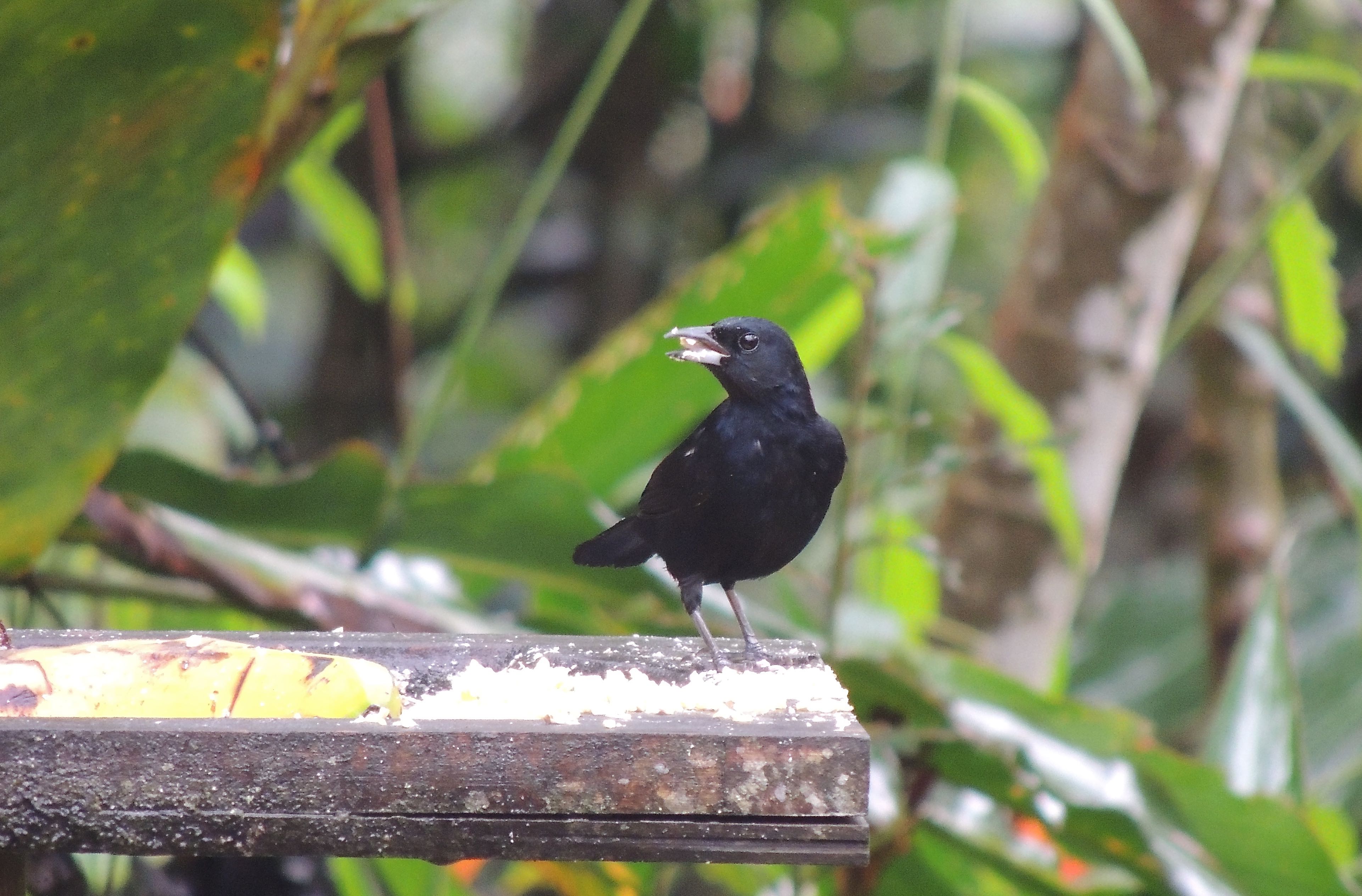 White-lined Tanager - Photo by William Young
White-lined Tanager - Photo by William YoungI saw three species of euphonias. The Tawny-capped Euphonia was common and surprisingly tame. The male has a blue back and throat, yellow underparts, and a tawny cap. Yellow-throated Euphonias were also common, with the male having a blue back and yellow underparts. Rather than a tawny crown, he has a yellow forehead. The Olive-backed Euphonia is a mostly olive bird, with the males having a yellow cap and the females a tawny cap. I saw a couple of Green Honeycreepers. At Quetzal's Paradise, we saw a Sooty-capped Chlorospingus, who used to be called a Sooty-capped Bush-Tanager. It has an olive back, a yellow breast, a grayish throat, and a black cap with a white supercilium. On the way home from Quetzal's Paradise, we stopped in a gift shop. A Slaty Flowerpiercer had flown inside and could not find its way out. Lisa managed to get hold of it and let it loose outside, but not before I took a photo of the tiny bird in her hand. I could see the hook on the end of its bill, which it uses to steal the nectar from flowers without pollinating them.
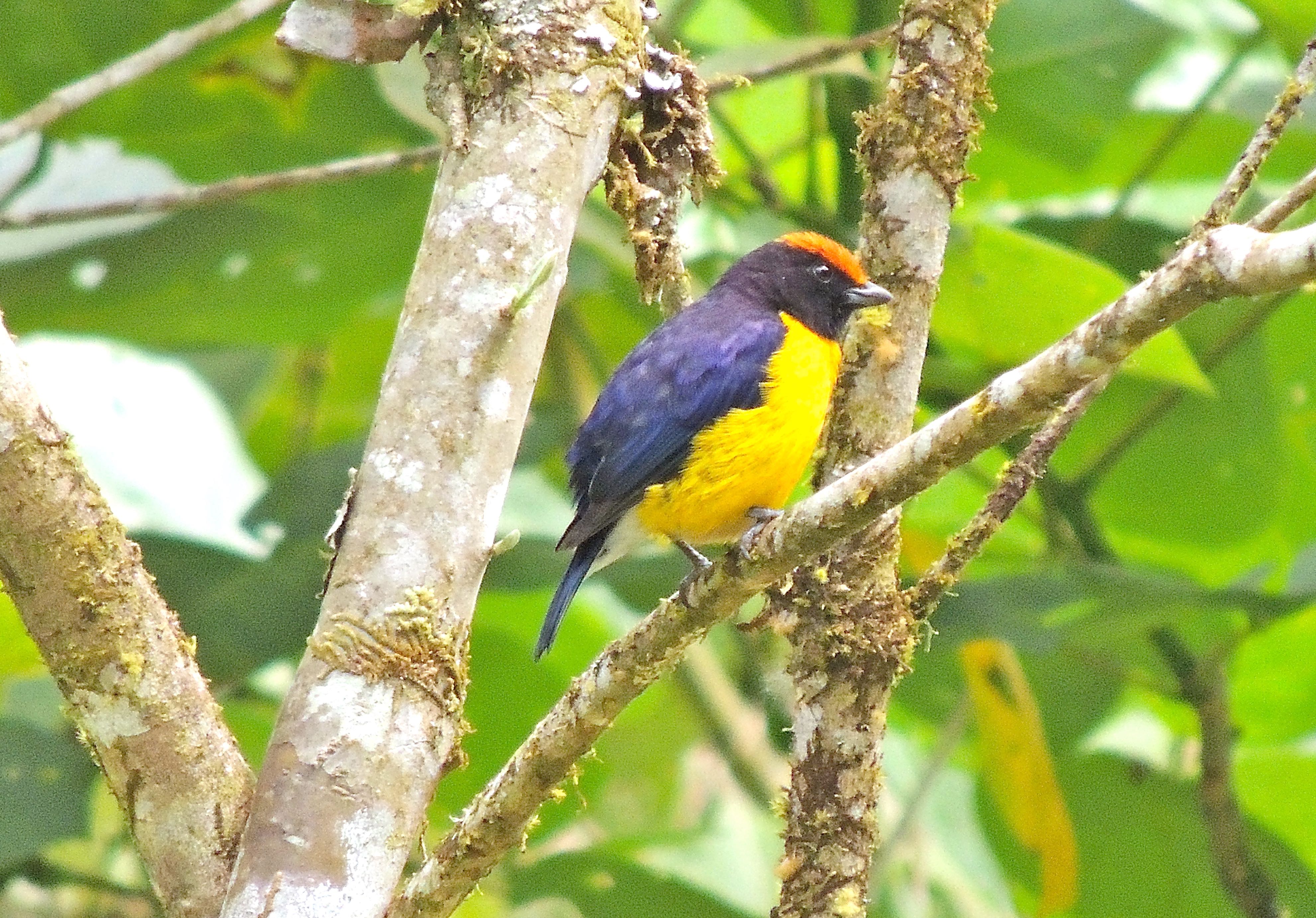 Tawny-capped Euphonia - Photo by William Young
Tawny-capped Euphonia - Photo by William Young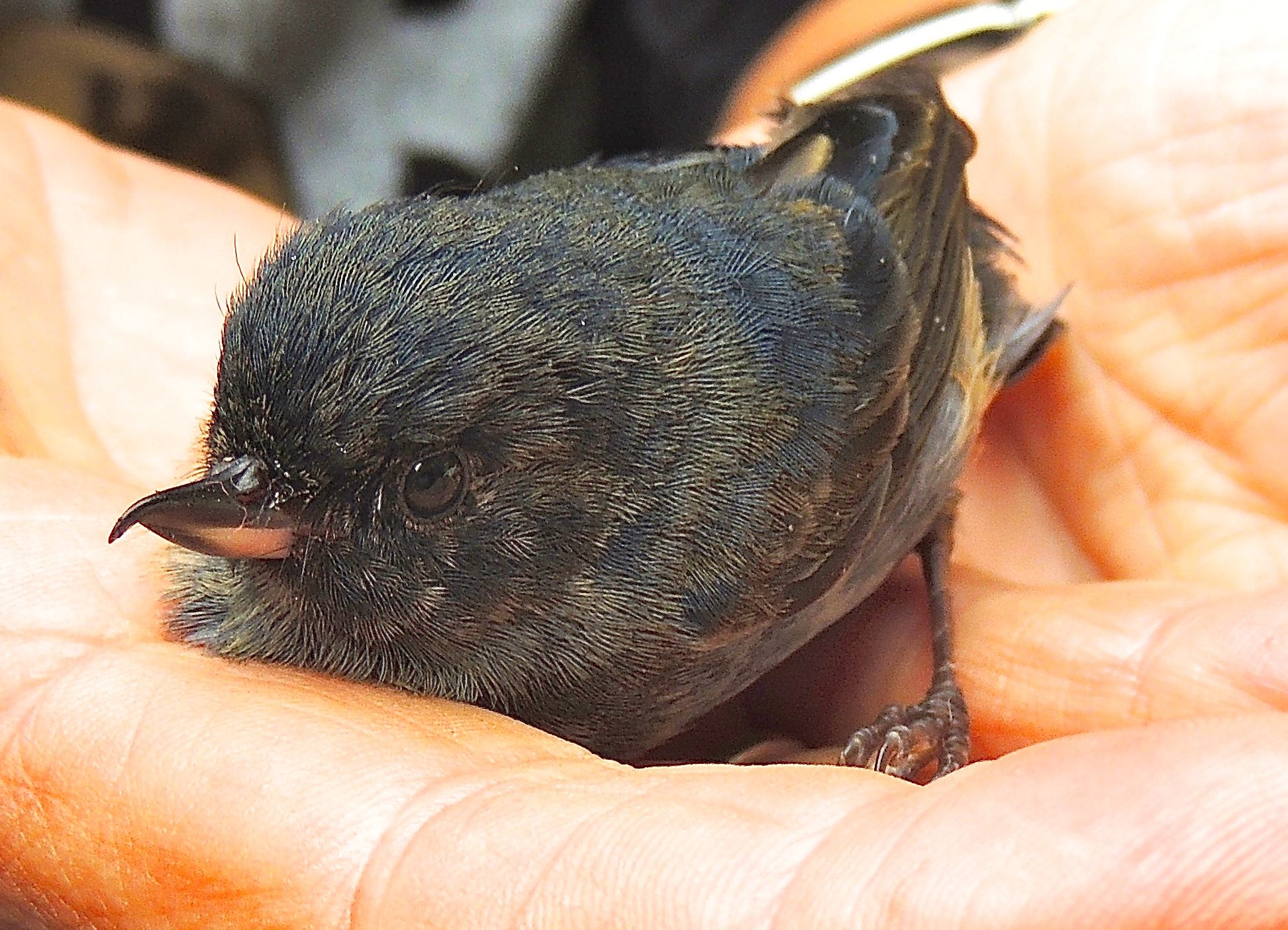 Slaty Flowerpiercer - Photo by William Young
Slaty Flowerpiercer - Photo by William YoungWe saw all three saltators. Buff-throated Saltators occasionally came to the feeders. Black-headed Saltators have a black head, with a white eyebrow and a white throat. The two species were often seen in the same places. The Black-headed has a loud one-note call. The Grayish Saltator is gray with a white throat and a white supercilium.
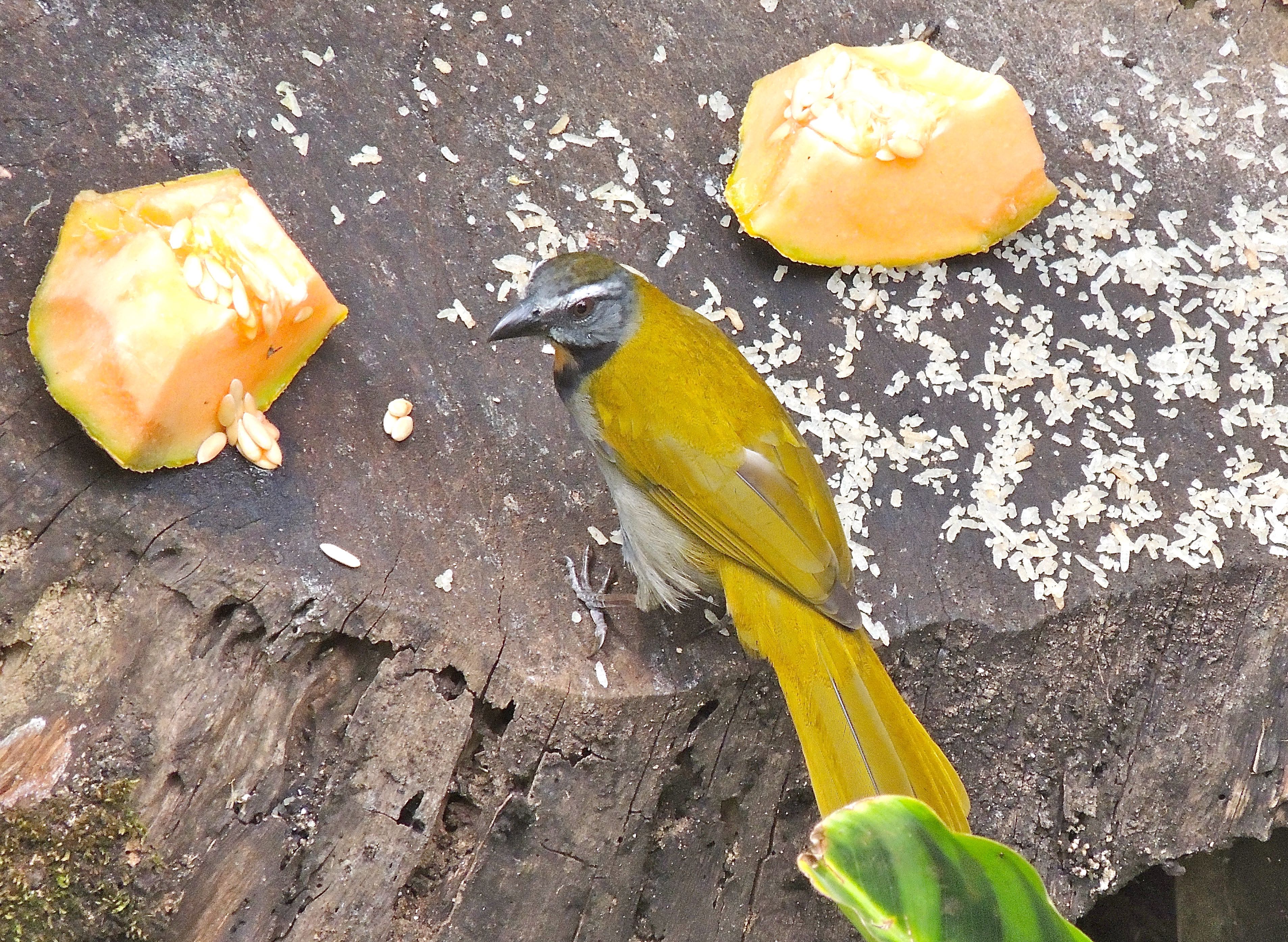 Buff-throated Saltator - Photo by William Young
Buff-throated Saltator - Photo by William YoungFinches and Sparrows
The most common finch was the Yellow-faced Grassquit. Some came to the feeders at Rancho Naturalista and Wayne Easley's house, and large flocks were sometimes along the road in agricultural areas. They are tiny. The males have a yellow X on the face, while the markings on the female's face are more subtle. I saw a Blue-black Grassquit at La Mina. It is a small dark bird. Quite a few Variable Seedeaters were around Turire. The males in Costa Rica are small dark finches. A somewhat larger all dark finch is the male Thick-billed Seed-Finch. The female is a rich brown, and both sexes have large bills. Orange-billed Sparrows were common around Rancho Naturalista and at Wayne Easley's feeders. Virginia does not have any sparrows who are as colorful. Black-striped Sparrows were common. They are olive-colored like the Orange-billed and have gray-and-black crown stripes. They provided an important part of the soundtrack for the trip. Their song, which they began to sing before sunrise, is a series of loud single whistles which gained in intensity before ending in a series of loud paired whistles. Rufous-collared Sparrows were common in a lot of places, and I saw House Sparrows on the drive to Rancho Naturalista from the airport. At Quetzal's Paradise, I saw Yellow-thighed Finches. They are a large slaty finch with yellow near the top of their legs. We also saw Large-footed Finches. They are dark olive with a black head. They move quickly, but I saw one with a stick in its mouth who stood on a log long enough for me to see the large feet.
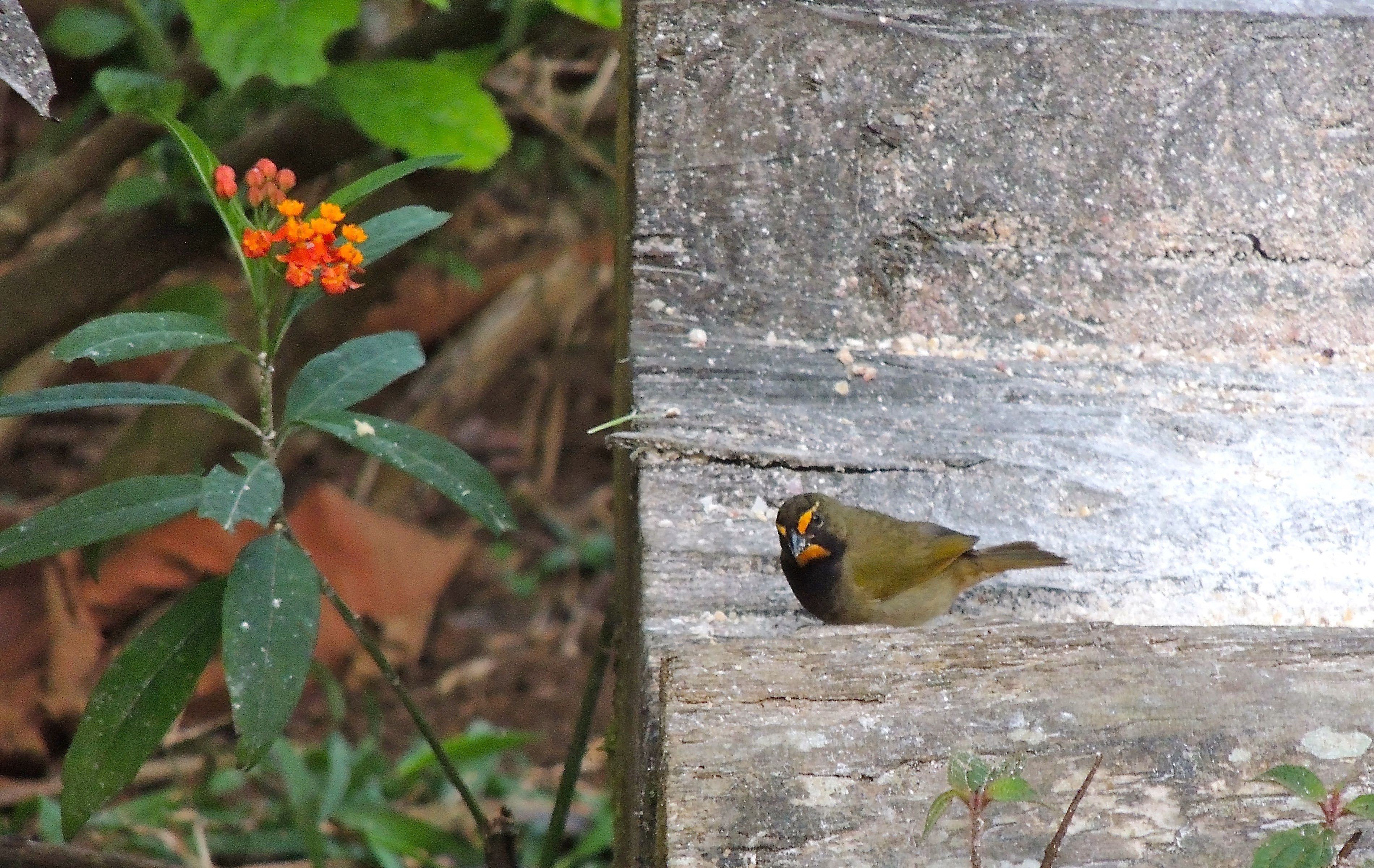 Yellow-faced Grassquit Male - Photo by William Young
Yellow-faced Grassquit Male - Photo by William Young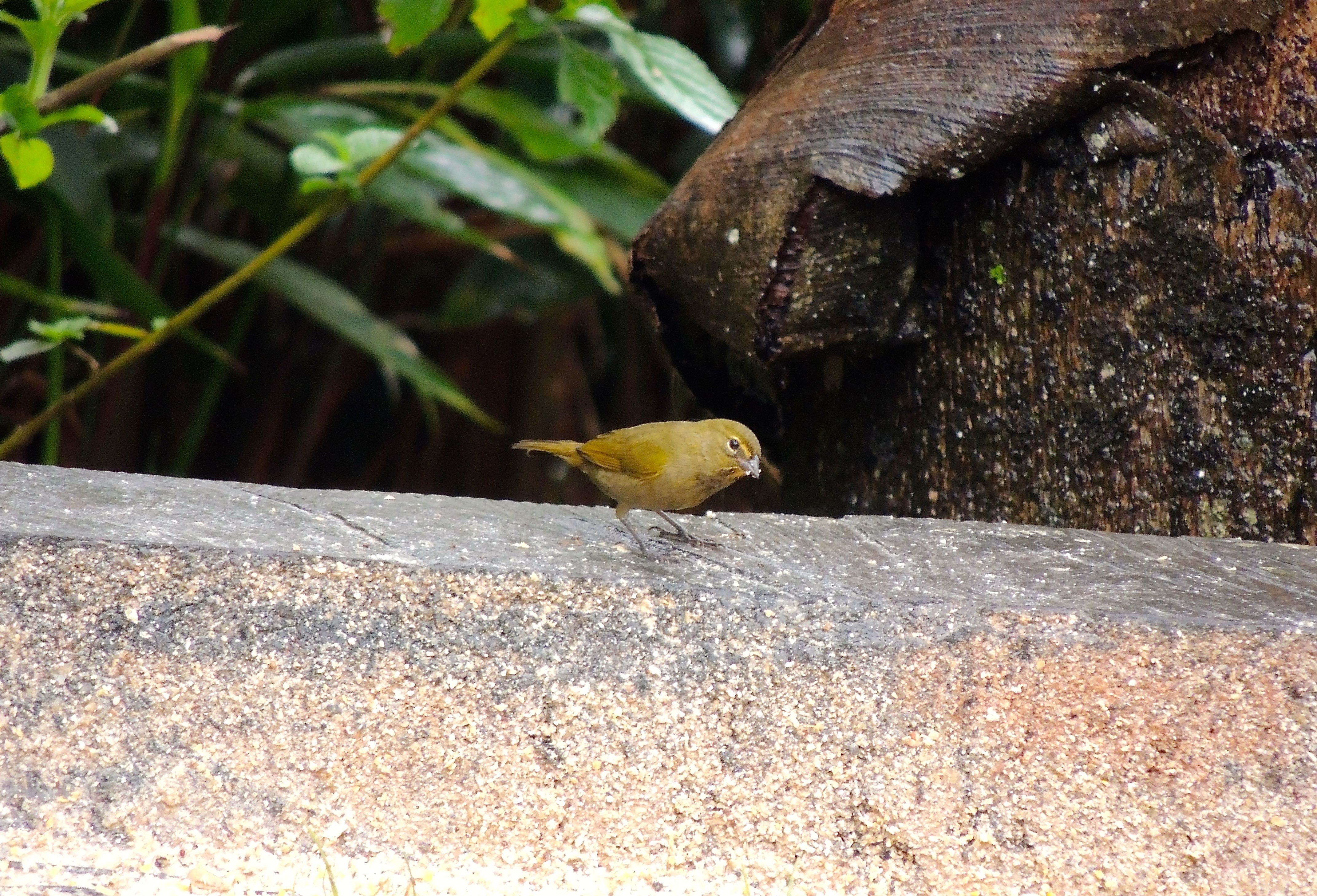 Yellow-faced Grassquit Female - Photo by William Young
Yellow-faced Grassquit Female - Photo by William Young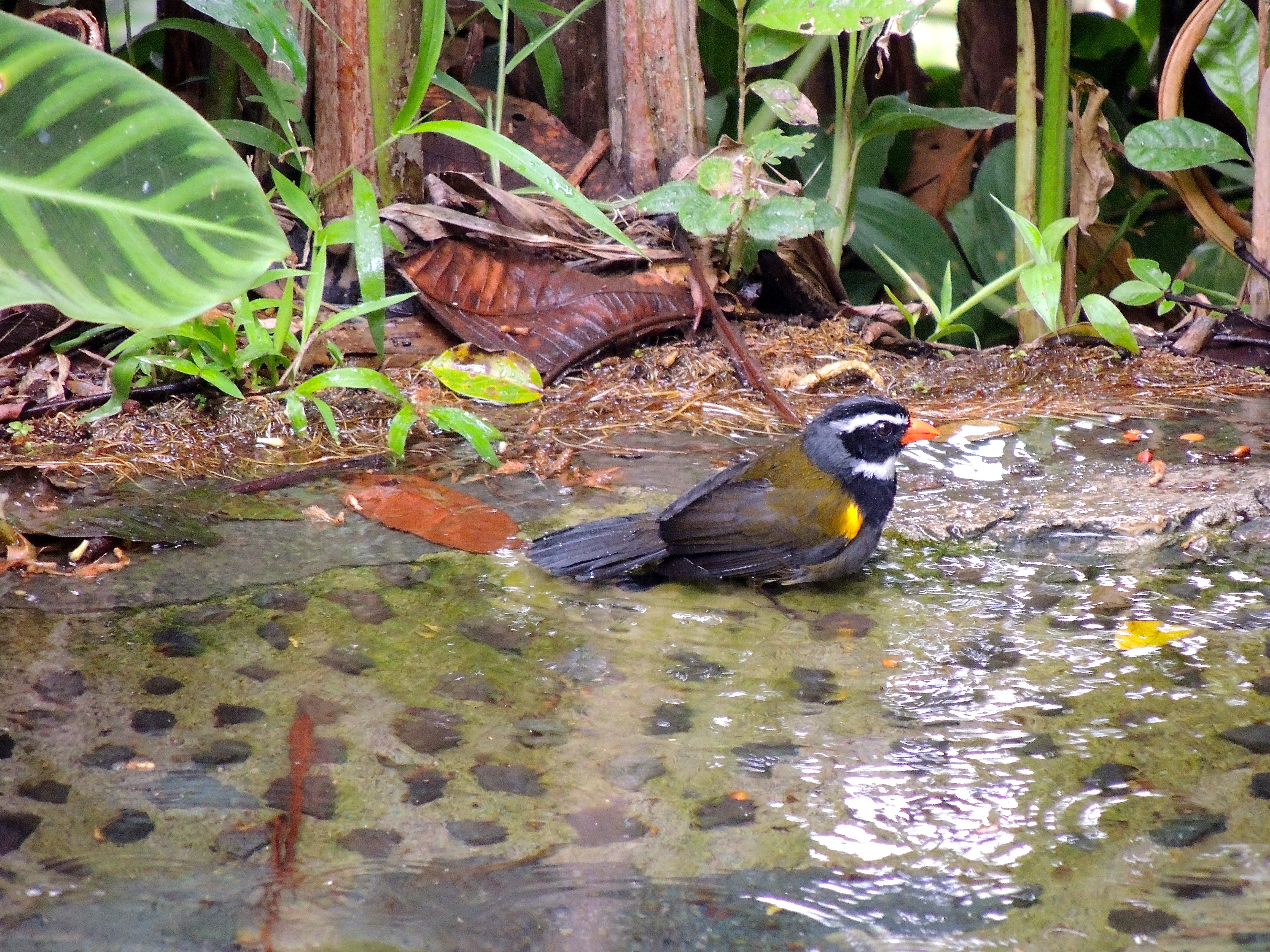 Orange-billed Sparrow - Photo by William Young
Orange-billed Sparrow - Photo by William Young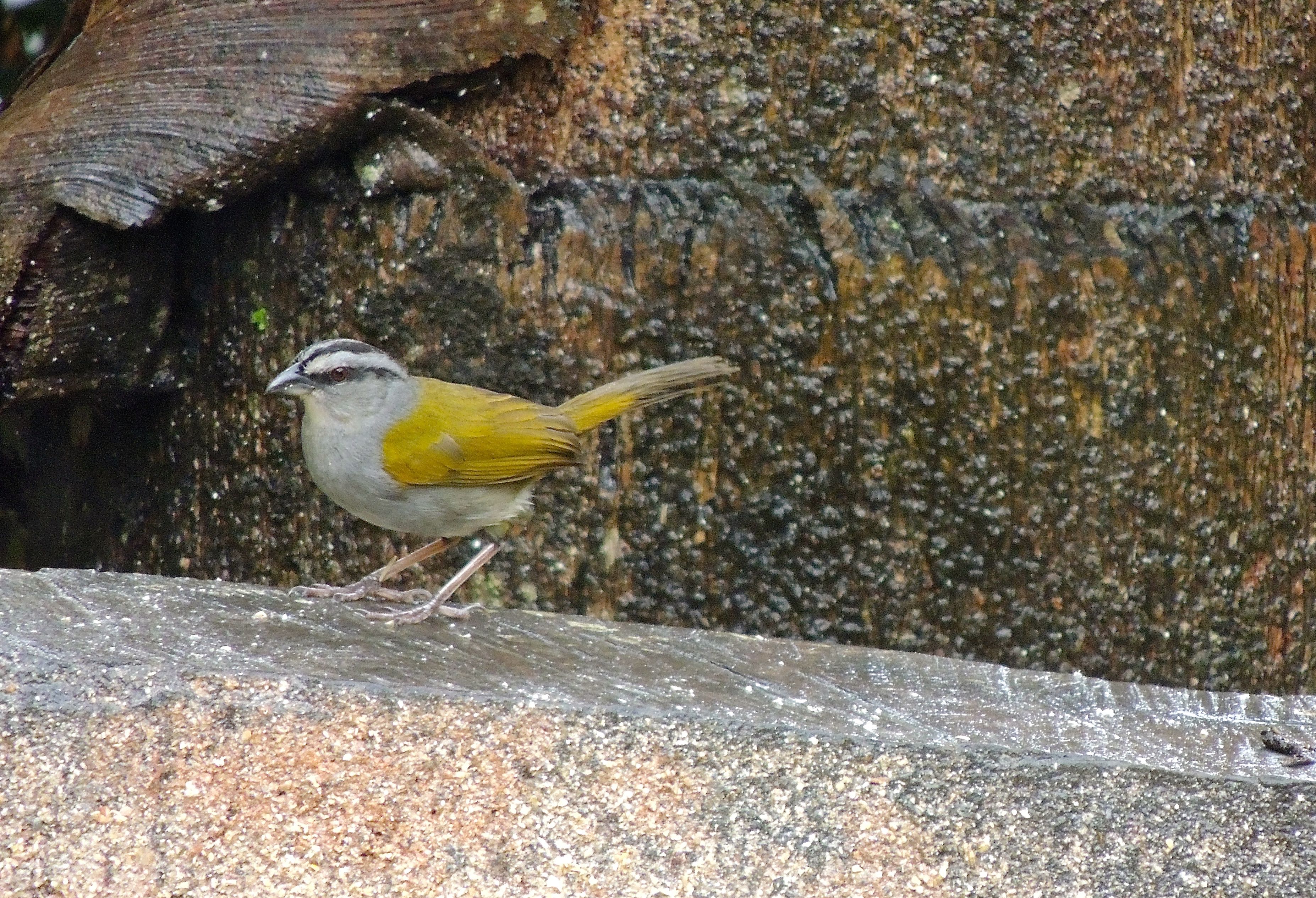 Black-striped Sparrow - Photo by William Young
Black-striped Sparrow - Photo by William Young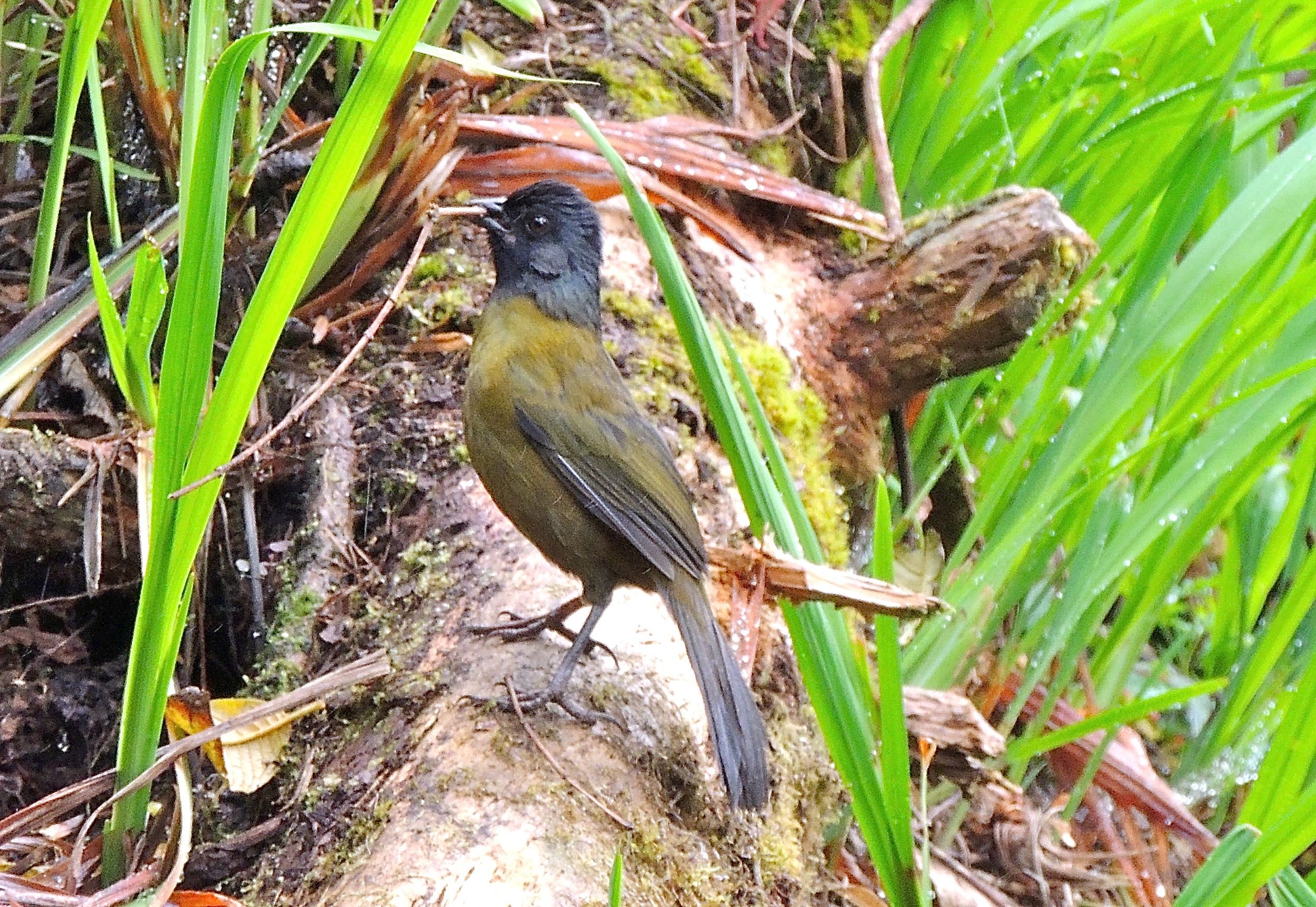 Large-footed Finch - Photo by William Young
Large-footed Finch - Photo by William YoungBlackbirds
My favorite blackbirds were the Montezuma Oropendolas. They were common around the feeders at Rancho Naturalista, and they have nests in the trees near Rancho Bajo and Wayne Easley's house. They displayed like other oropendolas I have seen, but they have much more colorful heads, with blue skin on the face and an orange bill with a black base. When they fly, their wings make a whooshing sound. I saw some carrying nesting material. Chestnut-headed Oropendolas have a whitish-yellow bill. The ranges of the two species overlap, and they make different sounds when displaying. The Chestnut-headed sometimes came to the feeders, but not often.
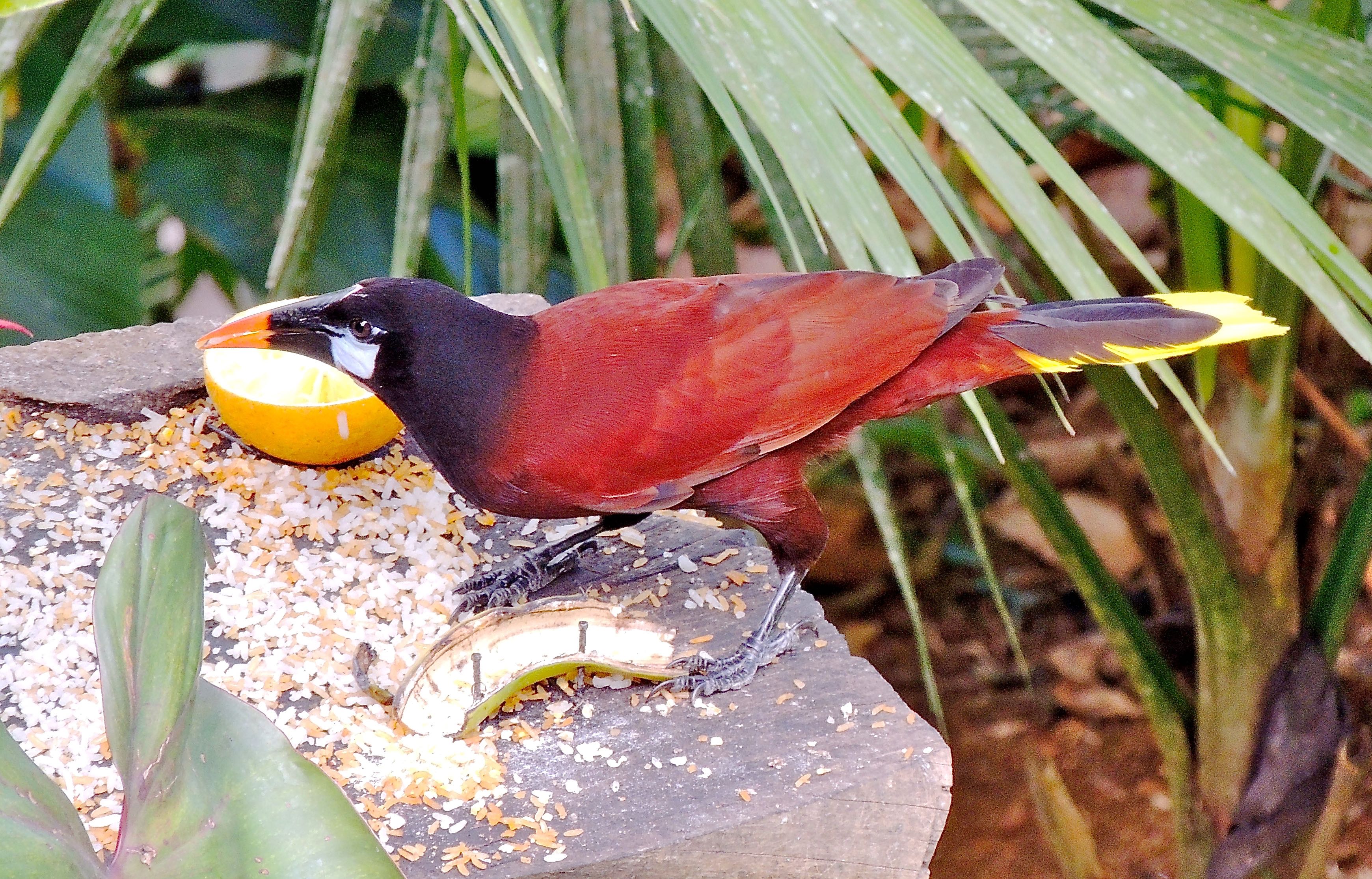 Montezuma Oropendola - Photo by William Young
Montezuma Oropendola - Photo by William YoungOccasionally, a Melodious Blackbird would be on the lawn in front of the dining area at Rancho Naturalista. The song is not very melodious. Its introductory note is followed by an upward whistle. A female Baltimore Oriole came to the Rancho Naturalista feeders, and I saw bright orange males at the bridge at Platanillo and a couple of other places. I saw an Eastern Meadowlark walking on a driveway on my ride from the San Jose Airport, and Mercedes and I saw one in a field near Casa Turire. The same field had Red-breasted Meadowlarks. We saw some in the grass, and one sang from a fence post. Great-tailed Grackles were very common along the road and in some of the agricultural areas, and they seemed to fill a similar urban niche to the one that starlings occupy where I live. Bronzed Cowbirds were in the fields at the base of Cerro Silencio, and another was at a feeder at Quetzal's Paradise. A couple of Giant Cowbirds came to the feeders at Wayne Easley's house. They are very large with a red eye. They often parasitize oropendola colonies, and there were Montezuma Oropendola nests in the tall trees near Wayne's house. Also at Wayne's feeders was a Yellow-billed Cacique. They are usually shy birds, so seeing one at a feeder was a surprise.
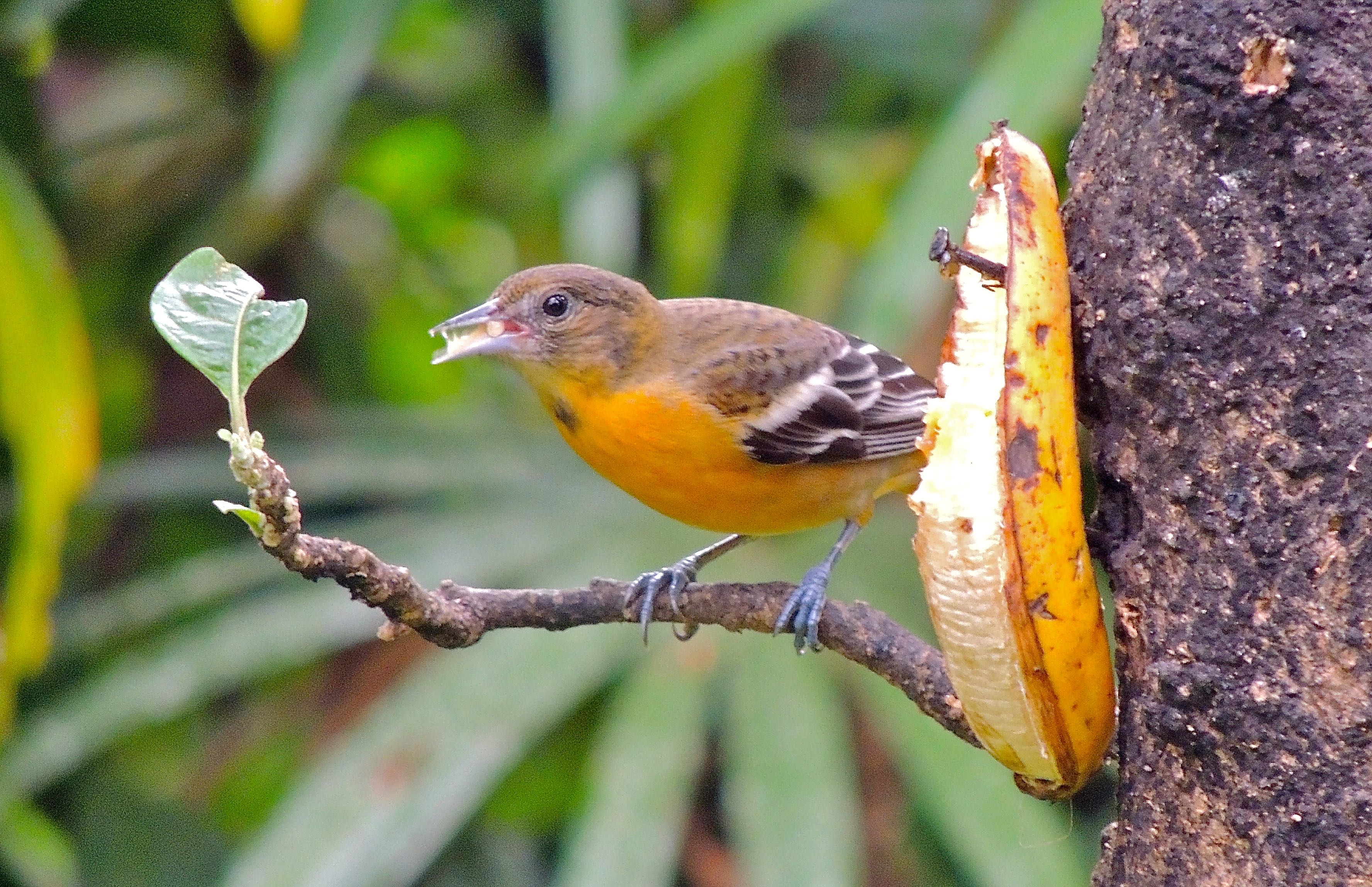 Baltimore Oriole Female - Photo by William Young
Baltimore Oriole Female - Photo by William Young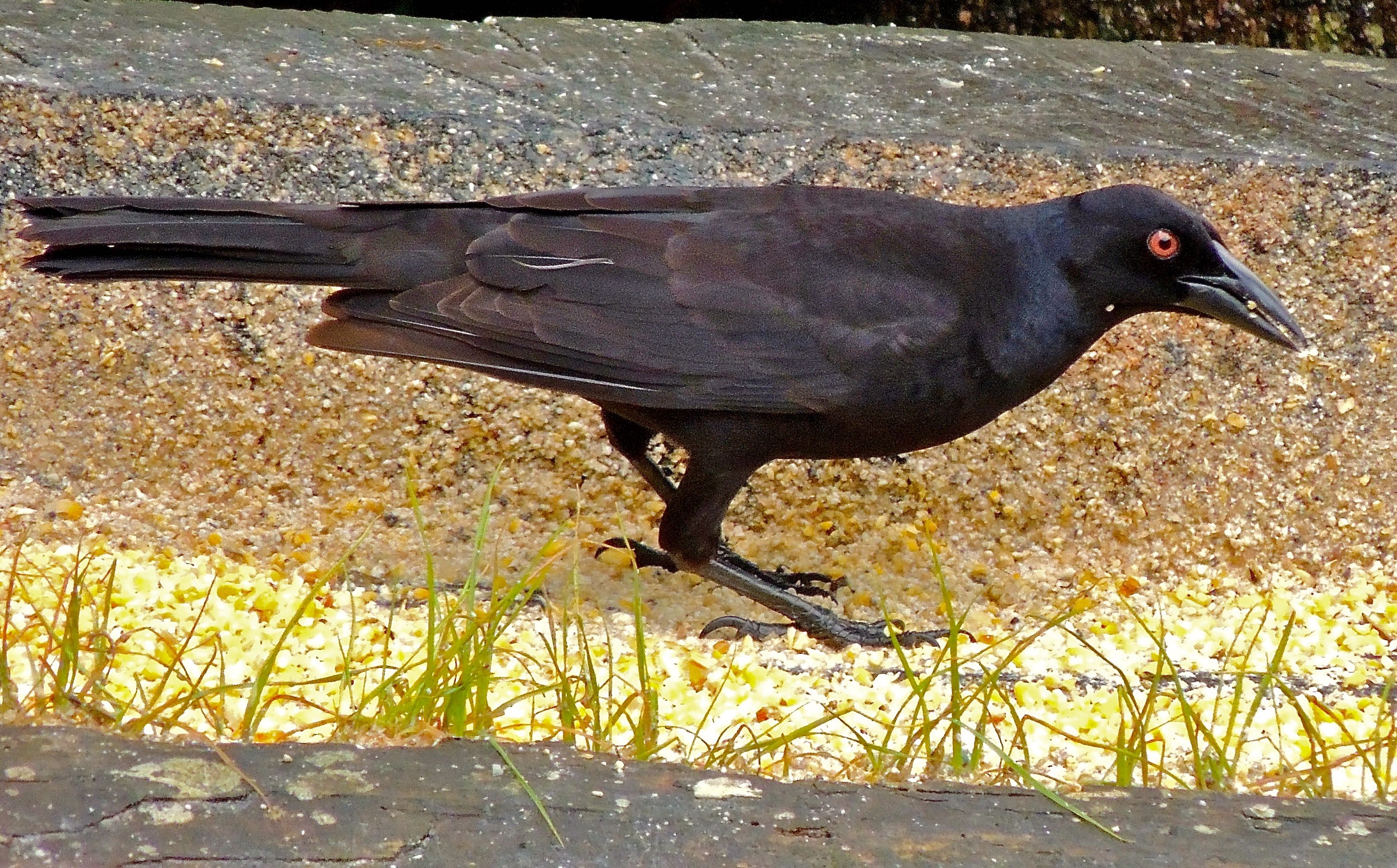 Giant Cowbird - Photo by William Young
Giant Cowbird - Photo by William Young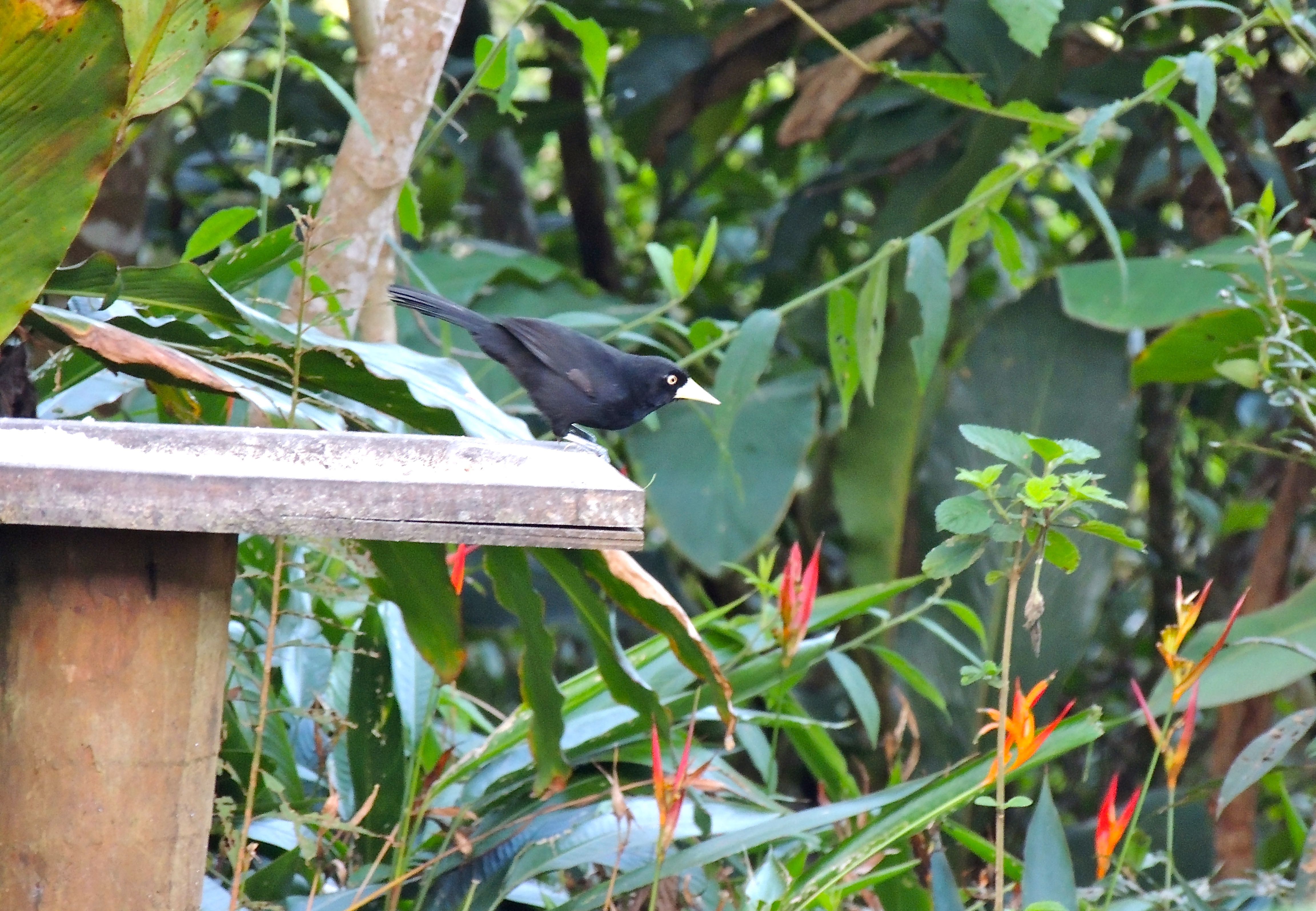 Yellow-billed Cacique - Photo by William Young
Yellow-billed Cacique - Photo by William YoungOther Wildlife
I did not see a lot of mammals at Rancho Naturalista. I saw both Red-tailed and Variegated Squirrels. At Casa Turire, Mercedes and I saw a Nutria by the dock. From the same dock, we saw a Spectacled Caiman. On the way to CATIE, Luis found a tiny brown frog who was less than an inch long. Lisa found a Talamancan Palm-Pit Viper when we were looking at the quetzals. It is a venomous endemic snake with green-and-black scales, and it appeared to be more than two feet long. People who live in the area kill such snakes, so our guide from Quetzal's Paradise picked it up and called someone to put it into a sack and bring it to a safe place. Rancho Naturalista has House Geckos. For such a small creature, its vocalizations are extremely loud.
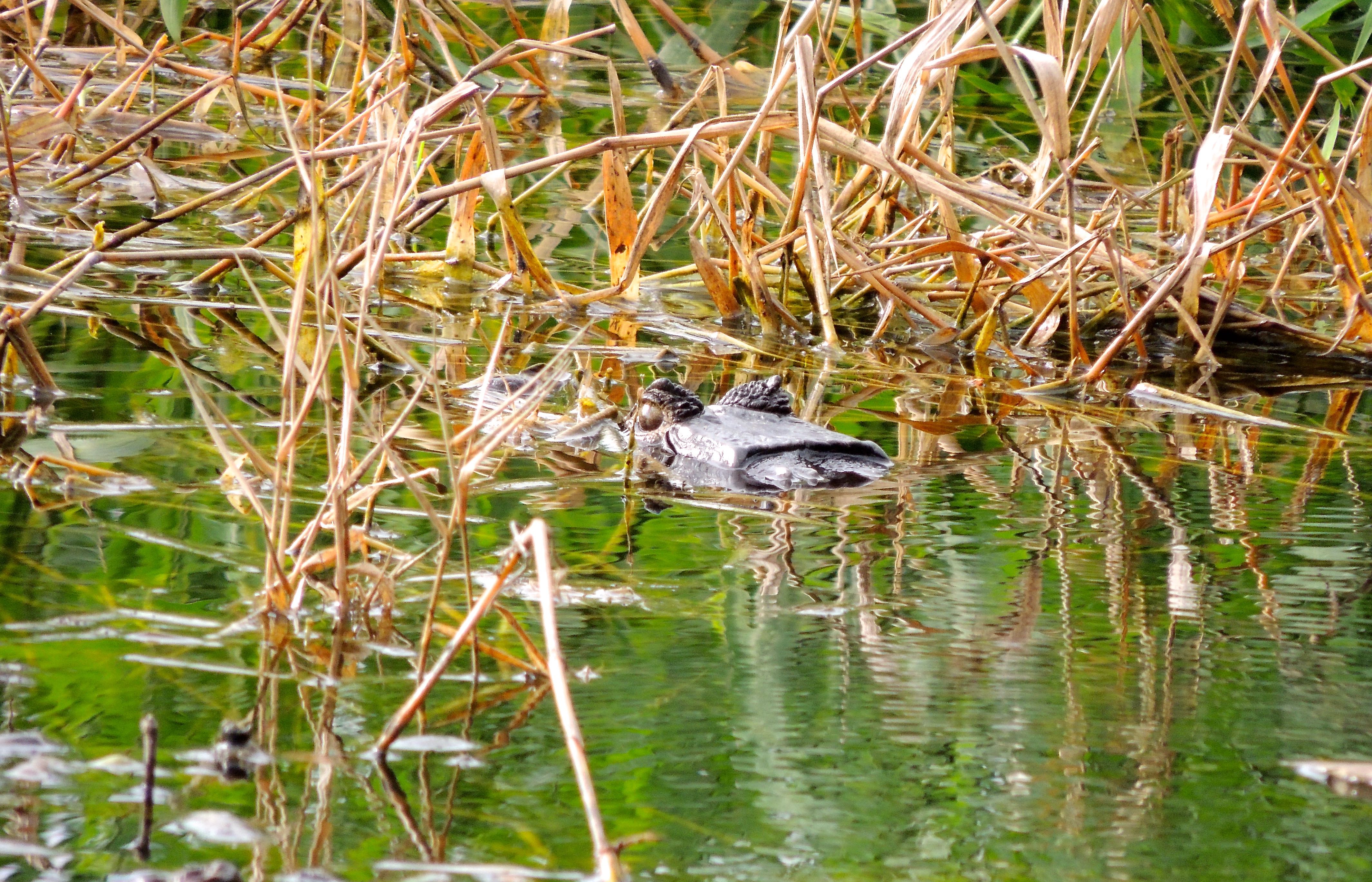 Spectacled Caiman - Photo by William Young
Spectacled Caiman - Photo by William Young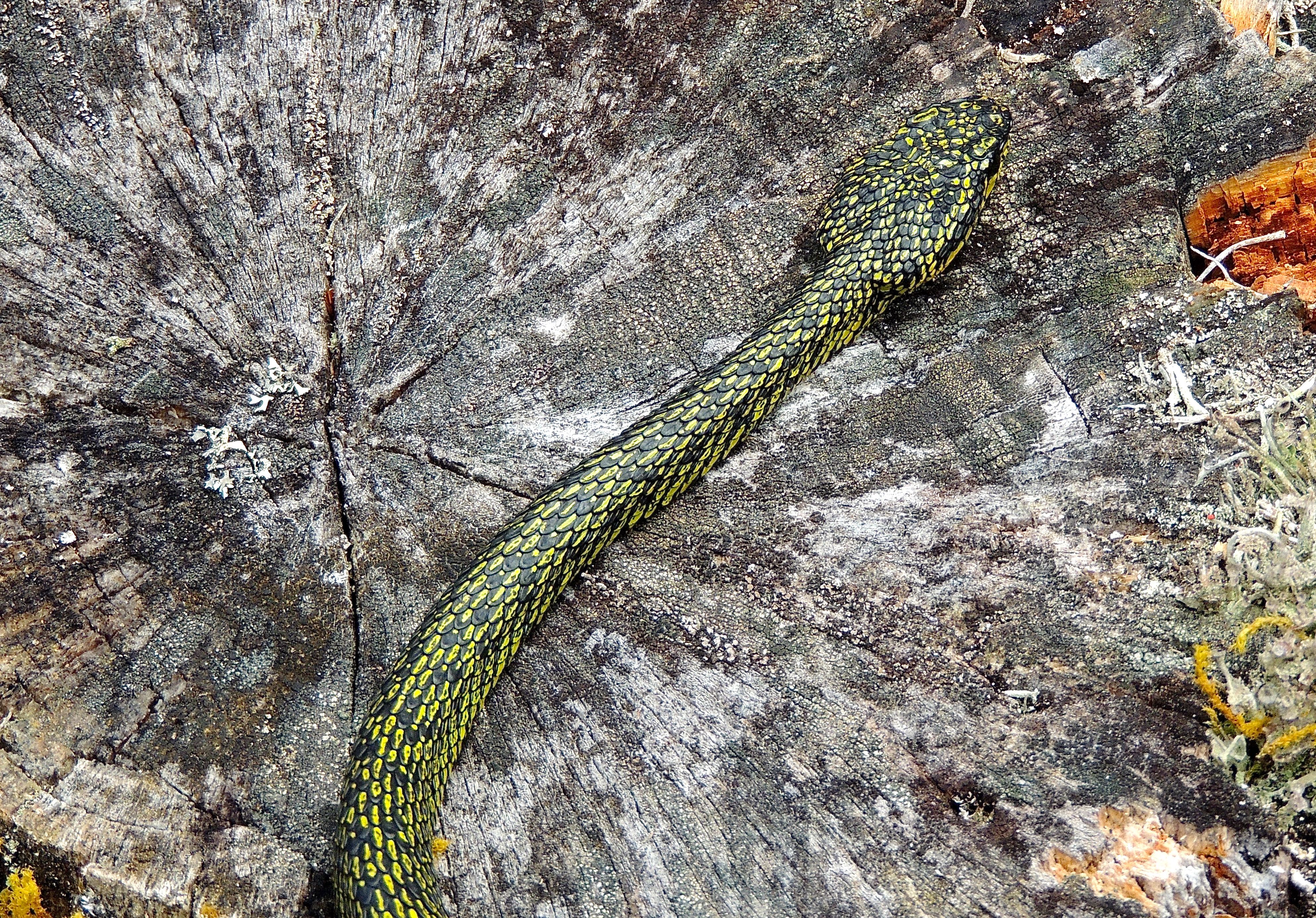 Talamancan Palm-Pit Viper - Photo by William Young
Talamancan Palm-Pit Viper - Photo by William YoungI enjoyed seeing and photographing moths during the trip. I went to the moth light at Rancho Naturalista and watched birds come in during the early morning to eat moths from a sheet. Once when nobody was around, I looked at the moths on the sheet. After that, I began to feel sorry for the moths. A lot of birders also watch butterflies, but I think moths have far more variety — they are not just another pair of pretty wings. I especially liked the moths at Wayne Easley's house. Most of the moths do not have common names and are called by their Latin names. The Dirphiopsis flora was my favorite. It is red and furry with long yellow antennae and big black eyes. The wings have lovely pastels, with a light mark on each. The Eumorpha anchemolus is a large sphinx moth who looks as if it were wearing camo clothing. The Viviennea tegyra has black-and-yellow wings and an orange body. Its tail end is a rich iridescent blue. The Pseudosphex moza is a wasp mimic — "sphex" is a genus of digger wasps. It has a dark blue body with the tail end looking like the pink eraser at the end of a pencil. The Adeloneivaia jason is one of the prettier moths. It has an orange body and broad orange wings tinged with lavender. The Dyspteris vecinaria is a lovely shimmering silver with two horizontal sea green lines across the wings. The head and top of the thorax are also sea green. The Acrosemia vulpecularia has orange-brown wings that appears to have a lot of green moss on them. There is a light mark near the tip of each wing. Wayne also showed me a Dobsonfly, as well as the larvae of Hercules Beetles, who were longer and thicker than my thumb. I saw a lot of Blue Morpho Butterflies during my stay in Costa Rica. In flight, they wobble as if drunk, which makes them very difficult to photograph. I saw quite a few Smooth-banded Sisters.
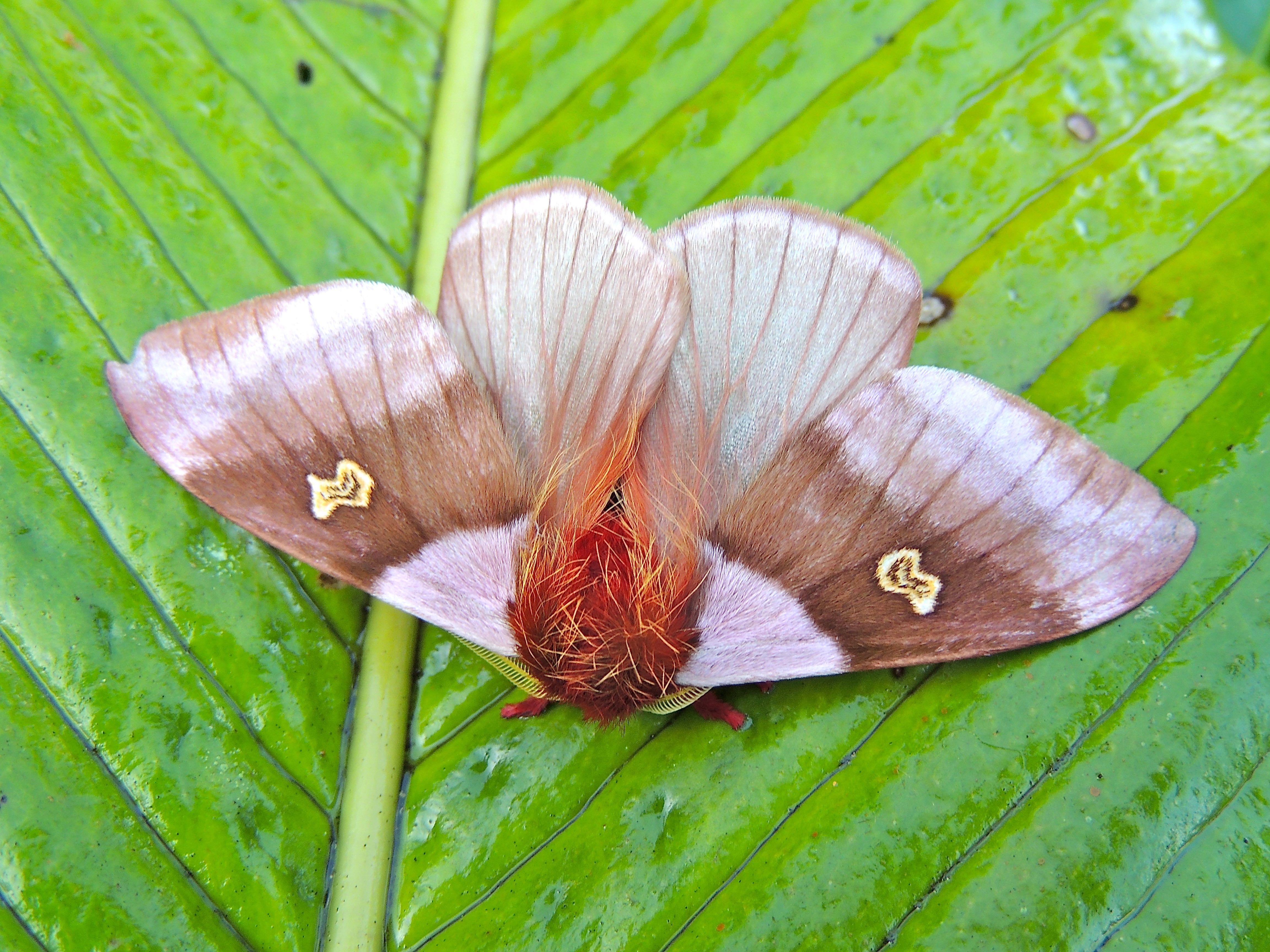 Dirphiopsis flora - Photo by William Young
Dirphiopsis flora - Photo by William Young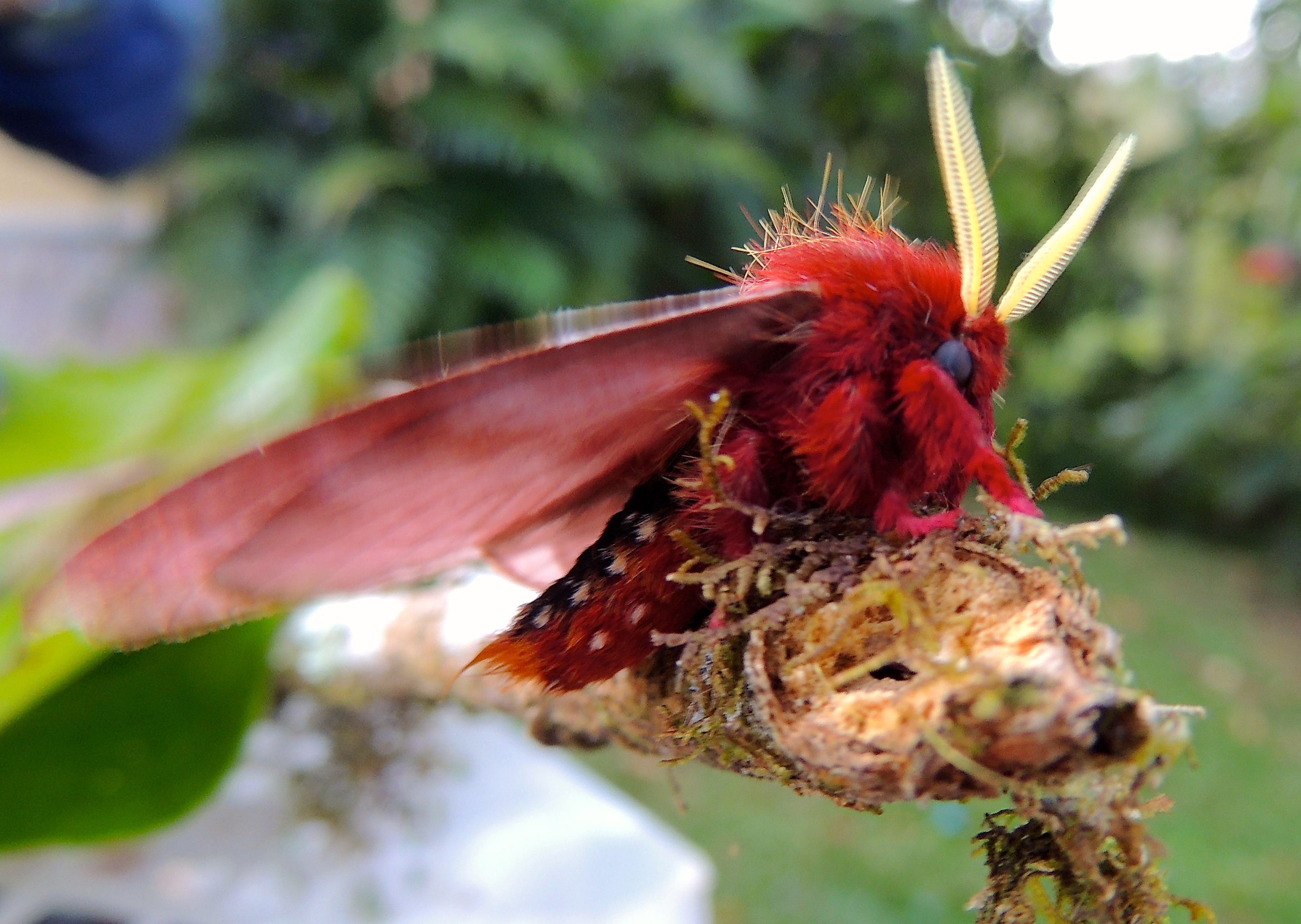 Dirphiopsis flora - Photo by William Young
Dirphiopsis flora - Photo by William Young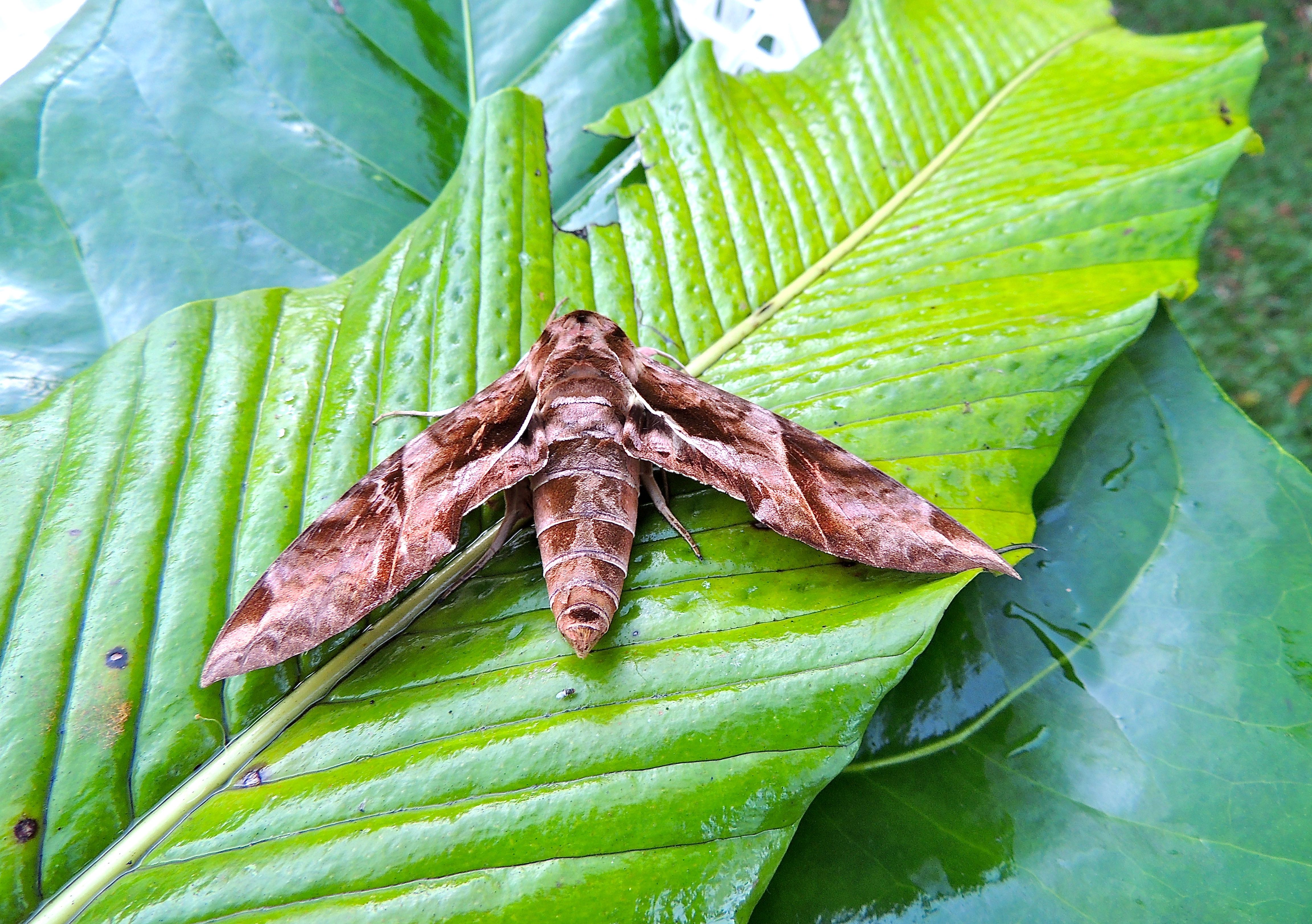 Eumorpha anchemolus - Photo by William Young
Eumorpha anchemolus - Photo by William Young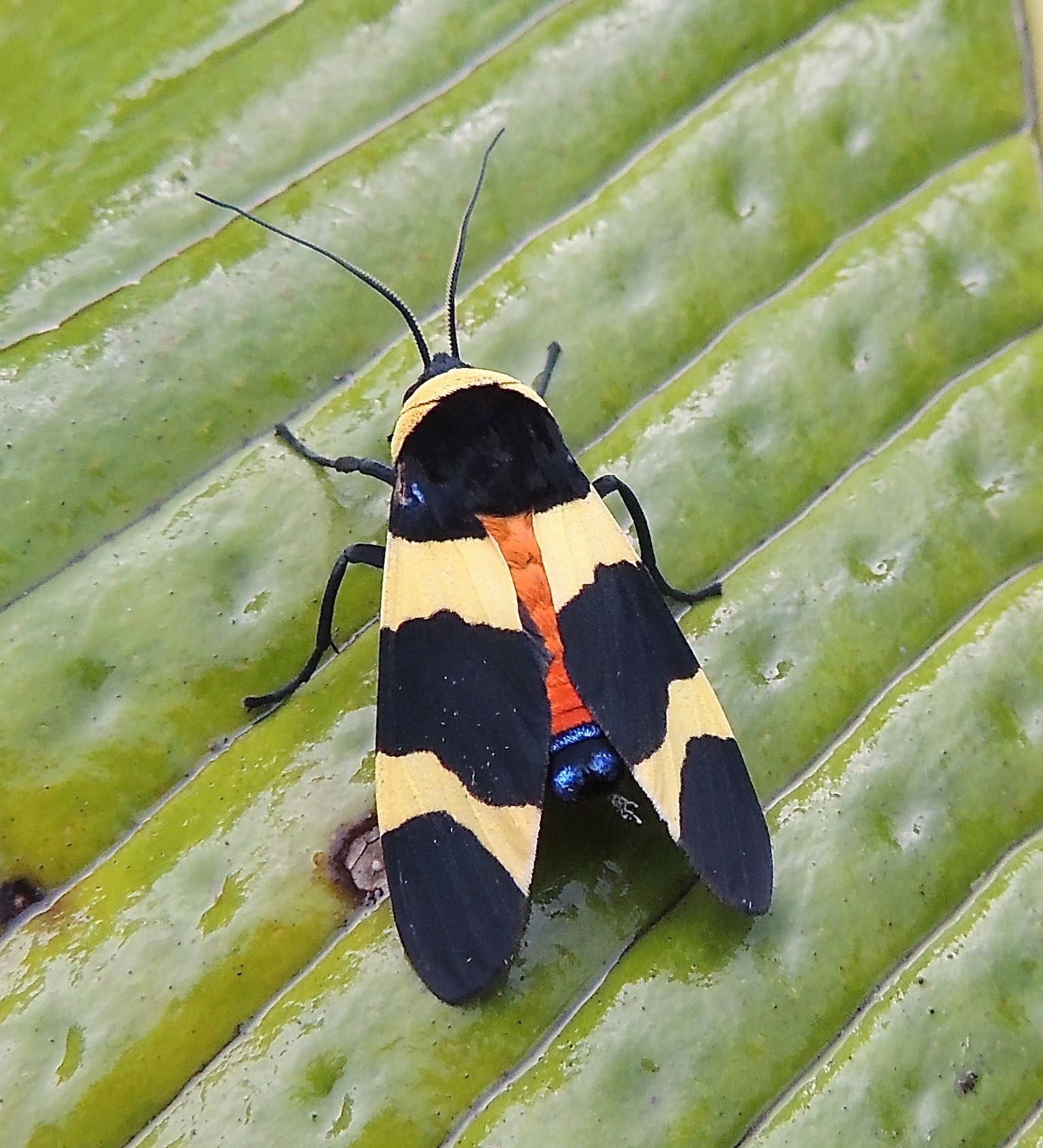 Viviennea tegyra - Photo by William Young
Viviennea tegyra - Photo by William Young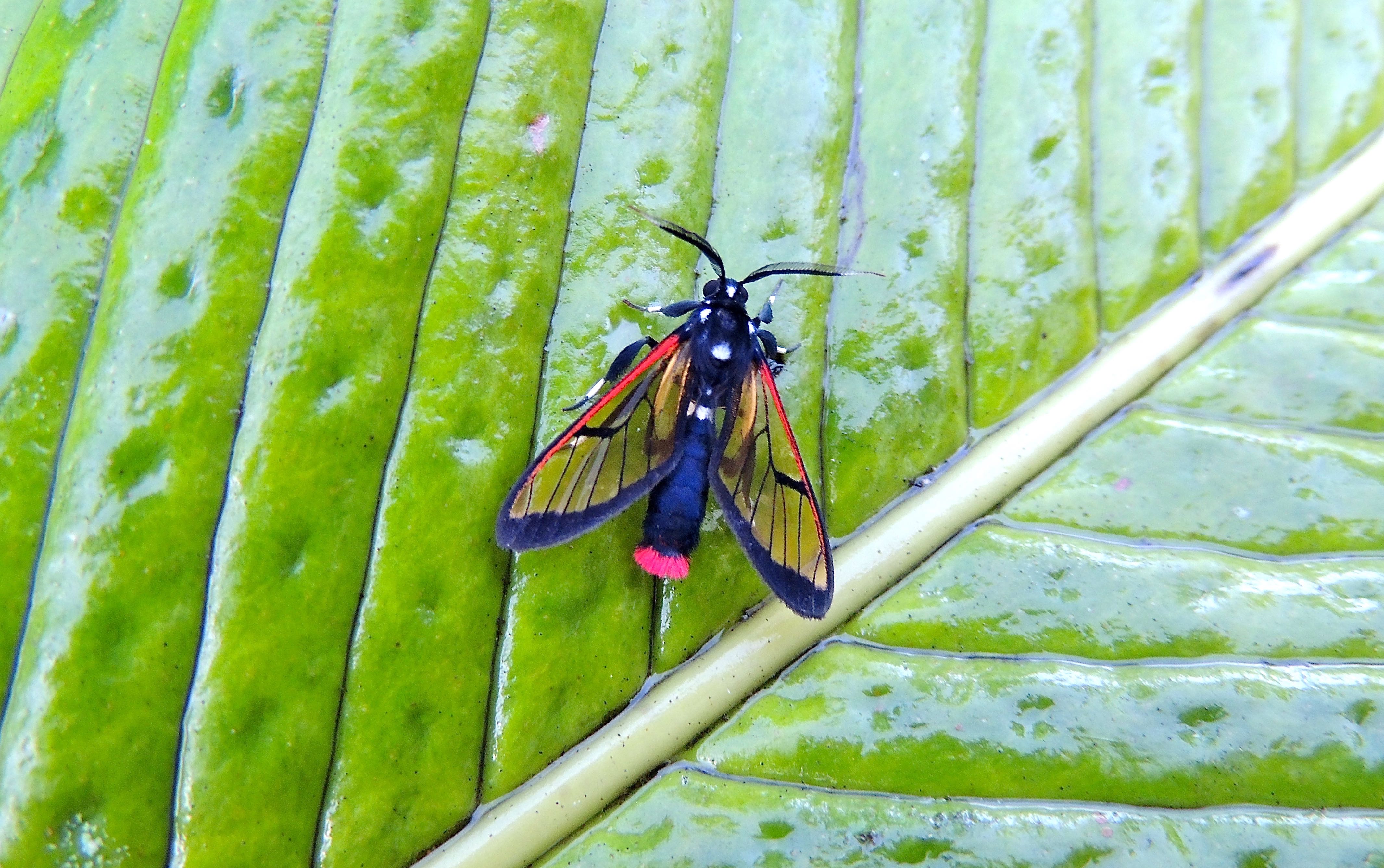 Pseudosphex moza - Photo by William Young
Pseudosphex moza - Photo by William Young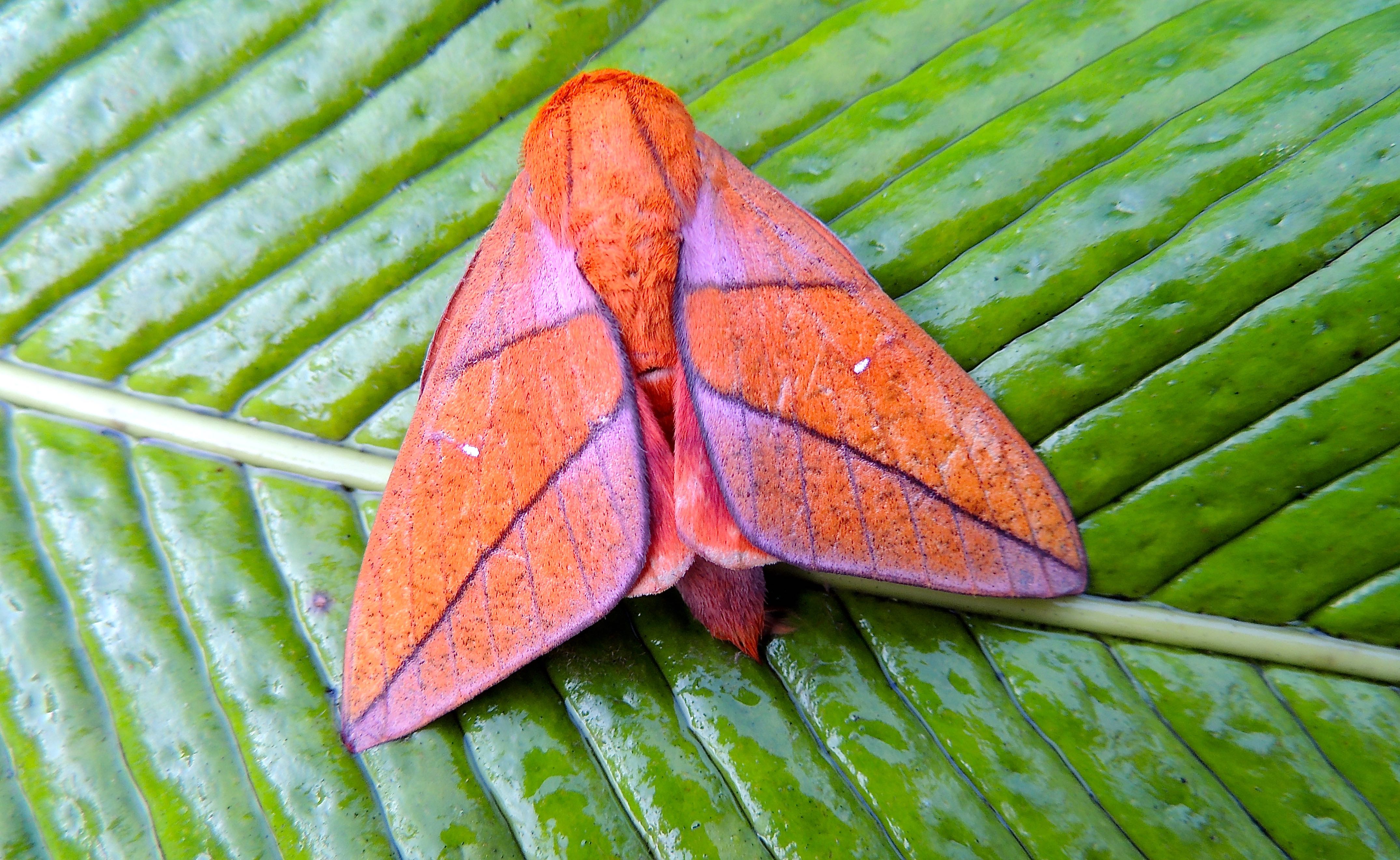 Adeloneivaia jason - Photo by William Young
Adeloneivaia jason - Photo by William Young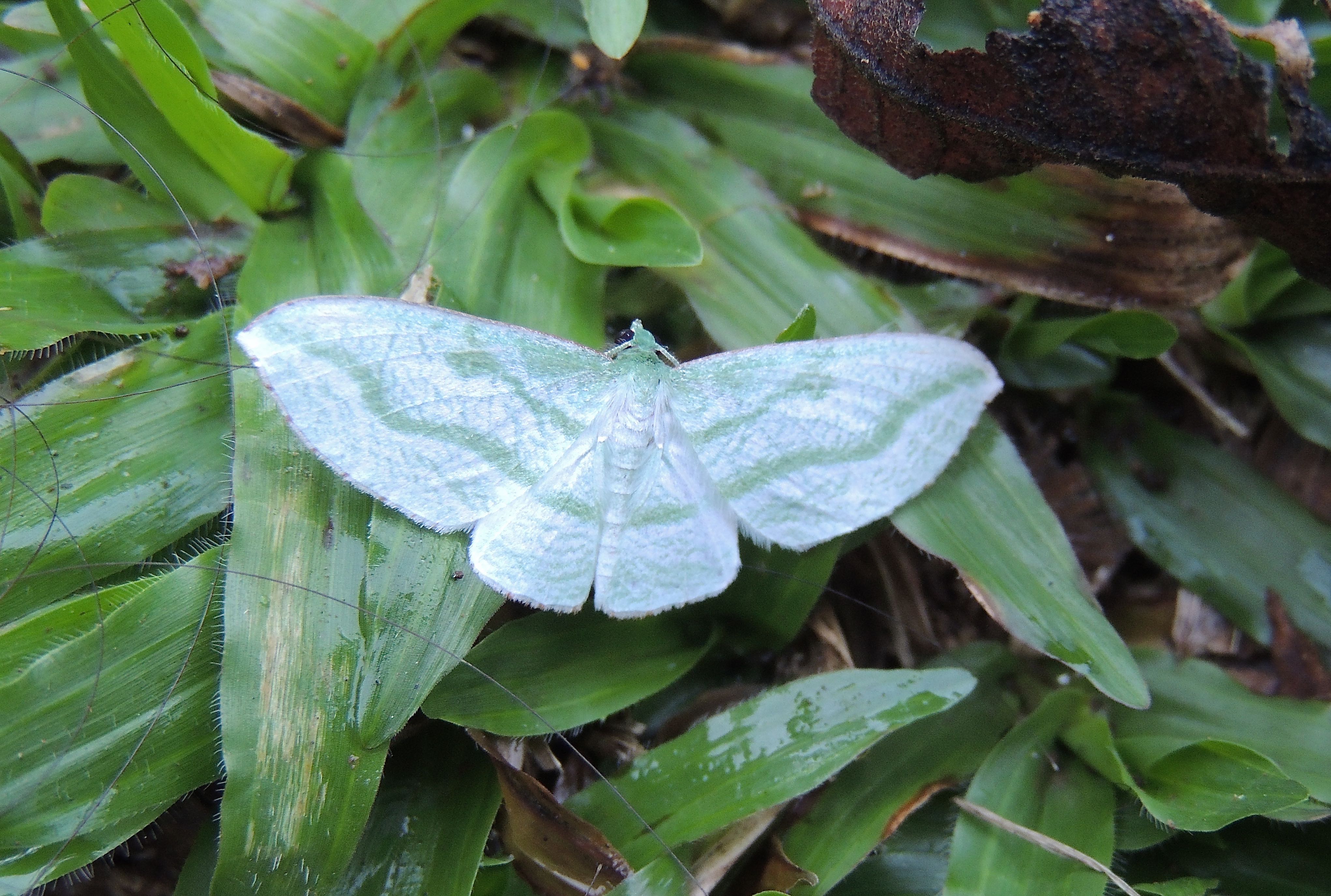 Acrosemia vulpecularia - Photo by William Young
Acrosemia vulpecularia - Photo by William Young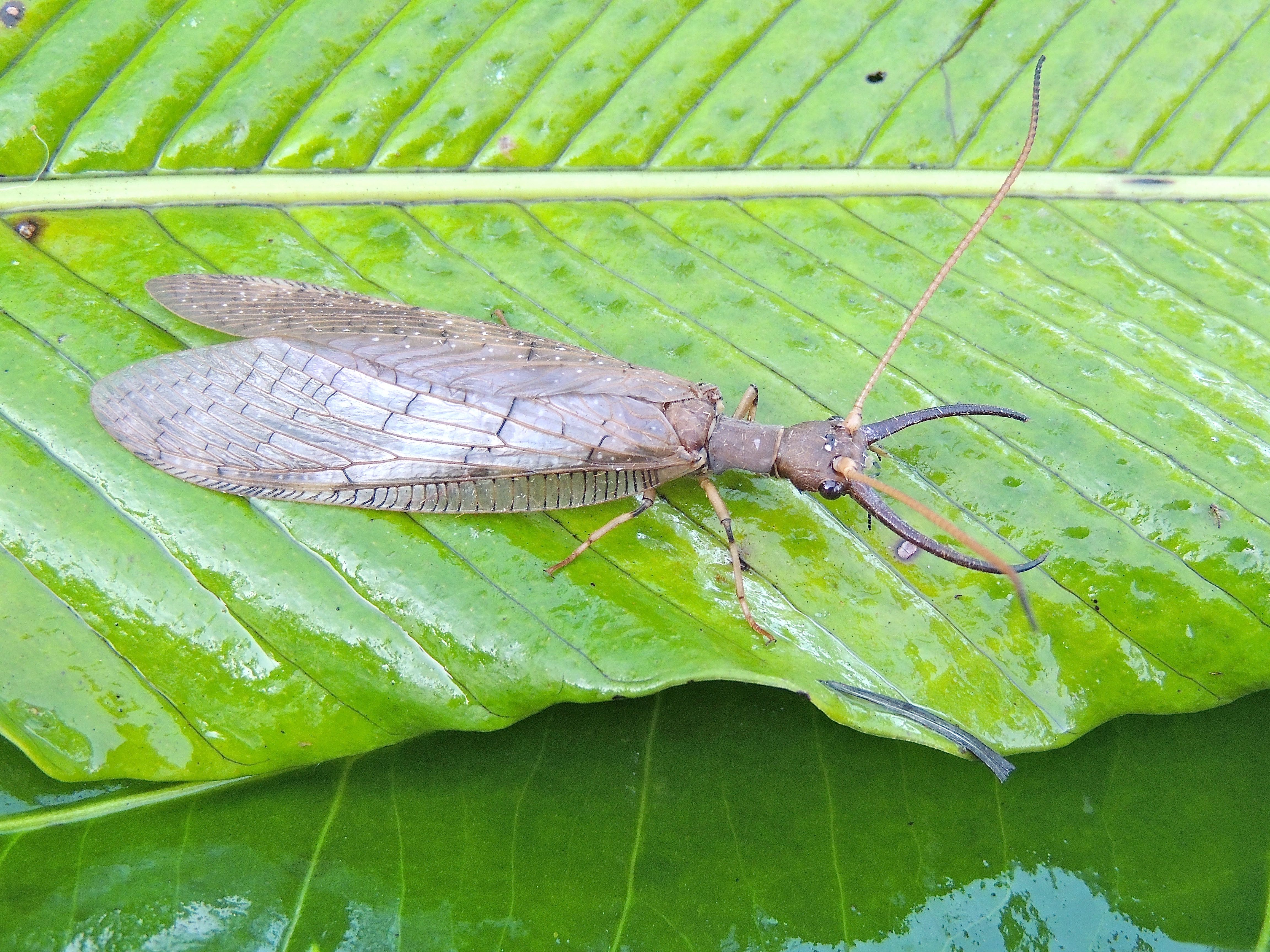 Dobsonfly - Photo by William Young
Dobsonfly - Photo by William Young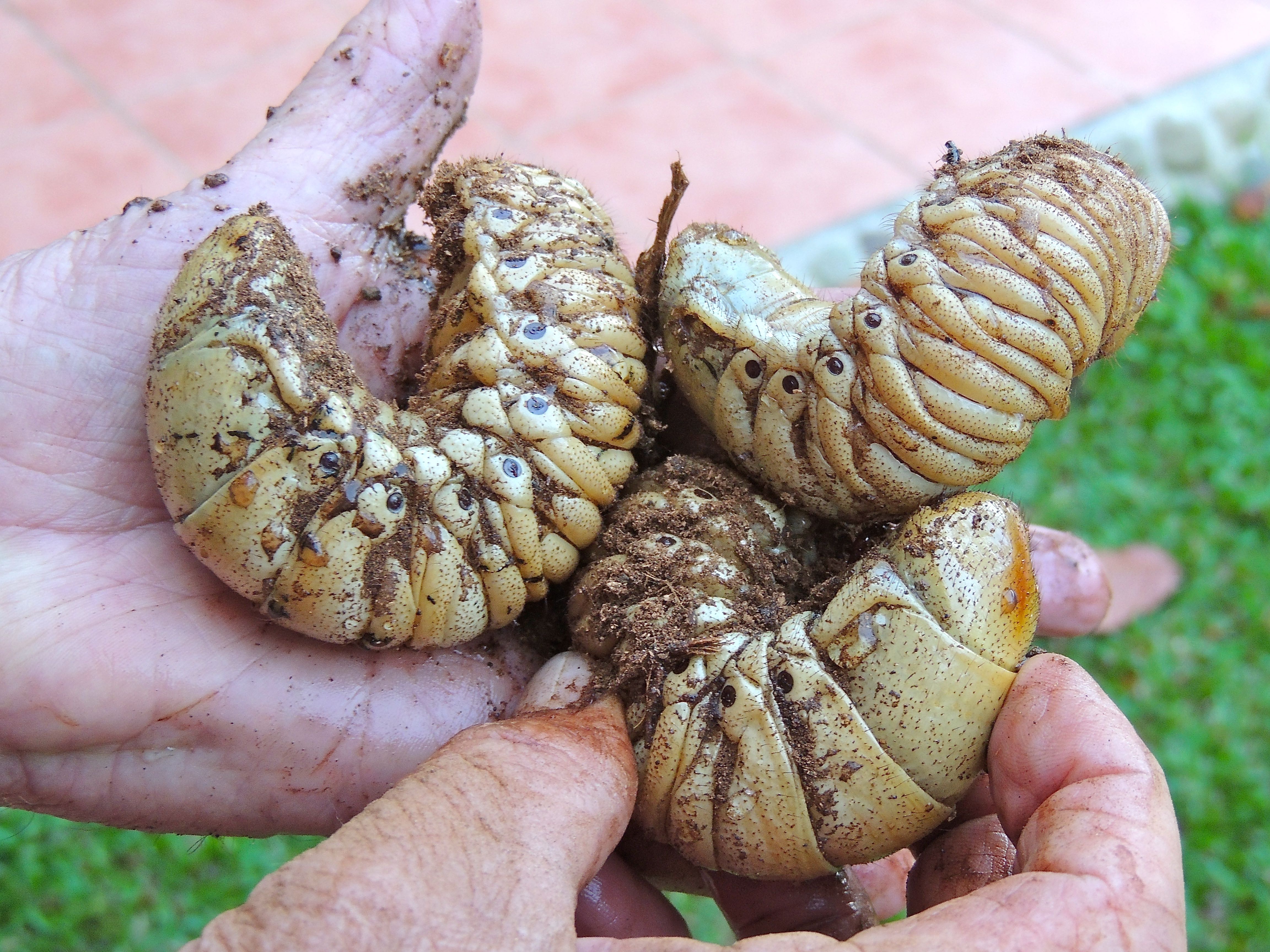 Hercules Beetle larvae - Photo by William Young
Hercules Beetle larvae - Photo by William Young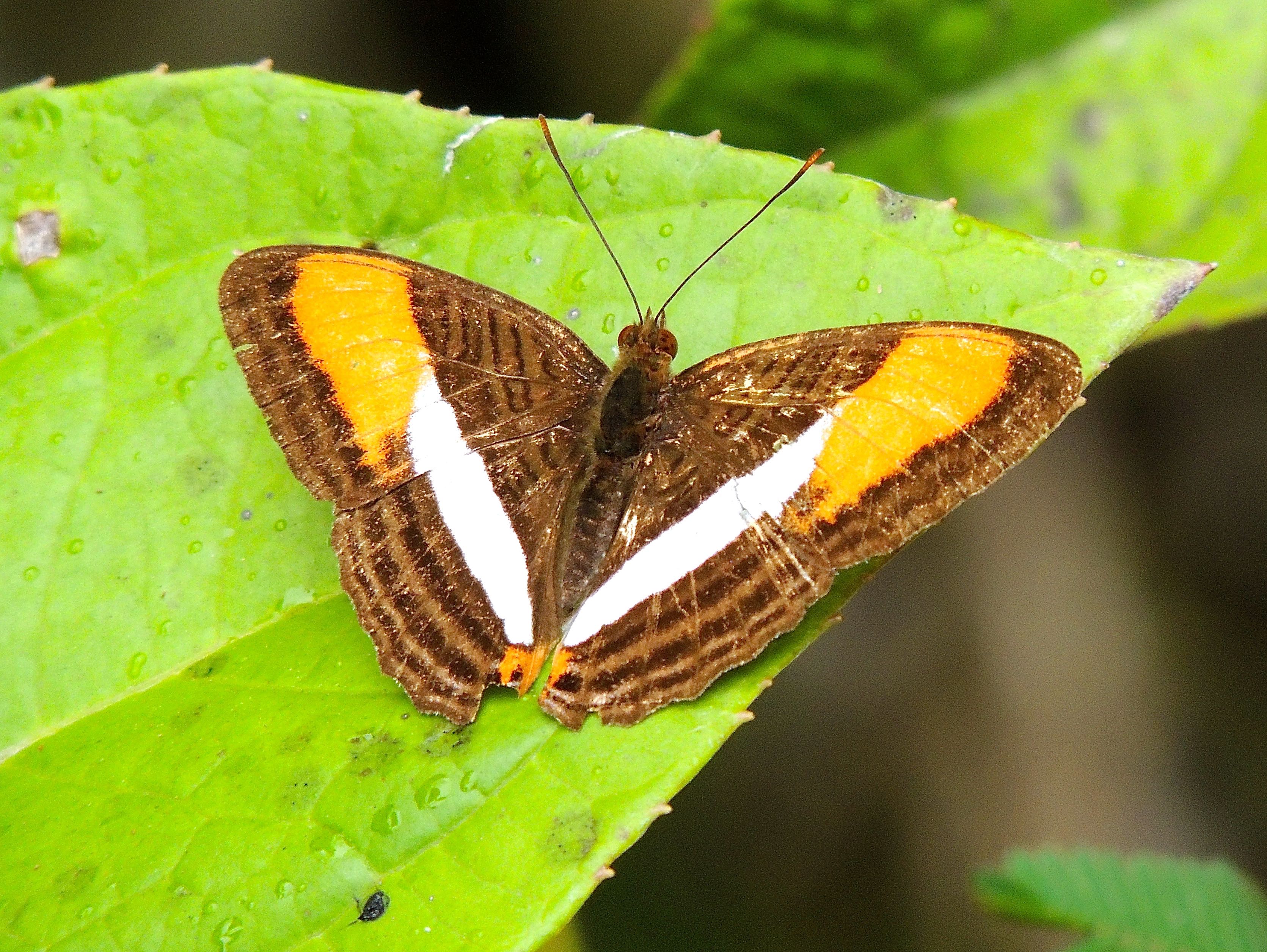 Smooth-banded Sister - Photo by William Young
Smooth-banded Sister - Photo by William Young